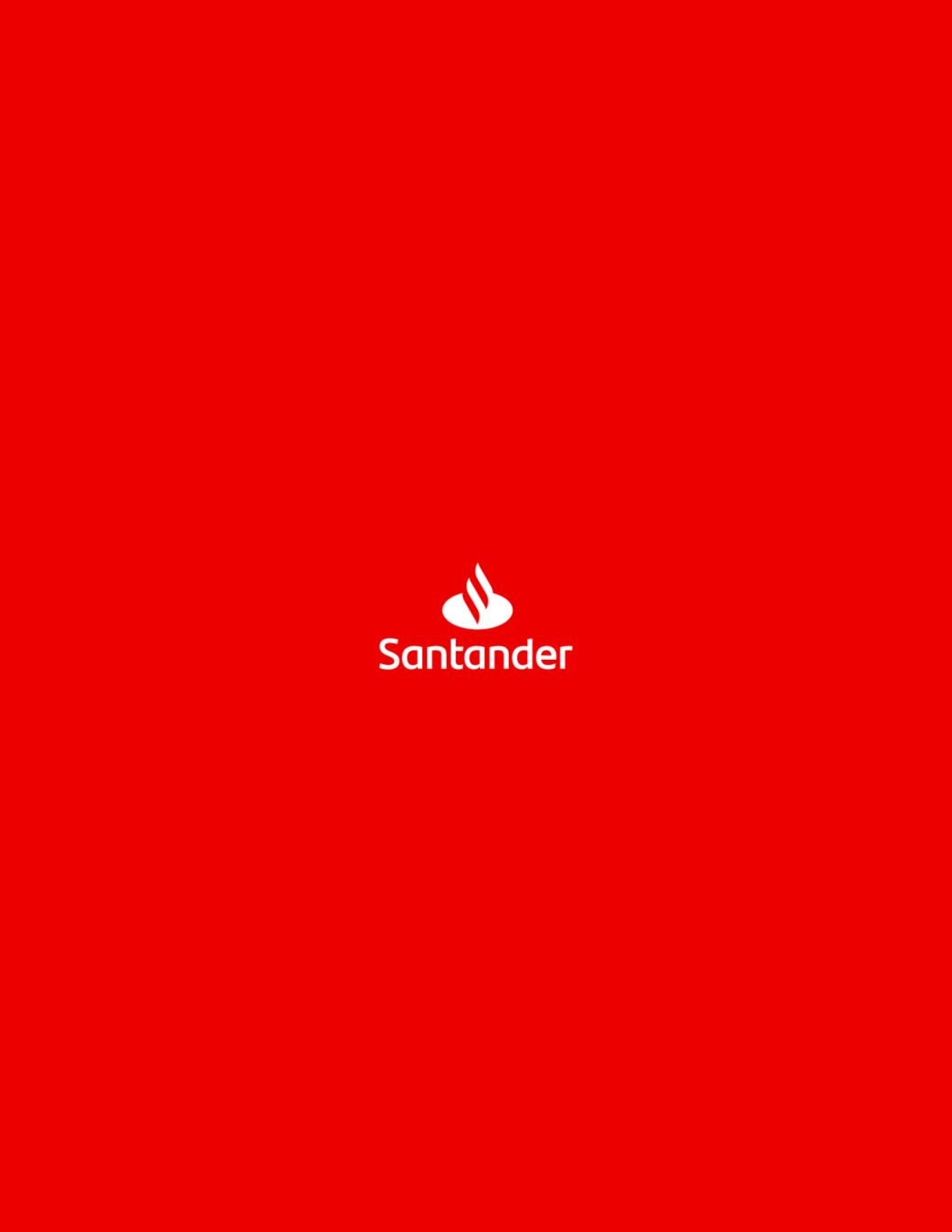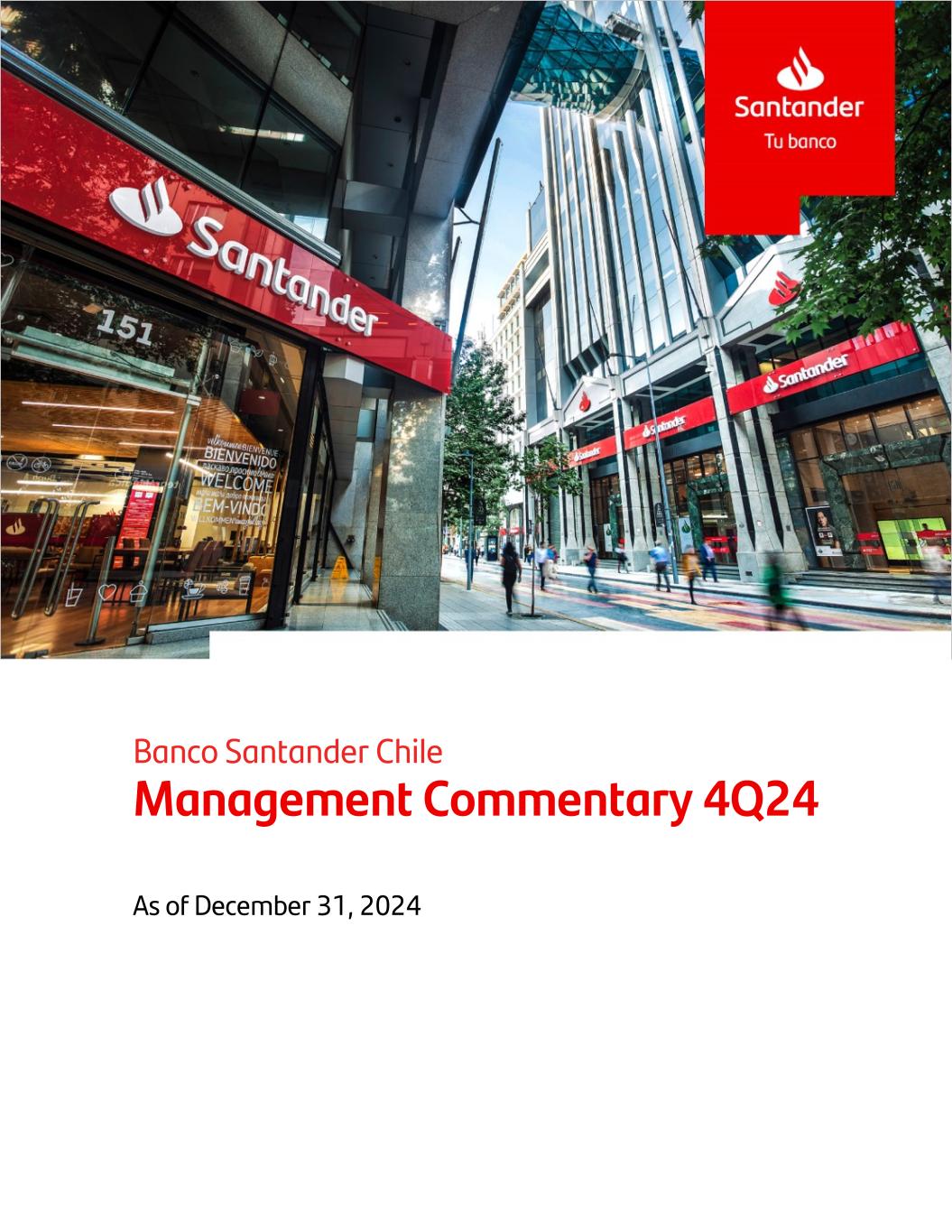
Banco Santander Chile Management Commentary 4Q24 As of December 31, 2024
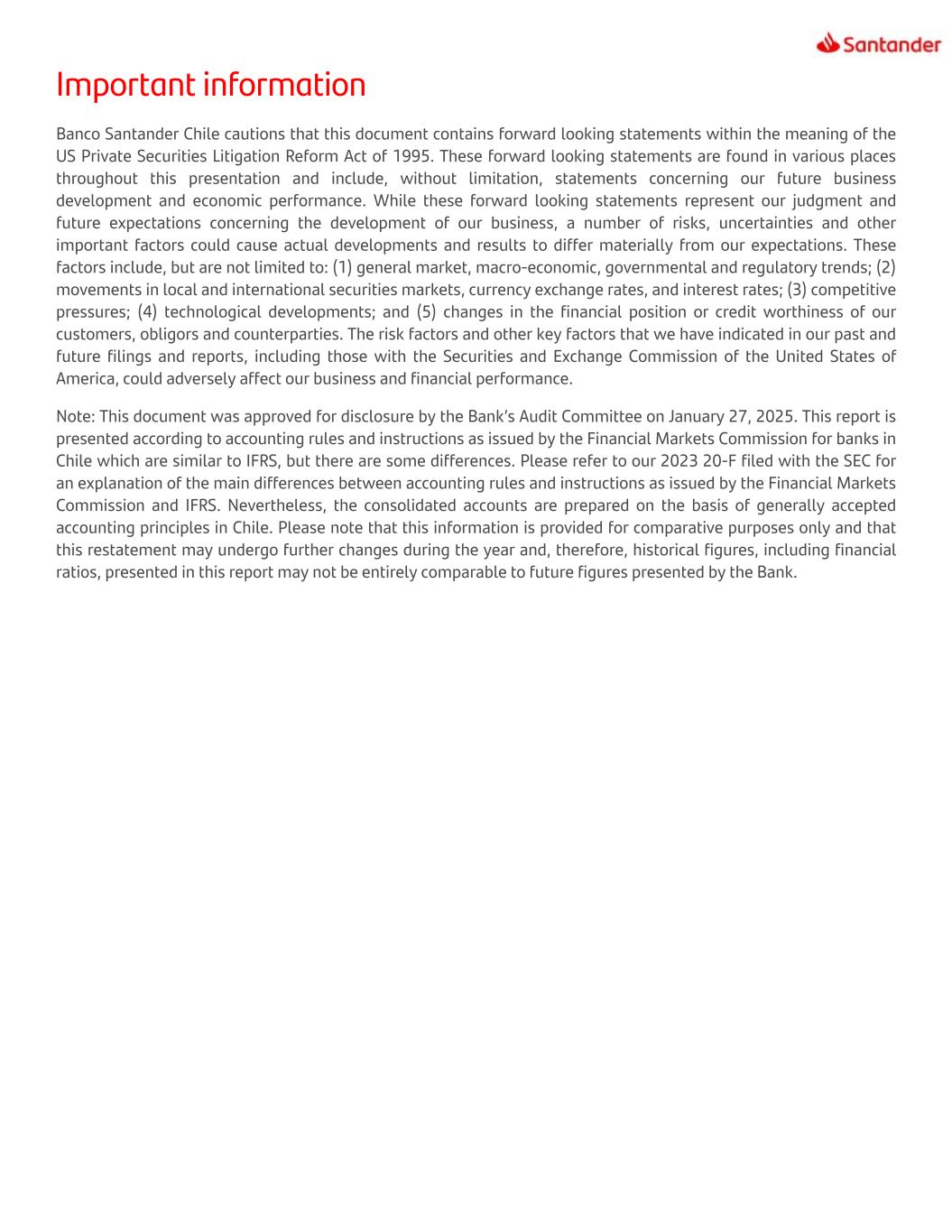
Important information Banco Santander Chile cautions that this document contains forward looking statements within the meaning of the US Private Securities Litigation Reform Act of 1995. These forward looking statements are found in various places throughout this presentation and include, without limitation, statements concerning our future business development and economic performance. While these forward looking statements represent our judgment and future expectations concerning the development of our business, a number of risks, uncertainties and other important factors could cause actual developments and results to differ materially from our expectations. These factors include, but are not limited to: (1) general market, macro-economic, governmental and regulatory trends; (2) movements in local and international securities markets, currency exchange rates, and interest rates; (3) competitive pressures; (4) technological developments; and (5) changes in the financial position or credit worthiness of our customers, obligors and counterparties. The risk factors and other key factors that we have indicated in our past and future filings and reports, including those with the Securities and Exchange Commission of the United States of America, could adversely affect our business and financial performance. Note: This document was approved for disclosure by the Bank’s Audit Committee on January 27, 2025. This report is presented according to accounting rules and instructions as issued by the Financial Markets Commission for banks in Chile which are similar to IFRS, but there are some differences. Please refer to our 2023 20-F filed with the SEC for an explanation of the main differences between accounting rules and instructions as issued by the Financial Markets Commission and IFRS. Nevertheless, the consolidated accounts are prepared on the basis of generally accepted accounting principles in Chile. Please note that this information is provided for comparative purposes only and that this restatement may undergo further changes during the year and, therefore, historical figures, including financial ratios, presented in this report may not be entirely comparable to future figures presented by the Bank.
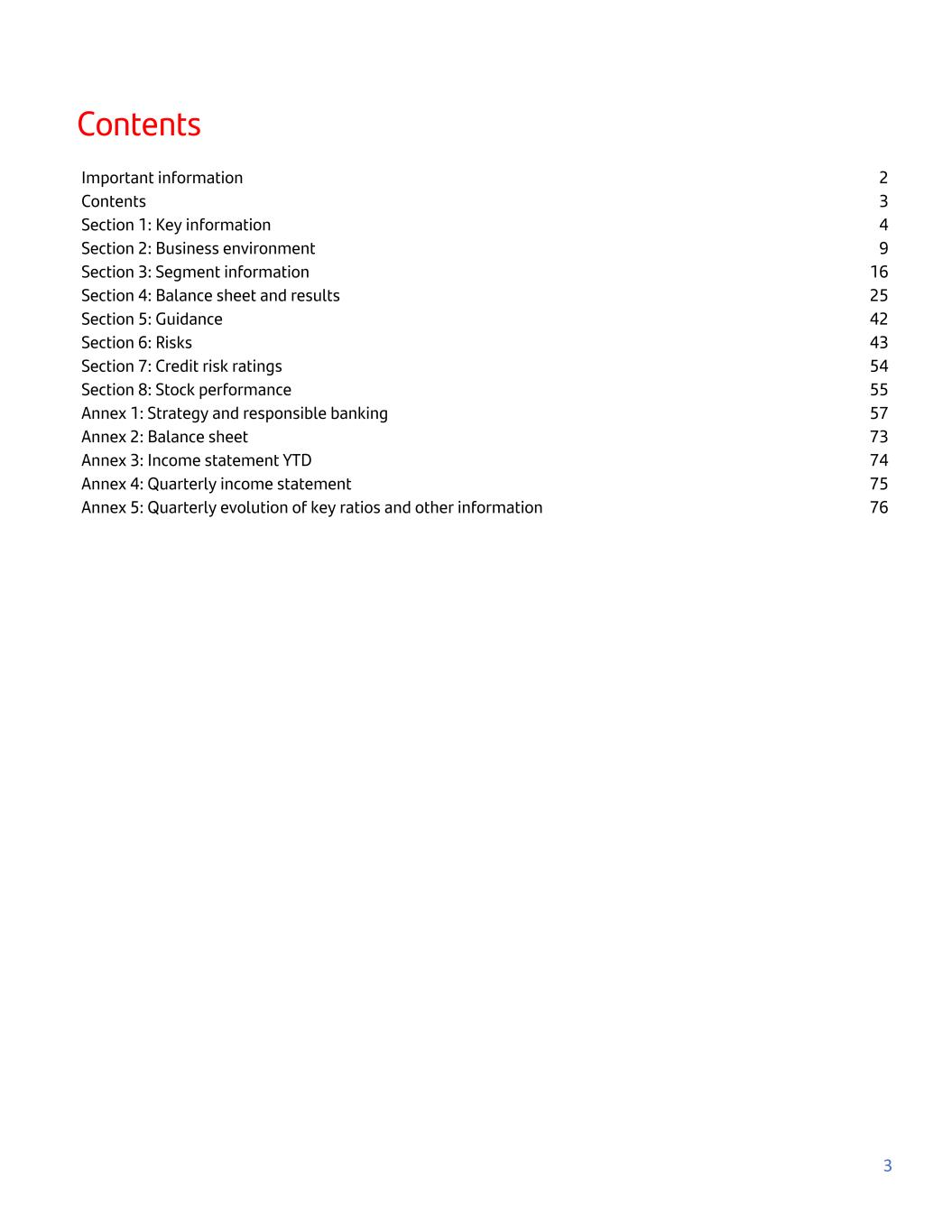
Contents Important information 2 Contents 3 Section 1: Key information 4 Section 2: Business environment 9 Section 3: Segment information 16 Section 4: Balance sheet and results 25 Section 5: Guidance 42 Section 6: Risks 43 Section 7: Credit risk ratings 54 Section 8: Stock performance 55 Annex 1: Strategy and responsible banking 57 Annex 2: Balance sheet 73 Annex 3: Income statement YTD 74 Annex 4: Quarterly income statement 75 Annex 5: Quarterly evolution of key ratios and other information 76 3
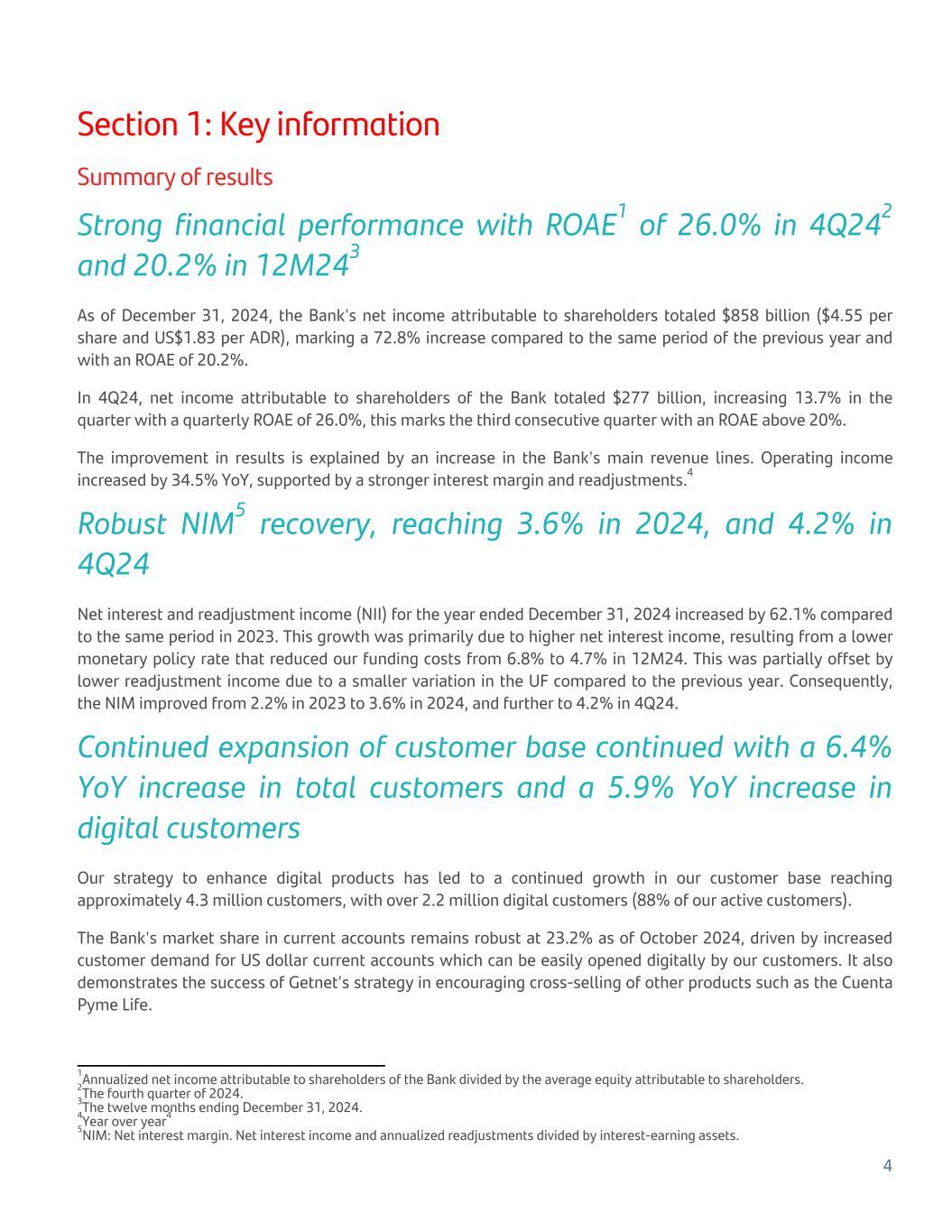
Section 1: Key information Summary of results Strong financial performance with ROAE1 of 26.0% in 4Q242 and 20.2% in 12M243 As of December 31, 2024, the Bank's net income attributable to shareholders totaled $858 billion ($4.55 per share and US$1.83 per ADR), marking a 72.8% increase compared to the same period of the previous year and with an ROAE of 20.2%. In 4Q24, net income attributable to shareholders of the Bank totaled $277 billion, increasing 13.7% in the quarter with a quarterly ROAE of 26.0%, this marks the third consecutive quarter with an ROAE above 20%. The improvement in results is explained by an increase in the Bank's main revenue lines. Operating income increased by 34.5% YoY, supported by a stronger interest margin and readjustments.4 Robust NIM5 recovery, reaching 3.6% in 2024, and 4.2% in 4Q24 Net interest and readjustment income (NII) for the year ended December 31, 2024 increased by 62.1% compared to the same period in 2023. This growth was primarily due to higher net interest income, resulting from a lower monetary policy rate that reduced our funding costs from 6.8% to 4.7% in 12M24. This was partially offset by lower readjustment income due to a smaller variation in the UF compared to the previous year. Consequently, the NIM improved from 2.2% in 2023 to 3.6% in 2024, and further to 4.2% in 4Q24. Continued expansion of customer base continued with a 6.4% YoY increase in total customers and a 5.9% YoY increase in digital customers Our strategy to enhance digital products has led to a continued growth in our customer base reaching approximately 4.3 million customers, with over 2.2 million digital customers (88% of our active customers). The Bank's market share in current accounts remains robust at 23.2% as of October 2024, driven by increased customer demand for US dollar current accounts which can be easily opened digitally by our customers. It also demonstrates the success of Getnet's strategy in encouraging cross-selling of other products such as the Cuenta Pyme Life. 4 1Annualized net income attributable to shareholders of the Bank divided by the average equity attributable to shareholders.2The fourth quarter of 2024.3The twelve months ending December 31, 2024.4Year over year4 5NIM: Net interest margin. Net interest income and annualized readjustments divided by interest-earning assets.
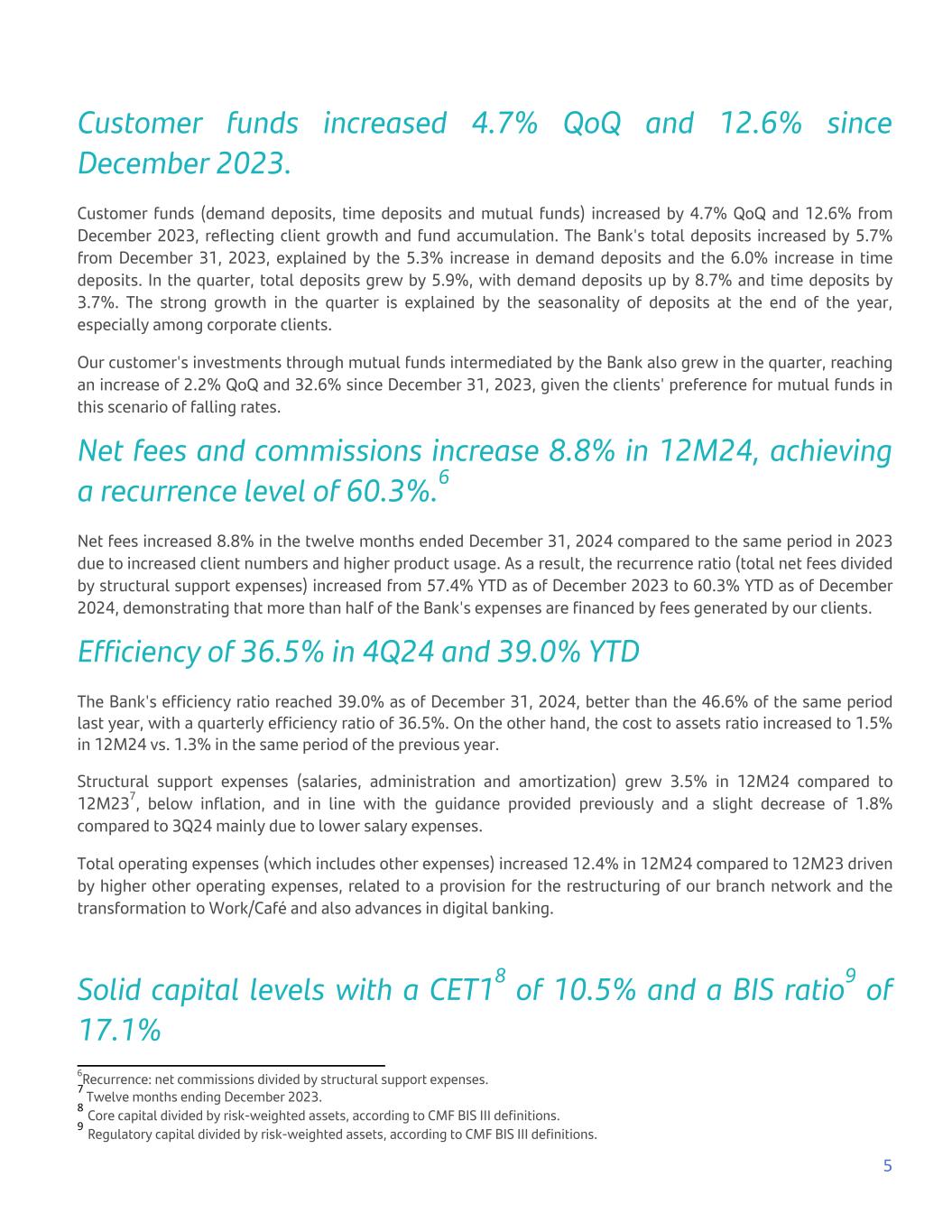
Customer funds increased 4.7% QoQ and 12.6% since December 2023. Customer funds (demand deposits, time deposits and mutual funds) increased by 4.7% QoQ and 12.6% from December 2023, reflecting client growth and fund accumulation. The Bank's total deposits increased by 5.7% from December 31, 2023, explained by the 5.3% increase in demand deposits and the 6.0% increase in time deposits. In the quarter, total deposits grew by 5.9%, with demand deposits up by 8.7% and time deposits by 3.7%. The strong growth in the quarter is explained by the seasonality of deposits at the end of the year, especially among corporate clients. Our customer's investments through mutual funds intermediated by the Bank also grew in the quarter, reaching an increase of 2.2% QoQ and 32.6% since December 31, 2023, given the clients' preference for mutual funds in this scenario of falling rates. Net fees and commissions increase 8.8% in 12M24, achieving a recurrence level of 60.3%.6 Net fees increased 8.8% in the twelve months ended December 31, 2024 compared to the same period in 2023 due to increased client numbers and higher product usage. As a result, the recurrence ratio (total net fees divided by structural support expenses) increased from 57.4% YTD as of December 2023 to 60.3% YTD as of December 2024, demonstrating that more than half of the Bank's expenses are financed by fees generated by our clients. Efficiency of 36.5% in 4Q24 and 39.0% YTD The Bank's efficiency ratio reached 39.0% as of December 31, 2024, better than the 46.6% of the same period last year, with a quarterly efficiency ratio of 36.5%. On the other hand, the cost to assets ratio increased to 1.5% in 12M24 vs. 1.3% in the same period of the previous year. Structural support expenses (salaries, administration and amortization) grew 3.5% in 12M24 compared to 12M237, below inflation, and in line with the guidance provided previously and a slight decrease of 1.8% compared to 3Q24 mainly due to lower salary expenses. Total operating expenses (which includes other expenses) increased 12.4% in 12M24 compared to 12M23 driven by higher other operating expenses, related to a provision for the restructuring of our branch network and the transformation to Work/Café and also advances in digital banking. Solid capital levels with a CET18 of 10.5% and a BIS ratio9 of 17.1% 5 6Recurrence: net commissions divided by structural support expenses. 7 Twelve months ending December 2023. 8 Core capital divided by risk-weighted assets, according to CMF BIS III definitions. 9 Regulatory capital divided by risk-weighted assets, according to CMF BIS III definitions.

Our CET1 (Common Equity Tier 1) ratio remains at solid levels of 10.5% and the total Basel III ratio reaches 17.1% at the end of December 2024, which includes a provision of dividend payment of 70% of 2024 earnings. We made significant progress in our Chile First strategy in 2024 • Largest bank in terms of loans and deposits (16.9% market share according to latest information from the CMF). • More than US$ 450 million committed to invest in infrastructure and technology between 2023 and 2026. • A total of 99 Workcafés in Chile, serving our clients and the community in their different formats. • Recognized by Euromoney as the Best Bank in the Country in the SME and ESG Categories. • The only Chilean bank included in the DJSI emerging markets and within the top 3% of the most sustainable banks in the world. • Top Employer Certification January 2025 (seventh consecutive year). • Recognized as the Best Bank in Chile for SMEs by Global Finance. • ALAS20: First place in the category of leading company in sustainability. • Institutional Investor: "Most Honored Company." 6
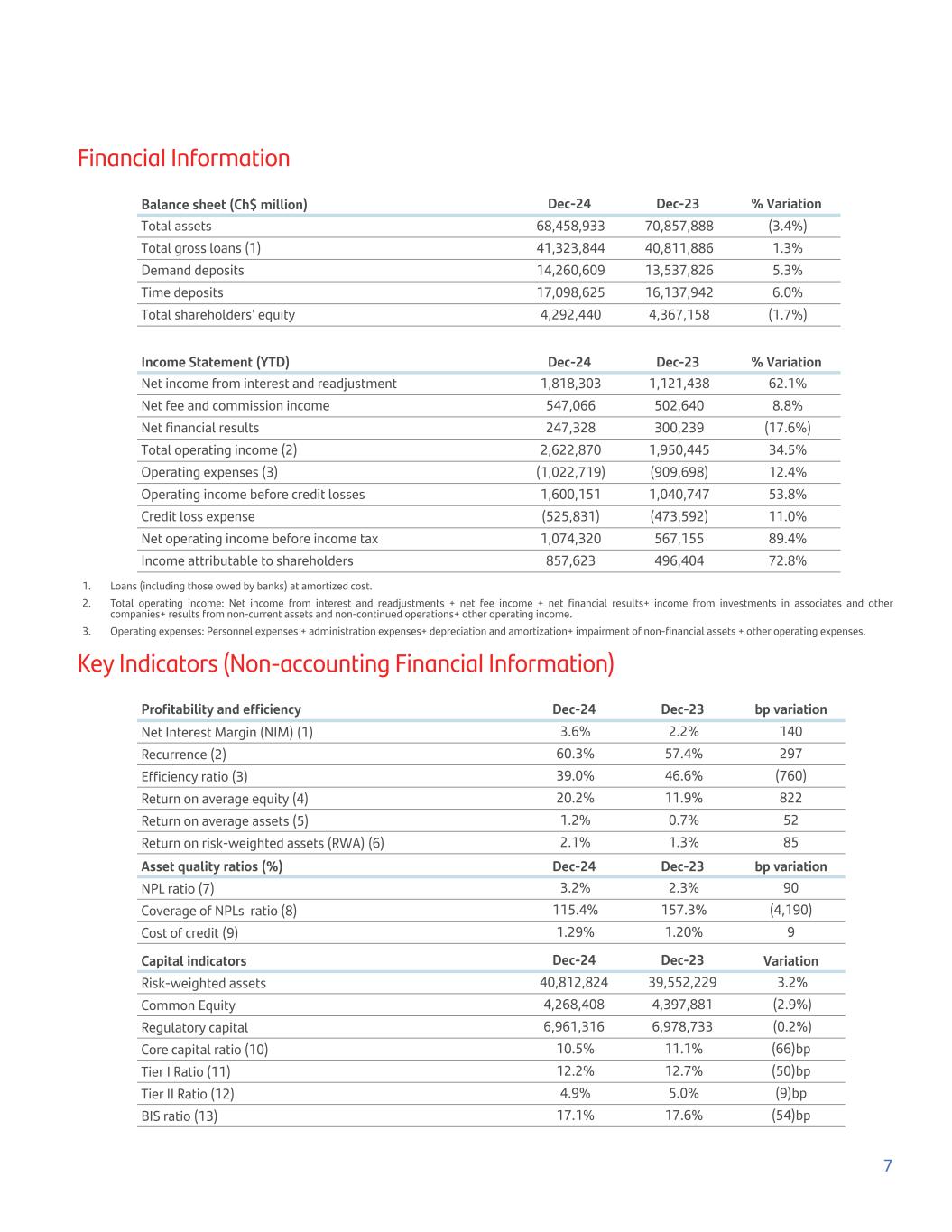
Financial Information Balance sheet (Ch$ million) Dec-24 Dec-23 % Variation Total assets 68,458,933 70,857,888 (3.4%) Total gross loans (1) 41,323,844 40,811,886 1.3% Demand deposits 14,260,609 13,537,826 5.3% Time deposits 17,098,625 16,137,942 6.0% Total shareholders' equity 4,292,440 4,367,158 (1.7%) Income Statement (YTD) Dec-24 Dec-23 % Variation Net income from interest and readjustment 1,818,303 1,121,438 62.1% Net fee and commission income 547,066 502,640 8.8% Net financial results 247,328 300,239 (17.6%) Total operating income (2) 2,622,870 1,950,445 34.5% Operating expenses (3) (1,022,719) (909,698) 12.4% Operating income before credit losses 1,600,151 1,040,747 53.8% Credit loss expense (525,831) (473,592) 11.0% Net operating income before income tax 1,074,320 567,155 89.4% Income attributable to shareholders 857,623 496,404 72.8% 1. Loans (including those owed by banks) at amortized cost. 2. Total operating income: Net income from interest and readjustments + net fee income + net financial results+ income from investments in associates and other companies+ results from non-current assets and non-continued operations+ other operating income. 3. Operating expenses: Personnel expenses + administration expenses+ depreciation and amortization+ impairment of non-financial assets + other operating expenses. Key Indicators (Non-accounting Financial Information) Profitability and efficiency Dec-24 Dec-23 bp variation Net Interest Margin (NIM) (1) 3.6% 2.2% 140 Recurrence (2) 60.3% 57.4% 297 Efficiency ratio (3) 39.0% 46.6% (760) Return on average equity (4) 20.2% 11.9% 822 Return on average assets (5) 1.2% 0.7% 52 Return on risk-weighted assets (RWA) (6) 2.1% 1.3% 85 Asset quality ratios (%) Dec-24 Dec-23 bp variation NPL ratio (7) 3.2% 2.3% 90 Coverage of NPLs ratio (8) 115.4% 157.3% (4,190) Cost of credit (9) 1.29% 1.20% 9 Capital indicators Dec-24 Dec-23 Variation Risk-weighted assets 40,812,824 39,552,229 3.2% Common Equity 4,268,408 4,397,881 (2.9%) Regulatory capital 6,961,316 6,978,733 (0.2%) Core capital ratio (10) 10.5% 11.1% (66)bp Tier I Ratio (11) 12.2% 12.7% (50)bp Tier II Ratio (12) 4.9% 5.0% (9)bp BIS ratio (13) 17.1% 17.6% (54)bp 7
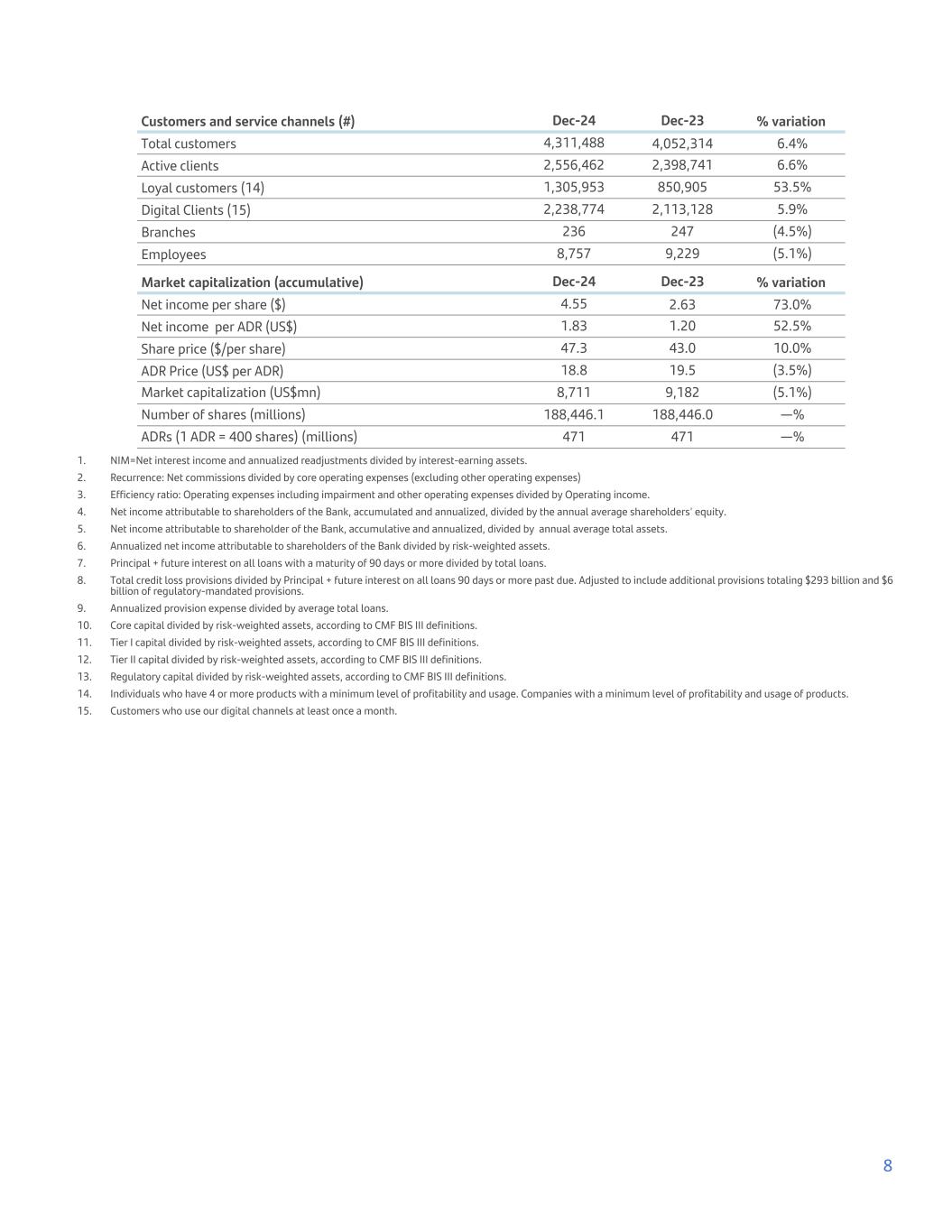
Customers and service channels (#) Dec-24 Dec-23 % variation Total customers 4,311,488 4,052,314 6.4% Active clients 2,556,462 2,398,741 6.6% Loyal customers (14) 1,305,953 850,905 53.5% Digital Clients (15) 2,238,774 2,113,128 5.9% Branches 236 247 (4.5%) Employees 8,757 9,229 (5.1%) Market capitalization (accumulative) Dec-24 Dec-23 % variation Net income per share ($) 4.55 2.63 73.0% Net income per ADR (US$) 1.83 1.20 52.5% Share price ($/per share) 47.3 43.0 10.0% ADR Price (US$ per ADR) 18.8 19.5 (3.5%) Market capitalization (US$mn) 8,711 9,182 (5.1%) Number of shares (millions) 188,446.1 188,446.0 —% ADRs (1 ADR = 400 shares) (millions) 471 471 —% 1. NIM=Net interest income and annualized readjustments divided by interest-earning assets. 2. Recurrence: Net commissions divided by core operating expenses (excluding other operating expenses) 3. Efficiency ratio: Operating expenses including impairment and other operating expenses divided by Operating income. 4. Net income attributable to shareholders of the Bank, accumulated and annualized, divided by the annual average shareholders' equity. 5. Net income attributable to shareholder of the Bank, accumulative and annualized, divided by annual average total assets. 6. Annualized net income attributable to shareholders of the Bank divided by risk-weighted assets. 7. Principal + future interest on all loans with a maturity of 90 days or more divided by total loans. 8. Total credit loss provisions divided by Principal + future interest on all loans 90 days or more past due. Adjusted to include additional provisions totaling $293 billion and $6 billion of regulatory-mandated provisions. 9. Annualized provision expense divided by average total loans. 10. Core capital divided by risk-weighted assets, according to CMF BIS III definitions. 11. Tier I capital divided by risk-weighted assets, according to CMF BIS III definitions. 12. Tier II capital divided by risk-weighted assets, according to CMF BIS III definitions. 13. Regulatory capital divided by risk-weighted assets, according to CMF BIS III definitions. 14. Individuals who have 4 or more products with a minimum level of profitability and usage. Companies with a minimum level of profitability and usage of products. 15. Customers who use our digital channels at least once a month. 8
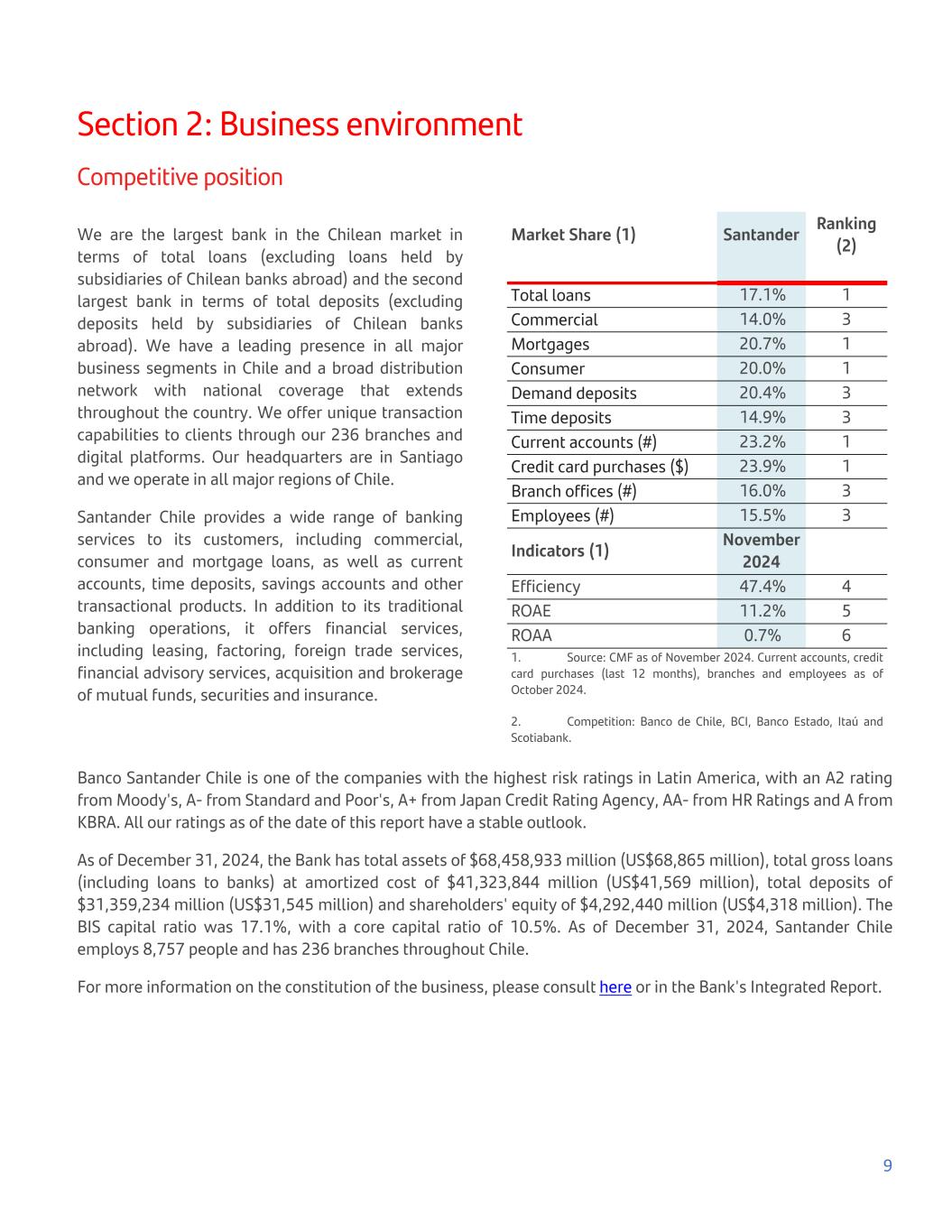
Section 2: Business environment Competitive position We are the largest bank in the Chilean market in terms of total loans (excluding loans held by subsidiaries of Chilean banks abroad) and the second largest bank in terms of total deposits (excluding deposits held by subsidiaries of Chilean banks abroad). We have a leading presence in all major business segments in Chile and a broad distribution network with national coverage that extends throughout the country. We offer unique transaction capabilities to clients through our 236 branches and digital platforms. Our headquarters are in Santiago and we operate in all major regions of Chile. Santander Chile provides a wide range of banking services to its customers, including commercial, consumer and mortgage loans, as well as current accounts, time deposits, savings accounts and other transactional products. In addition to its traditional banking operations, it offers financial services, including leasing, factoring, foreign trade services, financial advisory services, acquisition and brokerage of mutual funds, securities and insurance. Market Share (1) Santander Ranking (2) Total loans 17.1% 1 Commercial 14.0% 3 Mortgages 20.7% 1 Consumer 20.0% 1 Demand deposits 20.4% 3 Time deposits 14.9% 3 Current accounts (#) 23.2% 1 Credit card purchases ($) 23.9% 1 Branch offices (#) 16.0% 3 Employees (#) 15.5% 3 Indicators (1) November 2024 Efficiency 47.4% 4 ROAE 11.2% 5 ROAA 0.7% 6 1. Source: CMF as of November 2024. Current accounts, credit card purchases (last 12 months), branches and employees as of October 2024. 2. Competition: Banco de Chile, BCI, Banco Estado, Itaú and Scotiabank. Banco Santander Chile is one of the companies with the highest risk ratings in Latin America, with an A2 rating from Moody's, A- from Standard and Poor's, A+ from Japan Credit Rating Agency, AA- from HR Ratings and A from KBRA. All our ratings as of the date of this report have a stable outlook. As of December 31, 2024, the Bank has total assets of $68,458,933 million (US$68,865 million), total gross loans (including loans to banks) at amortized cost of $41,323,844 million (US$41,569 million), total deposits of $31,359,234 million (US$31,545 million) and shareholders' equity of $4,292,440 million (US$4,318 million). The BIS capital ratio was 17.1%, with a core capital ratio of 10.5%. As of December 31, 2024, Santander Chile employs 8,757 people and has 236 branches throughout Chile. For more information on the constitution of the business, please consult here or in the Bank's Integrated Report. 9
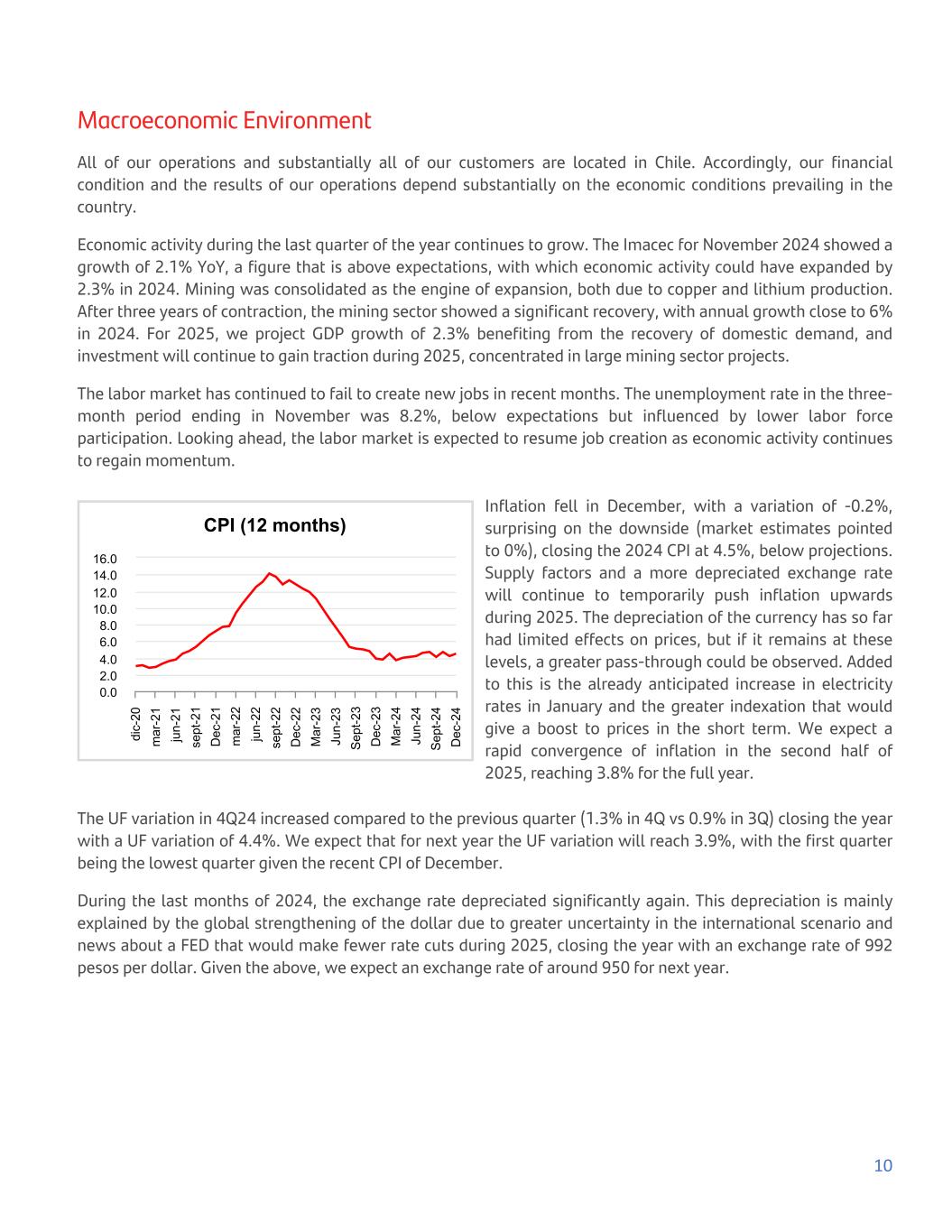
Macroeconomic Environment All of our operations and substantially all of our customers are located in Chile. Accordingly, our financial condition and the results of our operations depend substantially on the economic conditions prevailing in the country. Economic activity during the last quarter of the year continues to grow. The Imacec for November 2024 showed a growth of 2.1% YoY, a figure that is above expectations, with which economic activity could have expanded by 2.3% in 2024. Mining was consolidated as the engine of expansion, both due to copper and lithium production. After three years of contraction, the mining sector showed a significant recovery, with annual growth close to 6% in 2024. For 2025, we project GDP growth of 2.3% benefiting from the recovery of domestic demand, and investment will continue to gain traction during 2025, concentrated in large mining sector projects. The labor market has continued to fail to create new jobs in recent months. The unemployment rate in the three- month period ending in November was 8.2%, below expectations but influenced by lower labor force participation. Looking ahead, the labor market is expected to resume job creation as economic activity continues to regain momentum. CPI (12 months) di c- 20 m ar -2 1 ju n- 21 se pt -2 1 D ec -2 1 m ar -2 2 ju n- 22 se pt -2 2 D ec -2 2 M ar -2 3 Ju n- 23 S ep t-2 3 D ec -2 3 M ar -2 4 Ju n- 24 S ep t-2 4 D ec -2 4 0.0 2.0 4.0 6.0 8.0 10.0 12.0 14.0 16.0 Inflation fell in December, with a variation of -0.2%, surprising on the downside (market estimates pointed to 0%), closing the 2024 CPI at 4.5%, below projections. Supply factors and a more depreciated exchange rate will continue to temporarily push inflation upwards during 2025. The depreciation of the currency has so far had limited effects on prices, but if it remains at these levels, a greater pass-through could be observed. Added to this is the already anticipated increase in electricity rates in January and the greater indexation that would give a boost to prices in the short term. We expect a rapid convergence of inflation in the second half of 2025, reaching 3.8% for the full year. The UF variation in 4Q24 increased compared to the previous quarter (1.3% in 4Q vs 0.9% in 3Q) closing the year with a UF variation of 4.4%. We expect that for next year the UF variation will reach 3.9%, with the first quarter being the lowest quarter given the recent CPI of December. During the last months of 2024, the exchange rate depreciated significantly again. This depreciation is mainly explained by the global strengthening of the dollar due to greater uncertainty in the international scenario and news about a FED that would make fewer rate cuts during 2025, closing the year with an exchange rate of 992 pesos per dollar. Given the above, we expect an exchange rate of around 950 for next year. 10

MPR D ec -2 02 2 Fe b- 20 23 M ar -2 02 3 A pr -2 02 3 M ay -2 02 3 Ju n- 20 23 Ju l-2 02 3 A ug -2 02 3 S ep -2 02 3 O ct -2 02 3 N ov -2 02 3 D ec -2 02 3 Ja n- 20 24 Fe b- 20 24 M ar -2 02 4 A pr -2 02 4 M ay -2 02 4 Ju n- 20 24 Ju l-2 02 4 A ug -2 02 4 S ep -2 02 4 O ct -2 02 4 N ov -2 02 4 D ec -2 02 4 0.0 2.0 4.0 6.0 8.0 10.0 12.0 The Central Bank began the rate cut process in July 2023 and continued with this trend in its subsequent meetings, closing 2023 at 8.25%. During 2024, the cuts have persisted, although more gradually. At the last meeting of the year in December, the Central Bank cut the rate by 25bp, to 5.0%, highlighting that the external sector remains the main source of identified risks. It also projects that the FED will continue with two rate cuts in 2025, leaving a narrower outlook. With this, we estimate that the Central Bank will continue implementing more cuts next year, to reach a neutral rate of 4.25% at the end of 2025. In the last meeting of the central bank in January, they maintained the MPR at 5.00%. Summary of estimated economic data: 2021 2022 2023 2024 (E) 2025 (E) National accounts GDP (real change % YoY) 11.7% 2.4% 0.2% 2.3% 2.3% Internal demand (real change % y/y) 21.7% 2.3% -4.2% 1.2% 2.7% Total consumption (actual change % y/y) 19.3% 3.1% -3.9% 1.6% 2.2% Private consumption (real change % YoY) 20.8% 2.9% -5.2% 1.1% 2.0% Public consumption (real change % y/y) 13.8% 4.1% 1.7% 3.4% 3.1% Gross fixed capital formation (real change % YoY) 15.7% 2.8% -1.1% -0.9% 5.1% Exports (real change % YoY) -1.4% 1.4% -0.3% 5.3% 3.8% Imports (real change % YoY) 31.8% 0.9% -12.0% 1.6% 5.3% Monetary and Foreign Exchange Market CPI inflation 7.2% 12.6% 3.9% 4.5% 3.8% UF inflation 6.6% 13.3% 4.8% 4.4% 3.9% CLP/US$ exchange rate (end of year) 852 875 879 992 950 Monetary policy rate (end of year) 4.0% 11.25% 8.25% 5.0% 4.25% Fiscal Policy Public expenditure 31.6% -24.0% 1.0% 3.5% 3.0% Central Government Balance (% GDP) -7.7% 1.3% -2.4% -2.7% -2.3% Estimates from the Research Department of Banco Santander Chile. 11
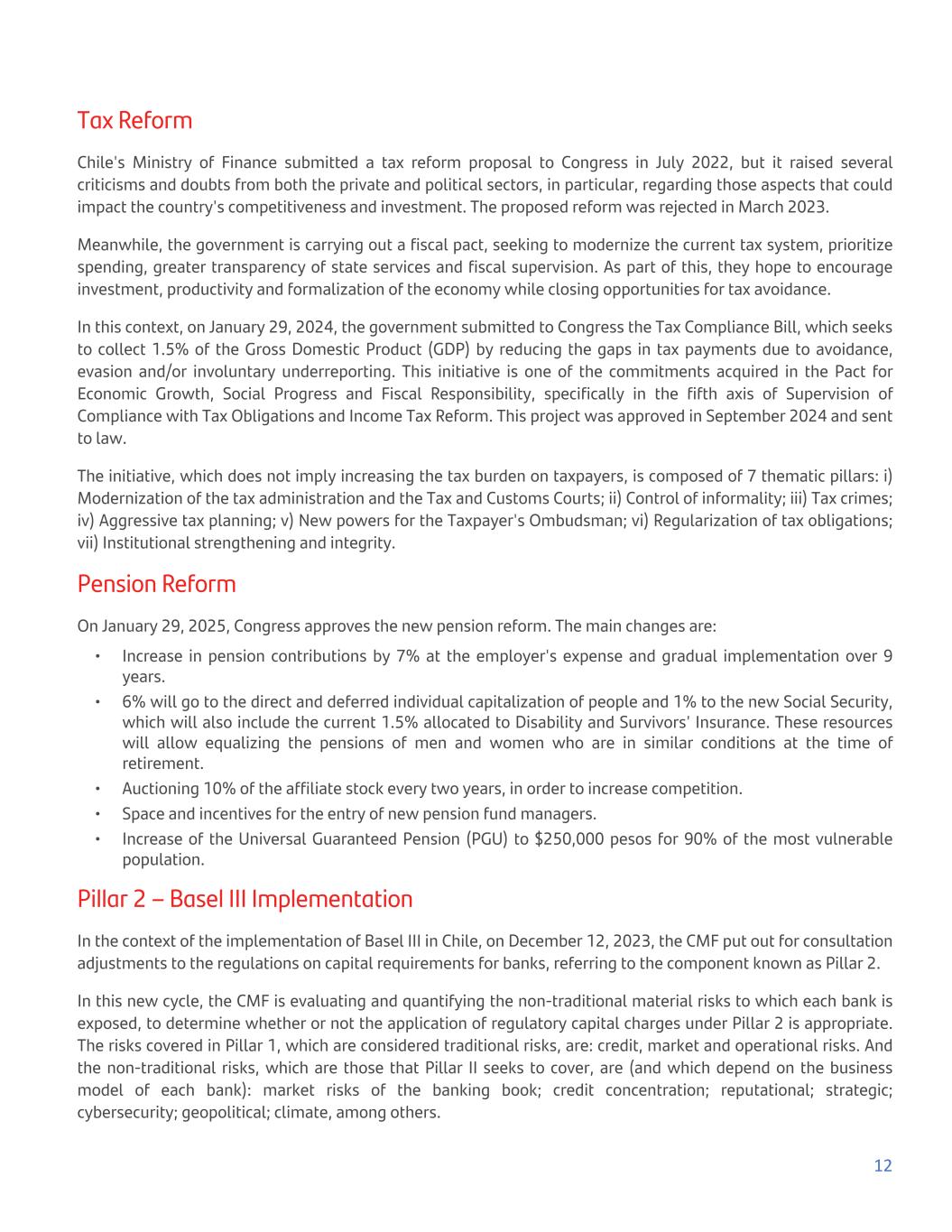
Tax Reform Chile's Ministry of Finance submitted a tax reform proposal to Congress in July 2022, but it raised several criticisms and doubts from both the private and political sectors, in particular, regarding those aspects that could impact the country's competitiveness and investment. The proposed reform was rejected in March 2023. Meanwhile, the government is carrying out a fiscal pact, seeking to modernize the current tax system, prioritize spending, greater transparency of state services and fiscal supervision. As part of this, they hope to encourage investment, productivity and formalization of the economy while closing opportunities for tax avoidance. In this context, on January 29, 2024, the government submitted to Congress the Tax Compliance Bill, which seeks to collect 1.5% of the Gross Domestic Product (GDP) by reducing the gaps in tax payments due to avoidance, evasion and/or involuntary underreporting. This initiative is one of the commitments acquired in the Pact for Economic Growth, Social Progress and Fiscal Responsibility, specifically in the fifth axis of Supervision of Compliance with Tax Obligations and Income Tax Reform. This project was approved in September 2024 and sent to law. The initiative, which does not imply increasing the tax burden on taxpayers, is composed of 7 thematic pillars: i) Modernization of the tax administration and the Tax and Customs Courts; ii) Control of informality; iii) Tax crimes; iv) Aggressive tax planning; v) New powers for the Taxpayer's Ombudsman; vi) Regularization of tax obligations; vii) Institutional strengthening and integrity. Pension Reform On January 29, 2025, Congress approves the new pension reform. The main changes are: • Increase in pension contributions by 7% at the employer's expense and gradual implementation over 9 years. • 6% will go to the direct and deferred individual capitalization of people and 1% to the new Social Security, which will also include the current 1.5% allocated to Disability and Survivors' Insurance. These resources will allow equalizing the pensions of men and women who are in similar conditions at the time of retirement. • Auctioning 10% of the affiliate stock every two years, in order to increase competition. • Space and incentives for the entry of new pension fund managers. • Increase of the Universal Guaranteed Pension (PGU) to $250,000 pesos for 90% of the most vulnerable population. Pillar 2 – Basel III Implementation In the context of the implementation of Basel III in Chile, on December 12, 2023, the CMF put out for consultation adjustments to the regulations on capital requirements for banks, referring to the component known as Pillar 2. In this new cycle, the CMF is evaluating and quantifying the non-traditional material risks to which each bank is exposed, to determine whether or not the application of regulatory capital charges under Pillar 2 is appropriate. The risks covered in Pillar 1, which are considered traditional risks, are: credit, market and operational risks. And the non-traditional risks, which are those that Pillar II seeks to cover, are (and which depend on the business model of each bank): market risks of the banking book; credit concentration; reputational; strategic; cybersecurity; geopolitical; climate, among others. 12

On October 11, 2024, the CMF published a new version for consultation of the regulations on capital requirements for pillar 2. This new proposal considers that part of the changes will come into effect as of May 2025 and the remaining changes for the IAPE of 2026. Subsequently, on January 17, 2025, the CMF applied for the second time the current regulations on additional asset requirements according to Pillar II, where the Council resolved to apply said requirements to the same institutions as the previous year, these are: Banco Bice, Banco BTG Pactual Chile, Banco Consorcio, Banco de Chile, Banco del Estado de Chile, Banco Internacional, Banco Security, HSBC Bank (Chile) and Scotiabank Chile. The above decision is based on the capital self-assessment process through the Effective Asset Self-Assessment Report (IAPE) that all banks carry out annually in the month of April. In this report, the banks themselves determine their internal target of effective equity necessary to cover their material risks over a horizon of at least three years. And, in addition, from the IAPE corresponding to the year 2023, it also considers risks for which there is no measurement standard, such as market risk in the banking book and credit concentration risk. Exchange rates In February 2023, the Committee for the Setting of Exchange Rate Caps proposed new rate caps. These were approved at the end of April 2023 and will be implemented gradually. Card type Current rate First cut (Oct-23) Second cut (Oct-24) (Suspended) Debit 0.6% 0.5% 0.35% Credit 1.48% 1.14% 0.80% Prepaid 1.04% 0.94% 0.80% In order to assess the effects of the gradual implementation of the process of determining limits on interchange rates, the Committee agreed to carry out an impact study on: (i) the application of the preliminary rates; (ii) the first reduction established in this resolution; (iii) the evaluation of the potential effects, or those that are reasonably foreseeable, of the second reduction; and (iv) on all aspects of the market that are relevant to the fulfillment of the Committee's objectives established in the aforementioned law. This report has not yet been published. On September 30, the Committee indicated that it will begin a review process of the limits on the exchange rates, so it will maintain the limits in force at the time (the reduction scheduled for October 2024 is suspended). New regulations for consumer provisions During 2022, the CMF published a draft for a new standardized provisioning model for consumer loans for banks. The CMF estimated an impact for the entire industry of about US$1 billion and the Bank estimated an impact of an expense of between Ch$100 billion and Ch$150 billion. In October 2023, the CMF published a second draft for consultation for the same model, estimating an initial impact of US$487 million for the entire system. Finally, in March 2024, the CMF published the final regulations for this model, which will come into force in January 2025. The impact for the entire system is close to US$454 million and for the Bank it is approximately Ch$100 billion. As reported by the CMF, voluntary provisions already established in previous periods can be used to constitute this additional requirement. 13
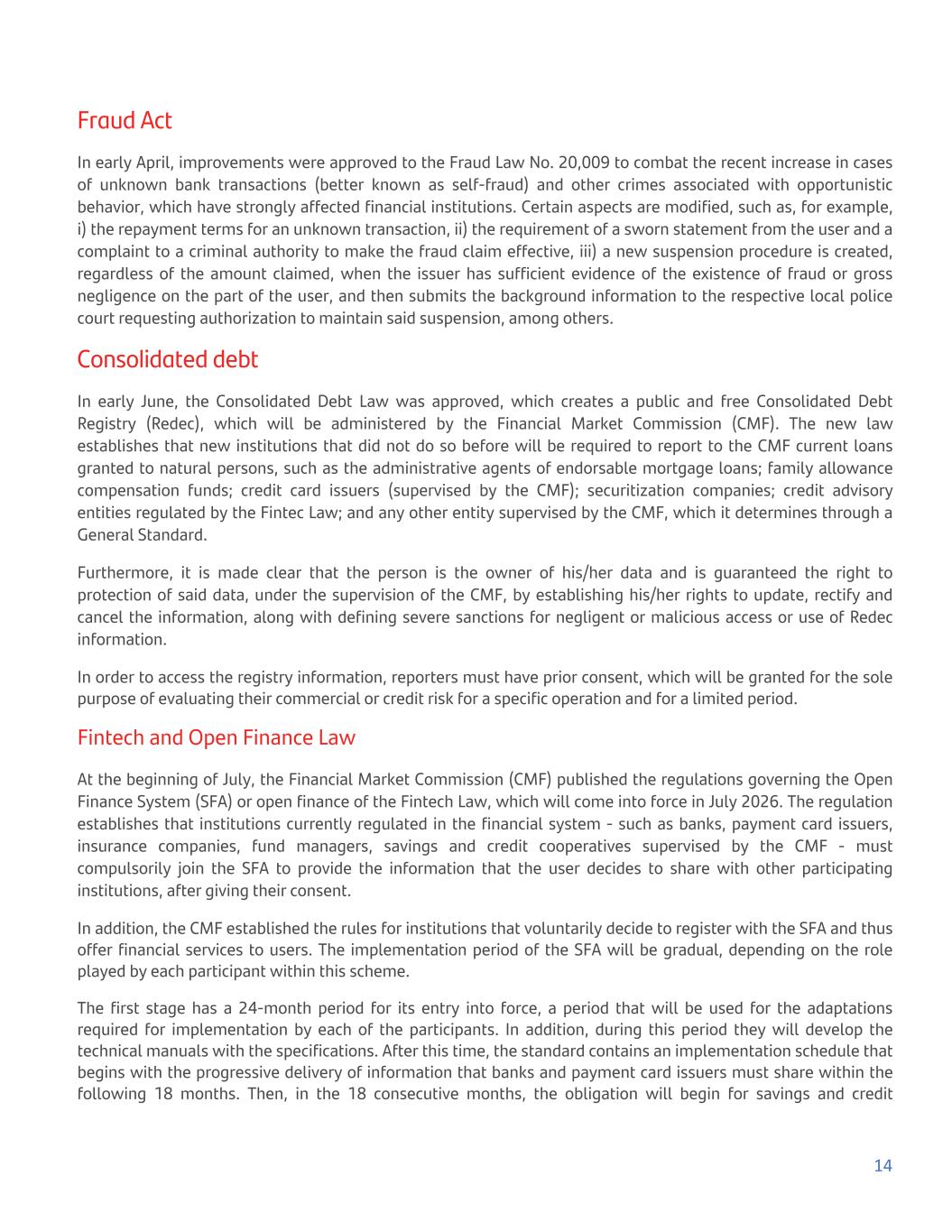
Fraud Act In early April, improvements were approved to the Fraud Law No. 20,009 to combat the recent increase in cases of unknown bank transactions (better known as self-fraud) and other crimes associated with opportunistic behavior, which have strongly affected financial institutions. Certain aspects are modified, such as, for example, i) the repayment terms for an unknown transaction, ii) the requirement of a sworn statement from the user and a complaint to a criminal authority to make the fraud claim effective, iii) a new suspension procedure is created, regardless of the amount claimed, when the issuer has sufficient evidence of the existence of fraud or gross negligence on the part of the user, and then submits the background information to the respective local police court requesting authorization to maintain said suspension, among others. Consolidated debt In early June, the Consolidated Debt Law was approved, which creates a public and free Consolidated Debt Registry (Redec), which will be administered by the Financial Market Commission (CMF). The new law establishes that new institutions that did not do so before will be required to report to the CMF current loans granted to natural persons, such as the administrative agents of endorsable mortgage loans; family allowance compensation funds; credit card issuers (supervised by the CMF); securitization companies; credit advisory entities regulated by the Fintec Law; and any other entity supervised by the CMF, which it determines through a General Standard. Furthermore, it is made clear that the person is the owner of his/her data and is guaranteed the right to protection of said data, under the supervision of the CMF, by establishing his/her rights to update, rectify and cancel the information, along with defining severe sanctions for negligent or malicious access or use of Redec information. In order to access the registry information, reporters must have prior consent, which will be granted for the sole purpose of evaluating their commercial or credit risk for a specific operation and for a limited period. Fintech and Open Finance Law At the beginning of July, the Financial Market Commission (CMF) published the regulations governing the Open Finance System (SFA) or open finance of the Fintech Law, which will come into force in July 2026. The regulation establishes that institutions currently regulated in the financial system - such as banks, payment card issuers, insurance companies, fund managers, savings and credit cooperatives supervised by the CMF - must compulsorily join the SFA to provide the information that the user decides to share with other participating institutions, after giving their consent. In addition, the CMF established the rules for institutions that voluntarily decide to register with the SFA and thus offer financial services to users. The implementation period of the SFA will be gradual, depending on the role played by each participant within this scheme. The first stage has a 24-month period for its entry into force, a period that will be used for the adaptations required for implementation by each of the participants. In addition, during this period they will develop the technical manuals with the specifications. After this time, the standard contains an implementation schedule that begins with the progressive delivery of information that banks and payment card issuers must share within the following 18 months. Then, in the 18 consecutive months, the obligation will begin for savings and credit 14
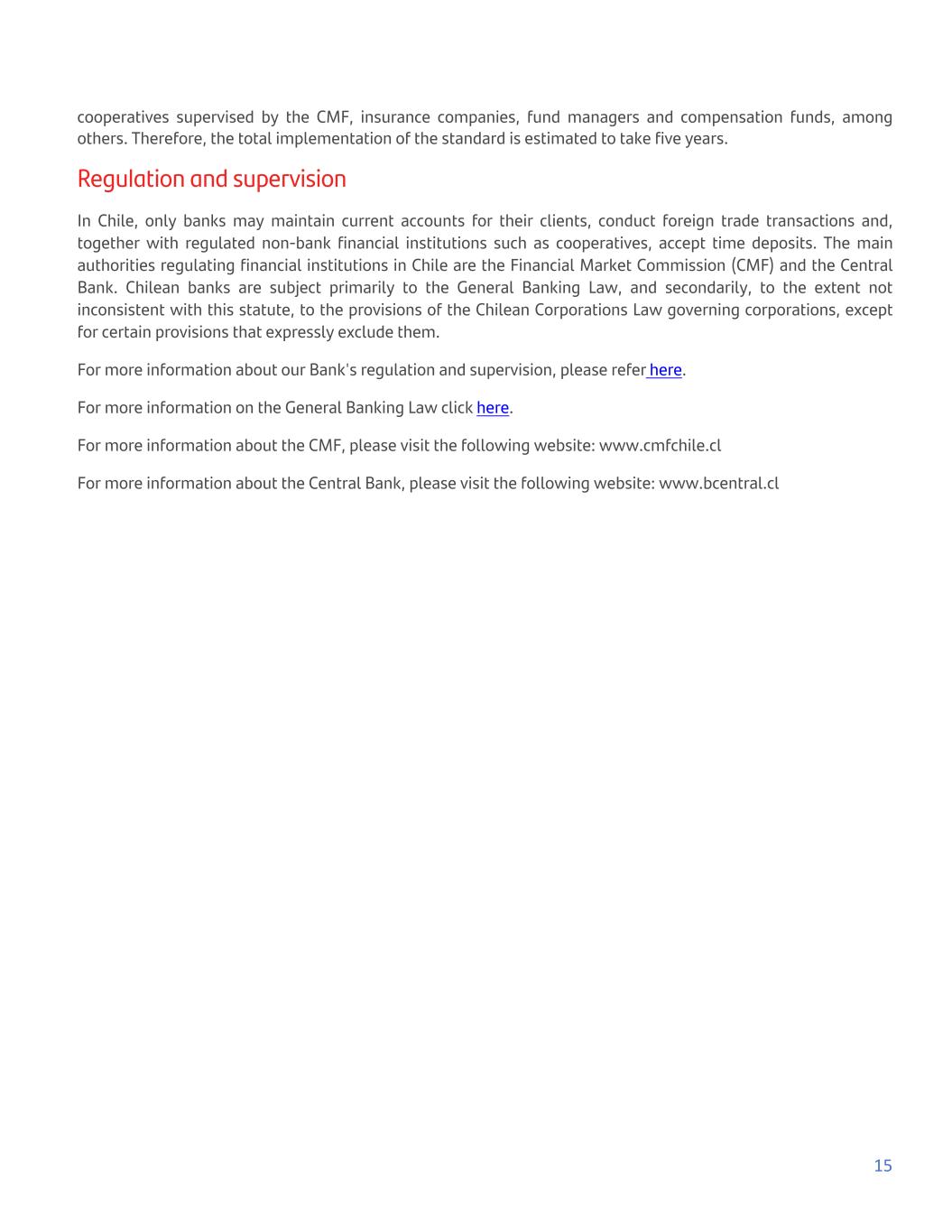
cooperatives supervised by the CMF, insurance companies, fund managers and compensation funds, among others. Therefore, the total implementation of the standard is estimated to take five years. Regulation and supervision In Chile, only banks may maintain current accounts for their clients, conduct foreign trade transactions and, together with regulated non-bank financial institutions such as cooperatives, accept time deposits. The main authorities regulating financial institutions in Chile are the Financial Market Commission (CMF) and the Central Bank. Chilean banks are subject primarily to the General Banking Law, and secondarily, to the extent not inconsistent with this statute, to the provisions of the Chilean Corporations Law governing corporations, except for certain provisions that expressly exclude them. For more information about our Bank's regulation and supervision, please refer here. For more information on the General Banking Law click here. For more information about the CMF, please visit the following website: www.cmfchile.cl For more information about the Central Bank, please visit the following website: www.bcentral.cl 15
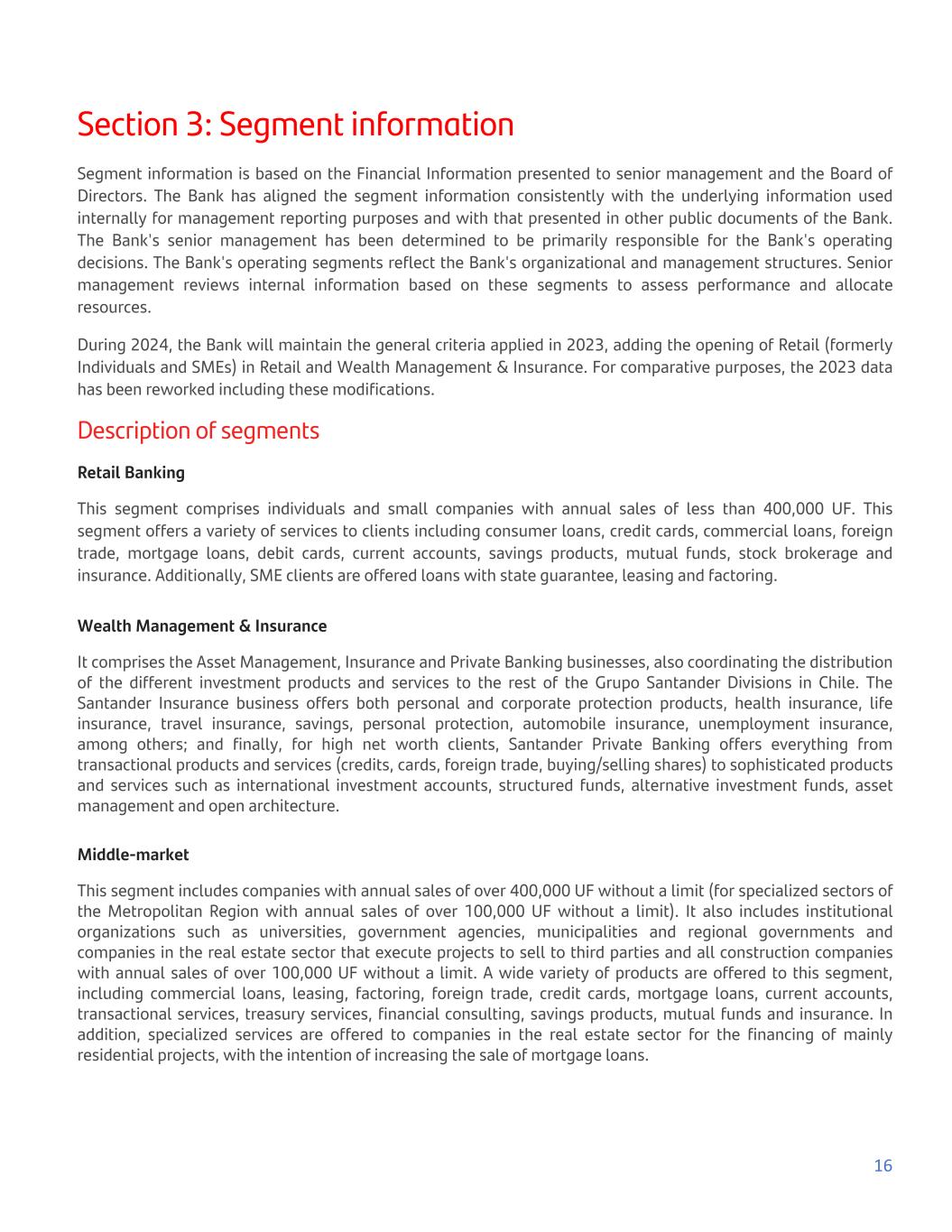
Section 3: Segment information Segment information is based on the Financial Information presented to senior management and the Board of Directors. The Bank has aligned the segment information consistently with the underlying information used internally for management reporting purposes and with that presented in other public documents of the Bank. The Bank's senior management has been determined to be primarily responsible for the Bank's operating decisions. The Bank's operating segments reflect the Bank's organizational and management structures. Senior management reviews internal information based on these segments to assess performance and allocate resources. During 2024, the Bank will maintain the general criteria applied in 2023, adding the opening of Retail (formerly Individuals and SMEs) in Retail and Wealth Management & Insurance. For comparative purposes, the 2023 data has been reworked including these modifications. Description of segments Retail Banking This segment comprises individuals and small companies with annual sales of less than 400,000 UF. This segment offers a variety of services to clients including consumer loans, credit cards, commercial loans, foreign trade, mortgage loans, debit cards, current accounts, savings products, mutual funds, stock brokerage and insurance. Additionally, SME clients are offered loans with state guarantee, leasing and factoring. Wealth Management & Insurance It comprises the Asset Management, Insurance and Private Banking businesses, also coordinating the distribution of the different investment products and services to the rest of the Grupo Santander Divisions in Chile. The Santander Insurance business offers both personal and corporate protection products, health insurance, life insurance, travel insurance, savings, personal protection, automobile insurance, unemployment insurance, among others; and finally, for high net worth clients, Santander Private Banking offers everything from transactional products and services (credits, cards, foreign trade, buying/selling shares) to sophisticated products and services such as international investment accounts, structured funds, alternative investment funds, asset management and open architecture. Middle-market This segment includes companies with annual sales of over 400,000 UF without a limit (for specialized sectors of the Metropolitan Region with annual sales of over 100,000 UF without a limit). It also includes institutional organizations such as universities, government agencies, municipalities and regional governments and companies in the real estate sector that execute projects to sell to third parties and all construction companies with annual sales of over 100,000 UF without a limit. A wide variety of products are offered to this segment, including commercial loans, leasing, factoring, foreign trade, credit cards, mortgage loans, current accounts, transactional services, treasury services, financial consulting, savings products, mutual funds and insurance. In addition, specialized services are offered to companies in the real estate sector for the financing of mainly residential projects, with the intention of increasing the sale of mortgage loans. 16
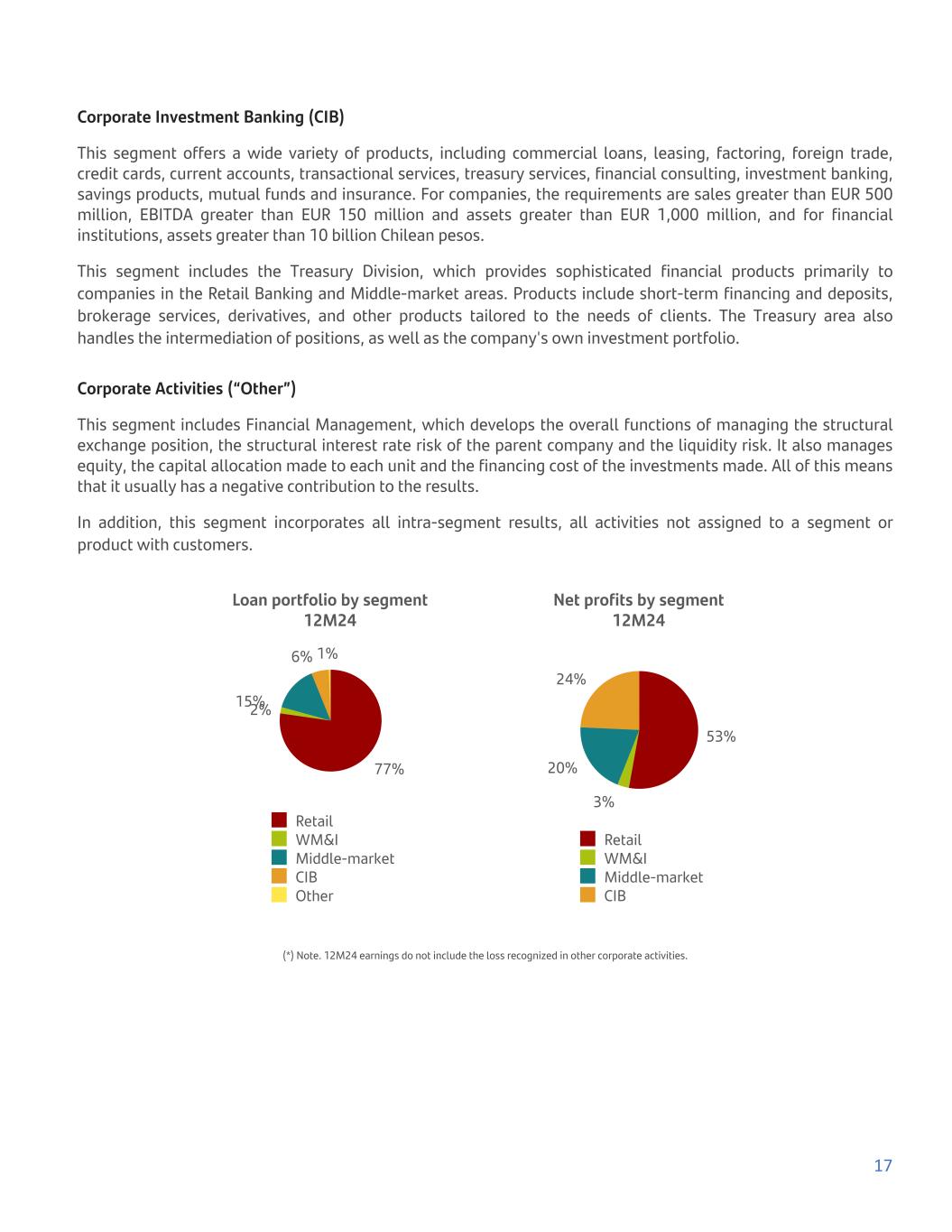
Corporate Investment Banking (CIB) This segment offers a wide variety of products, including commercial loans, leasing, factoring, foreign trade, credit cards, current accounts, transactional services, treasury services, financial consulting, investment banking, savings products, mutual funds and insurance. For companies, the requirements are sales greater than EUR 500 million, EBITDA greater than EUR 150 million and assets greater than EUR 1,000 million, and for financial institutions, assets greater than 10 billion Chilean pesos. This segment includes the Treasury Division, which provides sophisticated financial products primarily to companies in the Retail Banking and Middle-market areas. Products include short-term financing and deposits, brokerage services, derivatives, and other products tailored to the needs of clients. The Treasury area also handles the intermediation of positions, as well as the company's own investment portfolio. Corporate Activities (“Other”) This segment includes Financial Management, which develops the overall functions of managing the structural exchange position, the structural interest rate risk of the parent company and the liquidity risk. It also manages equity, the capital allocation made to each unit and the financing cost of the investments made. All of this means that it usually has a negative contribution to the results. In addition, this segment incorporates all intra-segment results, all activities not assigned to a segment or product with customers. Loan portfolio by segment 12M24 77% 2%15% 6% 1% Retail WM&I Middle-market CIB Other Net profits by segment 12M24 53% 3% 20% 24% Retail WM&I Middle-market CIB (*) Note. 12M24 earnings do not include the loss recognized in other corporate activities. 17
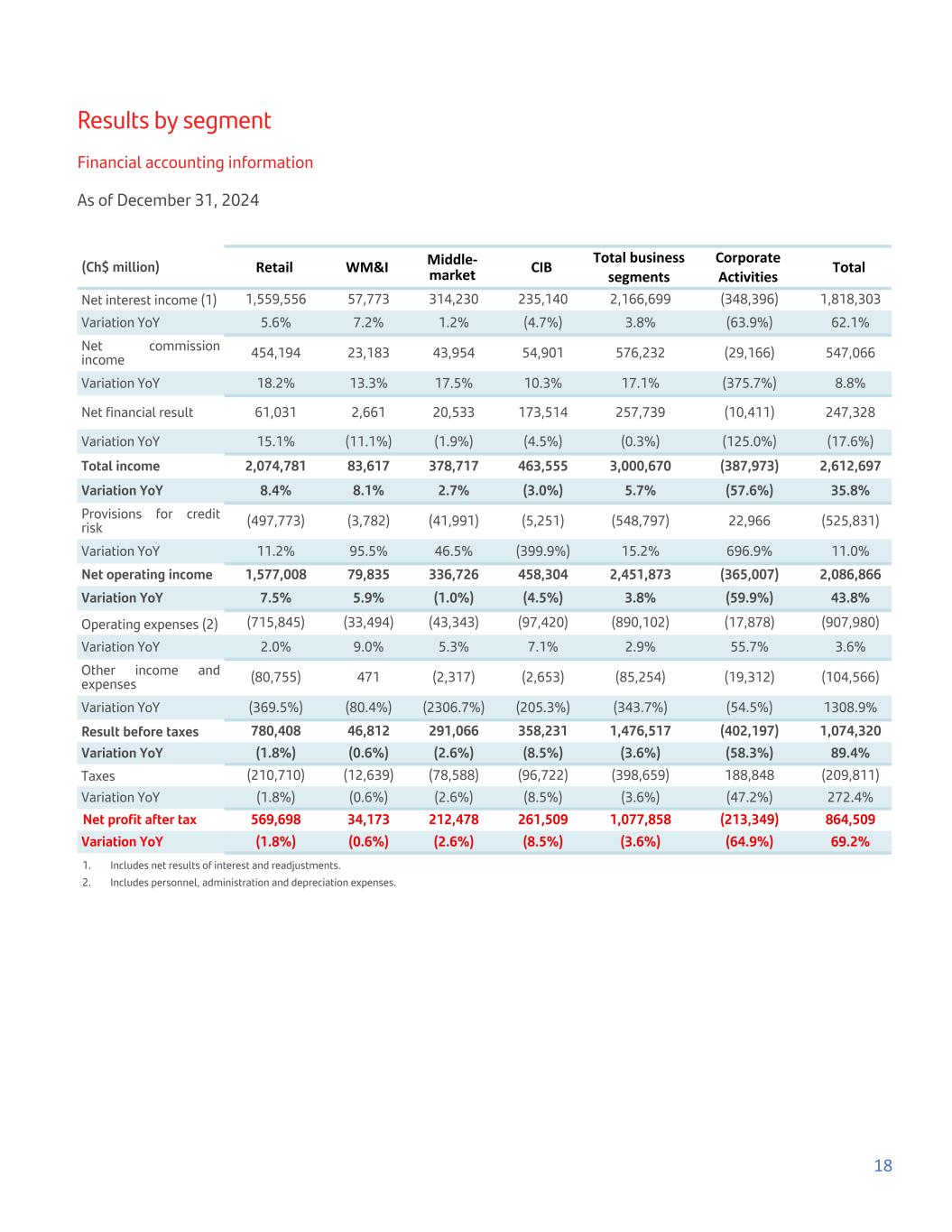
Results by segment Financial accounting information As of December 31, 2024 (Ch$ million) Retail WM&I Middle- market CIB Total business segments Corporate Activities Total Net interest income (1) 1,559,556 57,773 314,230 235,140 2,166,699 (348,396) 1,818,303 Variation YoY 5.6% 7.2% 1.2% (4.7%) 3.8% (63.9%) 62.1% Net commission income 454,194 23,183 43,954 54,901 576,232 (29,166) 547,066 Variation YoY 18.2% 13.3% 17.5% 10.3% 17.1% (375.7%) 8.8% Net financial result 61,031 2,661 20,533 173,514 257,739 (10,411) 247,328 Variation YoY 15.1% (11.1%) (1.9%) (4.5%) (0.3%) (125.0%) (17.6%) Total income 2,074,781 83,617 378,717 463,555 3,000,670 (387,973) 2,612,697 Variation YoY 8.4% 8.1% 2.7% (3.0%) 5.7% (57.6%) 35.8% Provisions for credit risk (497,773) (3,782) (41,991) (5,251) (548,797) 22,966 (525,831) Variation YoY 11.2% 95.5% 46.5% (399.9%) 15.2% 696.9% 11.0% Net operating income 1,577,008 79,835 336,726 458,304 2,451,873 (365,007) 2,086,866 Variation YoY 7.5% 5.9% (1.0%) (4.5%) 3.8% (59.9%) 43.8% Operating expenses (2) (715,845) (33,494) (43,343) (97,420) (890,102) (17,878) (907,980) Variation YoY 2.0% 9.0% 5.3% 7.1% 2.9% 55.7% 3.6% Other income and expenses (80,755) 471 (2,317) (2,653) (85,254) (19,312) (104,566) Variation YoY (369.5%) (80.4%) (2306.7%) (205.3%) (343.7%) (54.5%) 1308.9% Result before taxes 780,408 46,812 291,066 358,231 1,476,517 (402,197) 1,074,320 Variation YoY (1.8%) (0.6%) (2.6%) (8.5%) (3.6%) (58.3%) 89.4% Taxes (210,710) (12,639) (78,588) (96,722) (398,659) 188,848 (209,811) Variation YoY (1.8%) (0.6%) (2.6%) (8.5%) (3.6%) (47.2%) 272.4% Net profit after tax 569,698 34,173 212,478 261,509 1,077,858 (213,349) 864,509 Variation YoY (1.8%) (0.6%) (2.6%) (8.5%) (3.6%) (64.9%) 69.2% 1. Includes net results of interest and readjustments. 2. Includes personnel, administration and depreciation expenses. 18
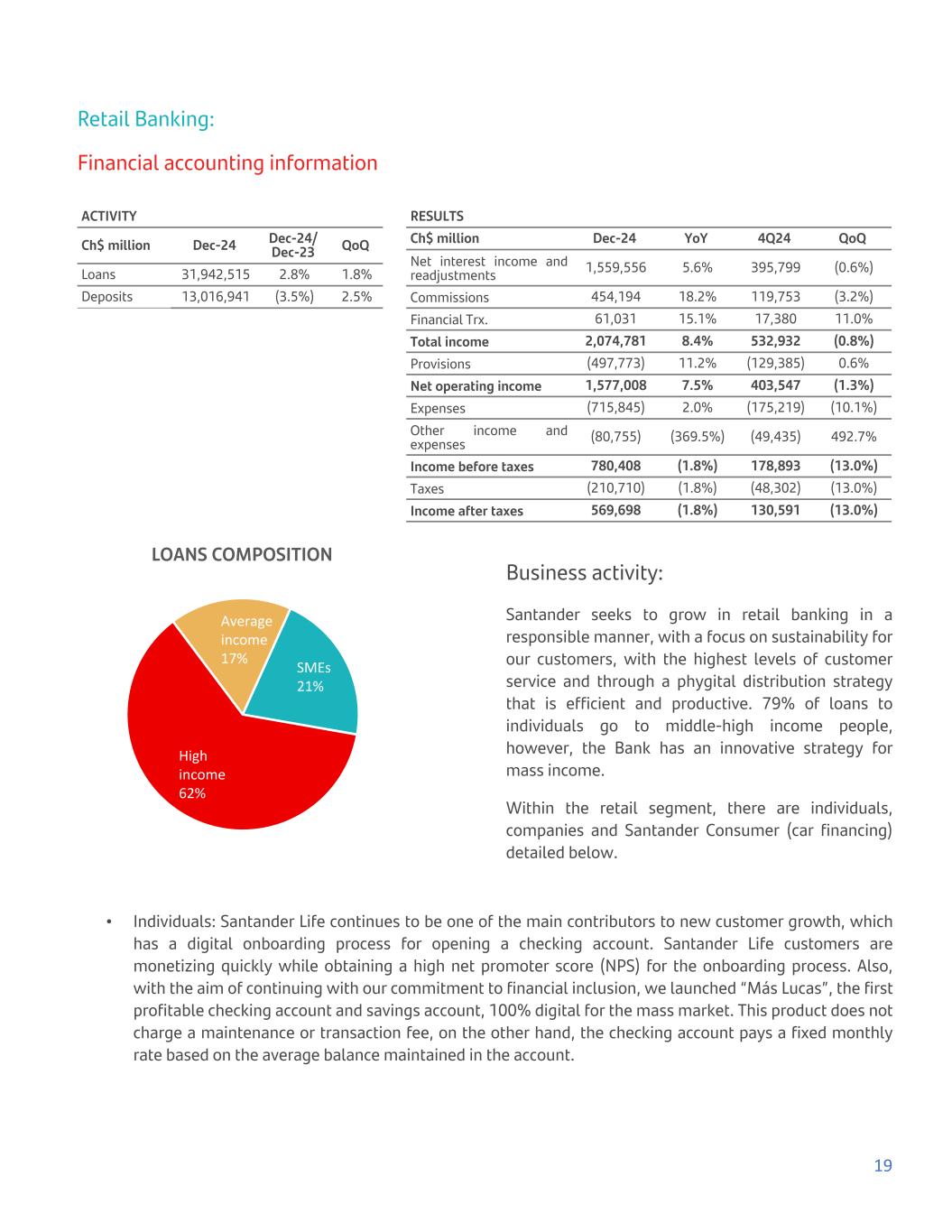
Retail Banking: Financial accounting information ACTIVITY Ch$ million Dec-24 Dec-24/ Dec-23 QoQ Loans 31,942,515 2.8% 1.8% Deposits 13,016,941 (3.5%) 2.5% RESULTS Ch$ million Dec-24 YoY 4Q24 QoQ Net interest income and readjustments 1,559,556 5.6% 395,799 (0.6%) Commissions 454,194 18.2% 119,753 (3.2%) Financial Trx. 61,031 15.1% 17,380 11.0% Total income 2,074,781 8.4% 532,932 (0.8%) Provisions (497,773) 11.2% (129,385) 0.6% Net operating income 1,577,008 7.5% 403,547 (1.3%) Expenses (715,845) 2.0% (175,219) (10.1%) Other income and expenses (80,755) (369.5%) (49,435) 492.7% Income before taxes 780,408 (1.8%) 178,893 (13.0%) Taxes (210,710) (1.8%) (48,302) (13.0%) Income after taxes 569,698 (1.8%) 130,591 (13.0%) LOANS COMPOSITION High income 62% Average income 17% SMEs 21% Business activity: Santander seeks to grow in retail banking in a responsible manner, with a focus on sustainability for our customers, with the highest levels of customer service and through a phygital distribution strategy that is efficient and productive. 79% of loans to individuals go to middle-high income people, however, the Bank has an innovative strategy for mass income. Within the retail segment, there are individuals, companies and Santander Consumer (car financing) detailed below. • Individuals: Santander Life continues to be one of the main contributors to new customer growth, which has a digital onboarding process for opening a checking account. Santander Life customers are monetizing quickly while obtaining a high net promoter score (NPS) for the onboarding process. Also, with the aim of continuing with our commitment to financial inclusion, we launched “Más Lucas”, the first profitable checking account and savings account, 100% digital for the mass market. This product does not charge a maintenance or transaction fee, on the other hand, the checking account pays a fixed monthly rate based on the average balance maintained in the account. 19
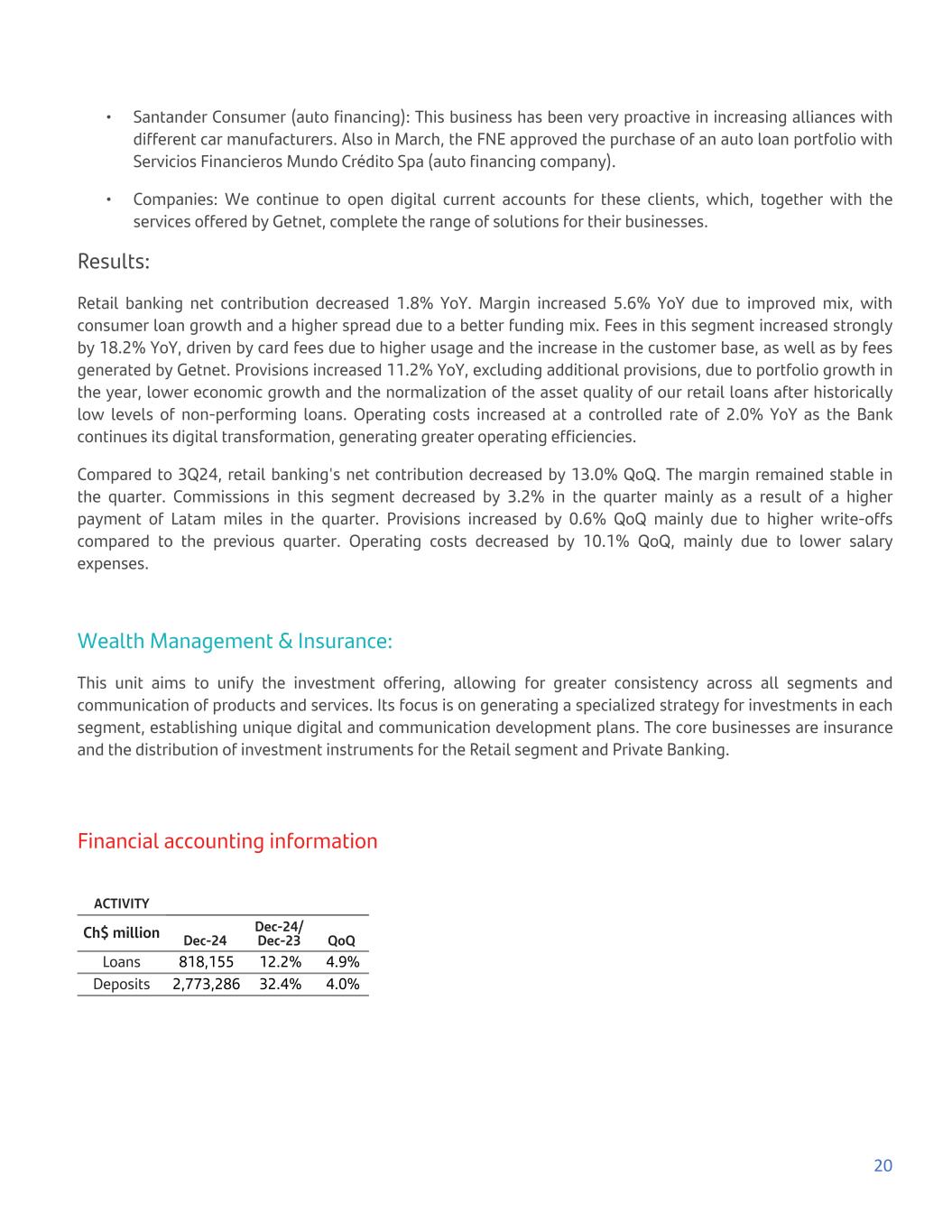
• Santander Consumer (auto financing): This business has been very proactive in increasing alliances with different car manufacturers. Also in March, the FNE approved the purchase of an auto loan portfolio with Servicios Financieros Mundo Crédito Spa (auto financing company). • Companies: We continue to open digital current accounts for these clients, which, together with the services offered by Getnet, complete the range of solutions for their businesses. Results: Retail banking net contribution decreased 1.8% YoY. Margin increased 5.6% YoY due to improved mix, with consumer loan growth and a higher spread due to a better funding mix. Fees in this segment increased strongly by 18.2% YoY, driven by card fees due to higher usage and the increase in the customer base, as well as by fees generated by Getnet. Provisions increased 11.2% YoY, excluding additional provisions, due to portfolio growth in the year, lower economic growth and the normalization of the asset quality of our retail loans after historically low levels of non-performing loans. Operating costs increased at a controlled rate of 2.0% YoY as the Bank continues its digital transformation, generating greater operating efficiencies. Compared to 3Q24, retail banking's net contribution decreased by 13.0% QoQ. The margin remained stable in the quarter. Commissions in this segment decreased by 3.2% in the quarter mainly as a result of a higher payment of Latam miles in the quarter. Provisions increased by 0.6% QoQ mainly due to higher write-offs compared to the previous quarter. Operating costs decreased by 10.1% QoQ, mainly due to lower salary expenses. Wealth Management & Insurance: This unit aims to unify the investment offering, allowing for greater consistency across all segments and communication of products and services. Its focus is on generating a specialized strategy for investments in each segment, establishing unique digital and communication development plans. The core businesses are insurance and the distribution of investment instruments for the Retail segment and Private Banking. Financial accounting information ACTIVITY Ch$ million Dec-24 Dec-24/ Dec-23 QoQ Loans 818,155 12.2% 4.9% Deposits 2,773,286 32.4% 4.0% 20
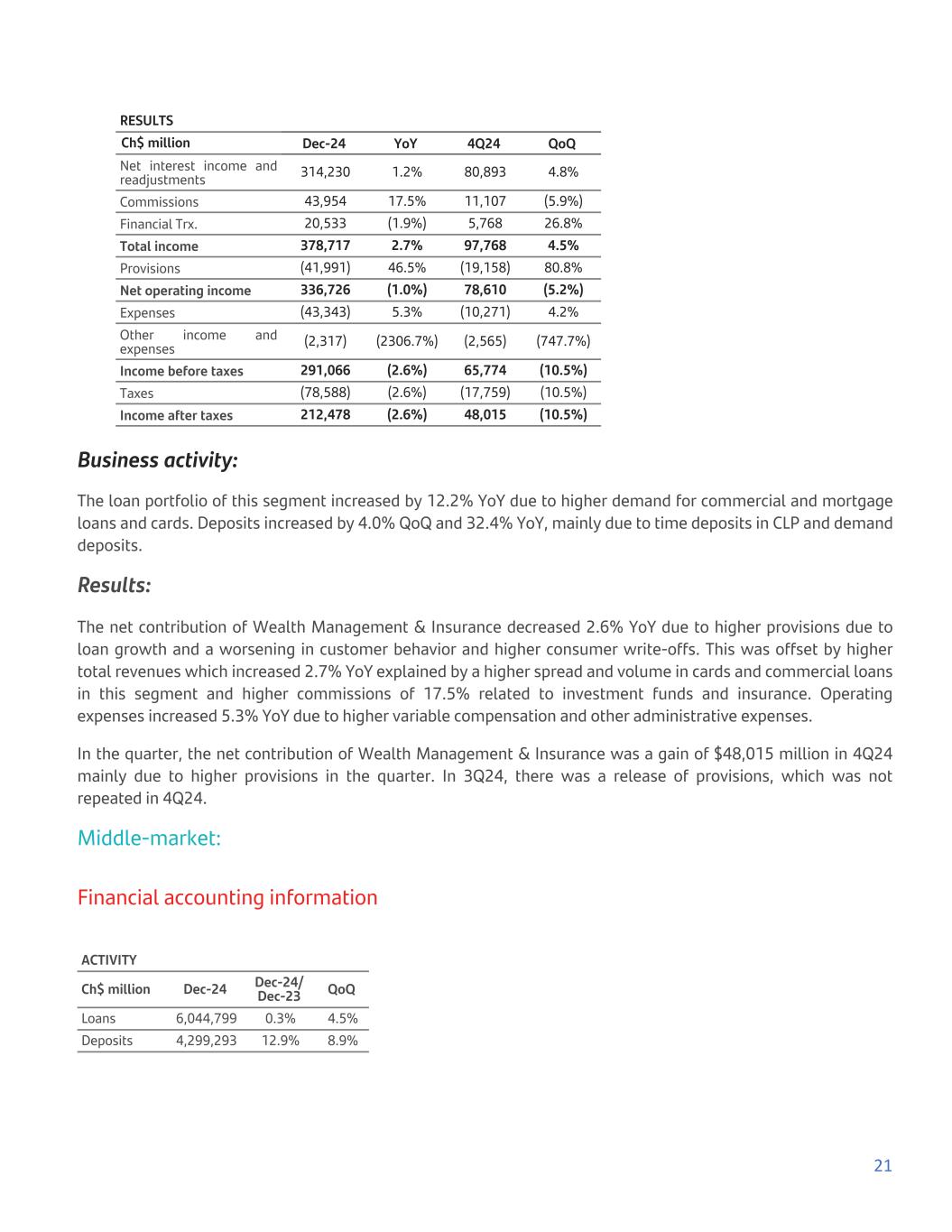
RESULTS Ch$ million Dec-24 YoY 4Q24 QoQ Net interest income and readjustments 314,230 1.2% 80,893 4.8% Commissions 43,954 17.5% 11,107 (5.9%) Financial Trx. 20,533 (1.9%) 5,768 26.8% Total income 378,717 2.7% 97,768 4.5% Provisions (41,991) 46.5% (19,158) 80.8% Net operating income 336,726 (1.0%) 78,610 (5.2%) Expenses (43,343) 5.3% (10,271) 4.2% Other income and expenses (2,317) (2306.7%) (2,565) (747.7%) Income before taxes 291,066 (2.6%) 65,774 (10.5%) Taxes (78,588) (2.6%) (17,759) (10.5%) Income after taxes 212,478 (2.6%) 48,015 (10.5%) Business activity: The loan portfolio of this segment increased by 12.2% YoY due to higher demand for commercial and mortgage loans and cards. Deposits increased by 4.0% QoQ and 32.4% YoY, mainly due to time deposits in CLP and demand deposits. Results: The net contribution of Wealth Management & Insurance decreased 2.6% YoY due to higher provisions due to loan growth and a worsening in customer behavior and higher consumer write-offs. This was offset by higher total revenues which increased 2.7% YoY explained by a higher spread and volume in cards and commercial loans in this segment and higher commissions of 17.5% related to investment funds and insurance. Operating expenses increased 5.3% YoY due to higher variable compensation and other administrative expenses. In the quarter, the net contribution of Wealth Management & Insurance was a gain of $48,015 million in 4Q24 mainly due to higher provisions in the quarter. In 3Q24, there was a release of provisions, which was not repeated in 4Q24. Middle-market: Financial accounting information ACTIVITY Ch$ million Dec-24 Dec-24/ Dec-23 QoQ Loans 6,044,799 0.3% 4.5% Deposits 4,299,293 12.9% 8.9% 21
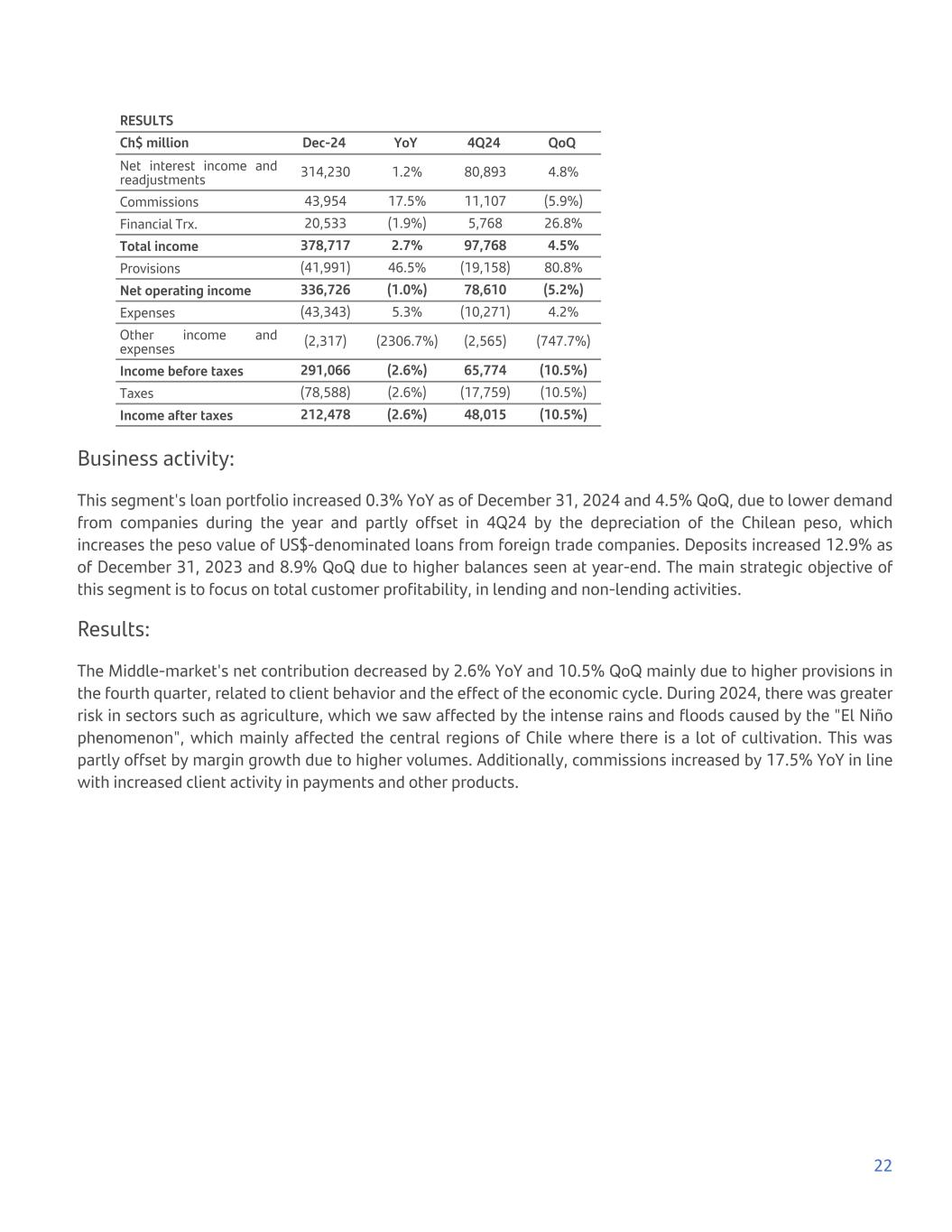
RESULTS Ch$ million Dec-24 YoY 4Q24 QoQ Net interest income and readjustments 314,230 1.2% 80,893 4.8% Commissions 43,954 17.5% 11,107 (5.9%) Financial Trx. 20,533 (1.9%) 5,768 26.8% Total income 378,717 2.7% 97,768 4.5% Provisions (41,991) 46.5% (19,158) 80.8% Net operating income 336,726 (1.0%) 78,610 (5.2%) Expenses (43,343) 5.3% (10,271) 4.2% Other income and expenses (2,317) (2306.7%) (2,565) (747.7%) Income before taxes 291,066 (2.6%) 65,774 (10.5%) Taxes (78,588) (2.6%) (17,759) (10.5%) Income after taxes 212,478 (2.6%) 48,015 (10.5%) Business activity: This segment's loan portfolio increased 0.3% YoY as of December 31, 2024 and 4.5% QoQ, due to lower demand from companies during the year and partly offset in 4Q24 by the depreciation of the Chilean peso, which increases the peso value of US$-denominated loans from foreign trade companies. Deposits increased 12.9% as of December 31, 2023 and 8.9% QoQ due to higher balances seen at year-end. The main strategic objective of this segment is to focus on total customer profitability, in lending and non-lending activities. Results: The Middle-market's net contribution decreased by 2.6% YoY and 10.5% QoQ mainly due to higher provisions in the fourth quarter, related to client behavior and the effect of the economic cycle. During 2024, there was greater risk in sectors such as agriculture, which we saw affected by the intense rains and floods caused by the "El Niño phenomenon", which mainly affected the central regions of Chile where there is a lot of cultivation. This was partly offset by margin growth due to higher volumes. Additionally, commissions increased by 17.5% YoY in line with increased client activity in payments and other products. 22
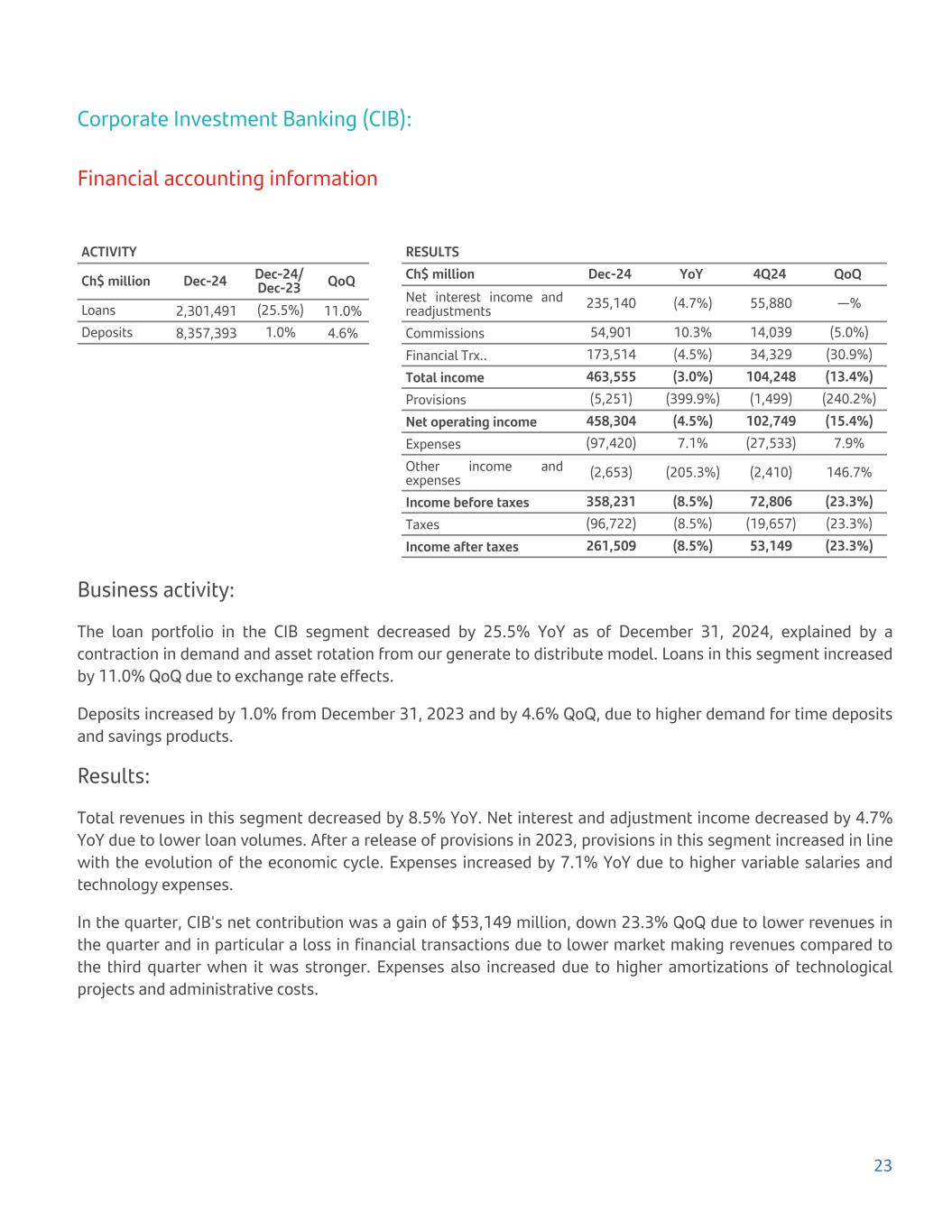
Corporate Investment Banking (CIB): Financial accounting information ACTIVITY Ch$ million Dec-24 Dec-24/ Dec-23 QoQ Loans 2,301,491 (25.5%) 11.0% Deposits 8,357,393 1.0% 4.6% RESULTS Ch$ million Dec-24 YoY 4Q24 QoQ Net interest income and readjustments 235,140 (4.7%) 55,880 —% Commissions 54,901 10.3% 14,039 (5.0%) Financial Trx.. 173,514 (4.5%) 34,329 (30.9%) Total income 463,555 (3.0%) 104,248 (13.4%) Provisions (5,251) (399.9%) (1,499) (240.2%) Net operating income 458,304 (4.5%) 102,749 (15.4%) Expenses (97,420) 7.1% (27,533) 7.9% Other income and expenses (2,653) (205.3%) (2,410) 146.7% Income before taxes 358,231 (8.5%) 72,806 (23.3%) Taxes (96,722) (8.5%) (19,657) (23.3%) Income after taxes 261,509 (8.5%) 53,149 (23.3%) Business activity: The loan portfolio in the CIB segment decreased by 25.5% YoY as of December 31, 2024, explained by a contraction in demand and asset rotation from our generate to distribute model. Loans in this segment increased by 11.0% QoQ due to exchange rate effects. Deposits increased by 1.0% from December 31, 2023 and by 4.6% QoQ, due to higher demand for time deposits and savings products. Results: Total revenues in this segment decreased by 8.5% YoY. Net interest and adjustment income decreased by 4.7% YoY due to lower loan volumes. After a release of provisions in 2023, provisions in this segment increased in line with the evolution of the economic cycle. Expenses increased by 7.1% YoY due to higher variable salaries and technology expenses. In the quarter, CIB's net contribution was a gain of $53,149 million, down 23.3% QoQ due to lower revenues in the quarter and in particular a loss in financial transactions due to lower market making revenues compared to the third quarter when it was stronger. Expenses also increased due to higher amortizations of technological projects and administrative costs. 23
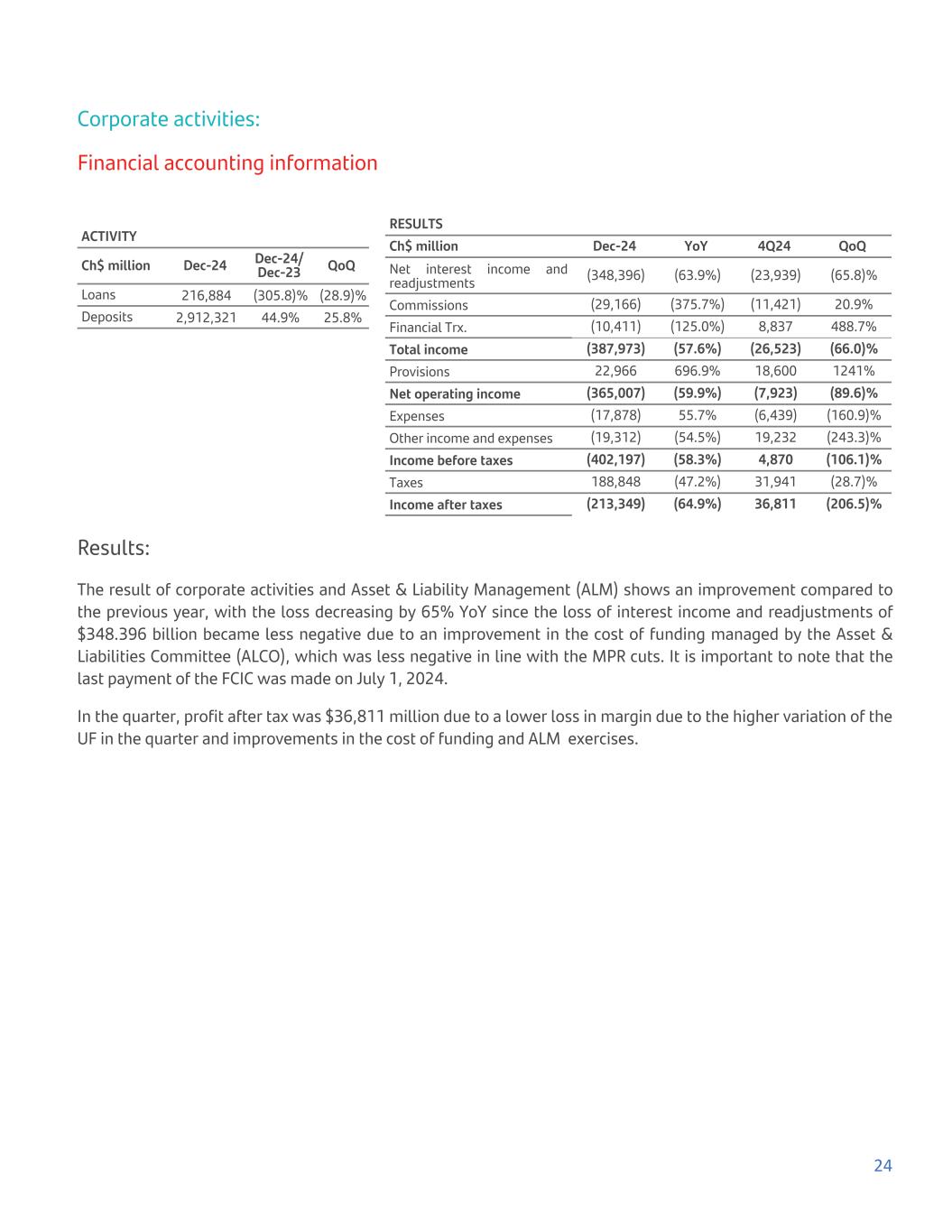
Corporate activities: Financial accounting information ACTIVITY Ch$ million Dec-24 Dec-24/ Dec-23 QoQ Loans 216,884 (305.8)% (28.9)% Deposits 2,912,321 44.9% 25.8% RESULTS Ch$ million Dec-24 YoY 4Q24 QoQ Net interest income and readjustments (348,396) (63.9%) (23,939) (65.8)% Commissions (29,166) (375.7%) (11,421) 20.9% Financial Trx. (10,411) (125.0%) 8,837 488.7% Total income (387,973) (57.6%) (26,523) (66.0)% Provisions 22,966 696.9% 18,600 1241% Net operating income (365,007) (59.9%) (7,923) (89.6)% Expenses (17,878) 55.7% (6,439) (160.9)% Other income and expenses (19,312) (54.5%) 19,232 (243.3)% Income before taxes (402,197) (58.3%) 4,870 (106.1)% Taxes 188,848 (47.2%) 31,941 (28.7)% Income after taxes (213,349) (64.9%) 36,811 (206.5)% Results: The result of corporate activities and Asset & Liability Management (ALM) shows an improvement compared to the previous year, with the loss decreasing by 65% YoY since the loss of interest income and readjustments of $348.396 billion became less negative due to an improvement in the cost of funding managed by the Asset & Liabilities Committee (ALCO), which was less negative in line with the MPR cuts. It is important to note that the last payment of the FCIC was made on July 1, 2024. In the quarter, profit after tax was $36,811 million due to a lower loss in margin due to the higher variation of the UF in the quarter and improvements in the cost of funding and ALM exercises. 24
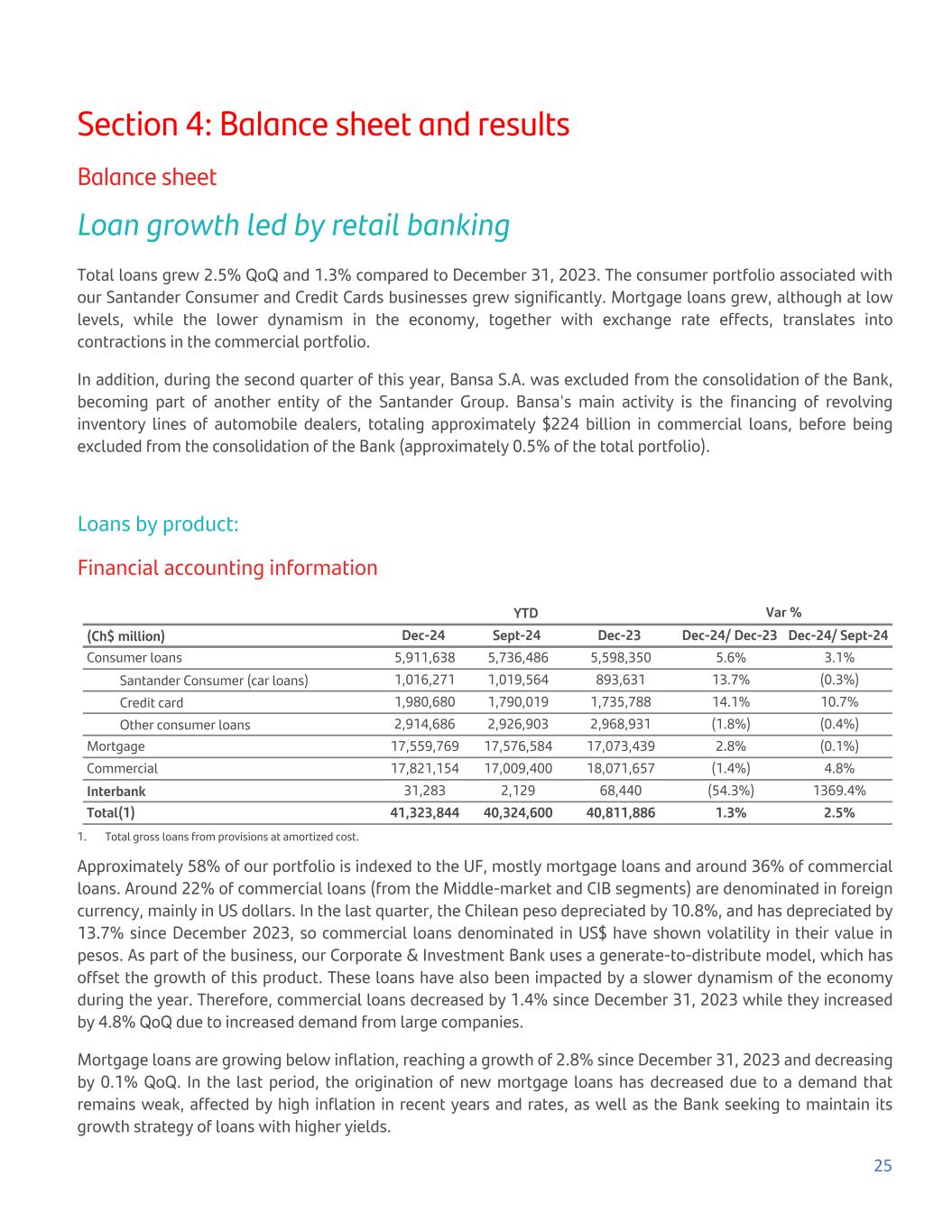
Section 4: Balance sheet and results Balance sheet Loan growth led by retail banking Total loans grew 2.5% QoQ and 1.3% compared to December 31, 2023. The consumer portfolio associated with our Santander Consumer and Credit Cards businesses grew significantly. Mortgage loans grew, although at low levels, while the lower dynamism in the economy, together with exchange rate effects, translates into contractions in the commercial portfolio. In addition, during the second quarter of this year, Bansa S.A. was excluded from the consolidation of the Bank, becoming part of another entity of the Santander Group. Bansa's main activity is the financing of revolving inventory lines of automobile dealers, totaling approximately $224 billion in commercial loans, before being excluded from the consolidation of the Bank (approximately 0.5% of the total portfolio). Loans by product: Financial accounting information YTD Var % (Ch$ million) Dec-24 Sept-24 Dec-23 Dec-24/ Dec-23 Dec-24/ Sept-24 Consumer loans 5,911,638 5,736,486 5,598,350 5.6% 3.1% Santander Consumer (car loans) 1,016,271 1,019,564 893,631 13.7% (0.3%) Credit card 1,980,680 1,790,019 1,735,788 14.1% 10.7% Other consumer loans 2,914,686 2,926,903 2,968,931 (1.8%) (0.4%) Mortgage 17,559,769 17,576,584 17,073,439 2.8% (0.1%) Commercial 17,821,154 17,009,400 18,071,657 (1.4%) 4.8% Interbank 31,283 2,129 68,440 (54.3%) 1369.4% Total(1) 41,323,844 40,324,600 40,811,886 1.3% 2.5% 1. Total gross loans from provisions at amortized cost. Approximately 58% of our portfolio is indexed to the UF, mostly mortgage loans and around 36% of commercial loans. Around 22% of commercial loans (from the Middle-market and CIB segments) are denominated in foreign currency, mainly in US dollars. In the last quarter, the Chilean peso depreciated by 10.8%, and has depreciated by 13.7% since December 2023, so commercial loans denominated in US$ have shown volatility in their value in pesos. As part of the business, our Corporate & Investment Bank uses a generate-to-distribute model, which has offset the growth of this product. These loans have also been impacted by a slower dynamism of the economy during the year. Therefore, commercial loans decreased by 1.4% since December 31, 2023 while they increased by 4.8% QoQ due to increased demand from large companies. Mortgage loans are growing below inflation, reaching a growth of 2.8% since December 31, 2023 and decreasing by 0.1% QoQ. In the last period, the origination of new mortgage loans has decreased due to a demand that remains weak, affected by high inflation in recent years and rates, as well as the Bank seeking to maintain its growth strategy of loans with higher yields. 25
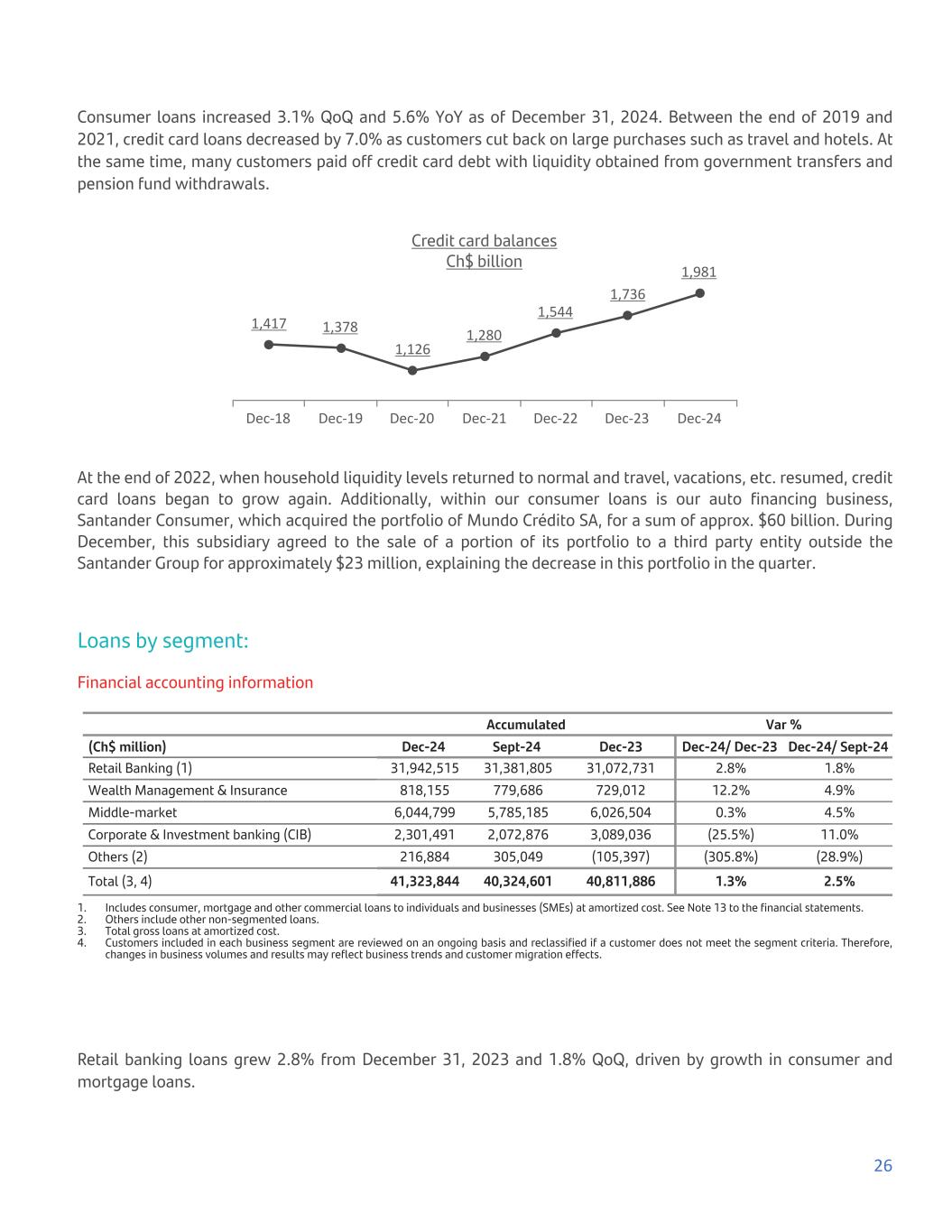
Consumer loans increased 3.1% QoQ and 5.6% YoY as of December 31, 2024. Between the end of 2019 and 2021, credit card loans decreased by 7.0% as customers cut back on large purchases such as travel and hotels. At the same time, many customers paid off credit card debt with liquidity obtained from government transfers and pension fund withdrawals. Credit card balances Ch$ billion 1,417 1,378 1,126 1,280 1,544 1,736 1,981 Dec-18 Dec-19 Dec-20 Dec-21 Dec-22 Dec-23 Dec-24 At the end of 2022, when household liquidity levels returned to normal and travel, vacations, etc. resumed, credit card loans began to grow again. Additionally, within our consumer loans is our auto financing business, Santander Consumer, which acquired the portfolio of Mundo Crédito SA, for a sum of approx. $60 billion. During December, this subsidiary agreed to the sale of a portion of its portfolio to a third party entity outside the Santander Group for approximately $23 million, explaining the decrease in this portfolio in the quarter. Loans by segment: Financial accounting information Accumulated Var % (Ch$ million) Dec-24 Sept-24 Dec-23 Dec-24/ Dec-23 Dec-24/ Sept-24 Retail Banking (1) 31,942,515 31,381,805 31,072,731 2.8% 1.8% Wealth Management & Insurance 818,155 779,686 729,012 12.2% 4.9% Middle-market 6,044,799 5,785,185 6,026,504 0.3% 4.5% Corporate & Investment banking (CIB) 2,301,491 2,072,876 3,089,036 (25.5%) 11.0% Others (2) 216,884 305,049 (105,397) (305.8%) (28.9%) Total (3, 4) 41,323,844 40,324,601 40,811,886 1.3% 2.5% 1. Includes consumer, mortgage and other commercial loans to individuals and businesses (SMEs) at amortized cost. See Note 13 to the financial statements. 2. Others include other non-segmented loans. 3. Total gross loans at amortized cost. 4. Customers included in each business segment are reviewed on an ongoing basis and reclassified if a customer does not meet the segment criteria. Therefore, changes in business volumes and results may reflect business trends and customer migration effects. Retail banking loans grew 2.8% from December 31, 2023 and 1.8% QoQ, driven by growth in consumer and mortgage loans. 26
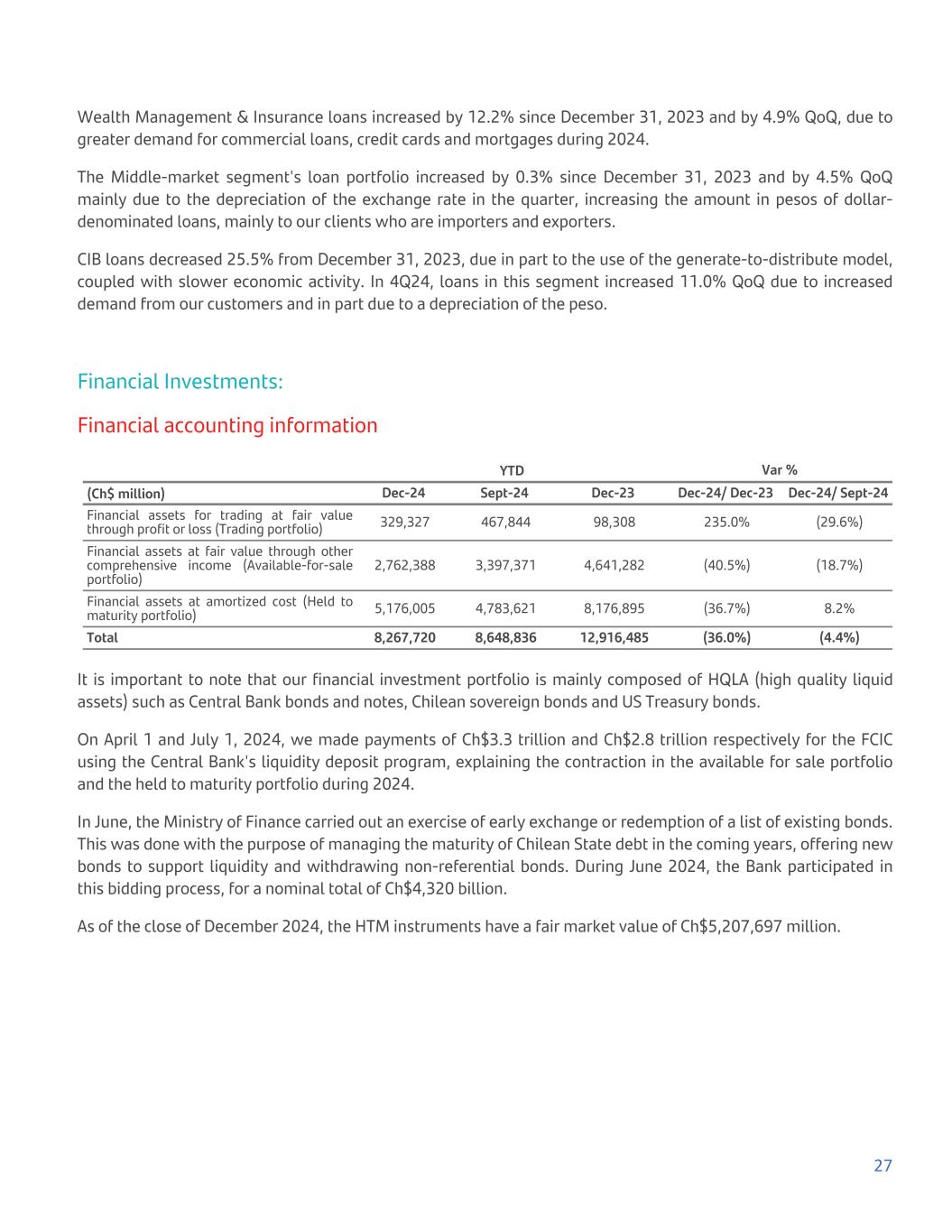
Wealth Management & Insurance loans increased by 12.2% since December 31, 2023 and by 4.9% QoQ, due to greater demand for commercial loans, credit cards and mortgages during 2024. The Middle-market segment's loan portfolio increased by 0.3% since December 31, 2023 and by 4.5% QoQ mainly due to the depreciation of the exchange rate in the quarter, increasing the amount in pesos of dollar- denominated loans, mainly to our clients who are importers and exporters. CIB loans decreased 25.5% from December 31, 2023, due in part to the use of the generate-to-distribute model, coupled with slower economic activity. In 4Q24, loans in this segment increased 11.0% QoQ due to increased demand from our customers and in part due to a depreciation of the peso. Financial Investments: Financial accounting information YTD Var % (Ch$ million) Dec-24 Sept-24 Dec-23 Dec-24/ Dec-23 Dec-24/ Sept-24 Financial assets for trading at fair value through profit or loss (Trading portfolio) 329,327 467,844 98,308 235.0% (29.6%) Financial assets at fair value through other comprehensive income (Available-for-sale portfolio) 2,762,388 3,397,371 4,641,282 (40.5%) (18.7%) Financial assets at amortized cost (Held to maturity portfolio) 5,176,005 4,783,621 8,176,895 (36.7%) 8.2% Total 8,267,720 8,648,836 12,916,485 (36.0%) (4.4%) It is important to note that our financial investment portfolio is mainly composed of HQLA (high quality liquid assets) such as Central Bank bonds and notes, Chilean sovereign bonds and US Treasury bonds. On April 1 and July 1, 2024, we made payments of Ch$3.3 trillion and Ch$2.8 trillion respectively for the FCIC using the Central Bank's liquidity deposit program, explaining the contraction in the available for sale portfolio and the held to maturity portfolio during 2024. In June, the Ministry of Finance carried out an exercise of early exchange or redemption of a list of existing bonds. This was done with the purpose of managing the maturity of Chilean State debt in the coming years, offering new bonds to support liquidity and withdrawing non-referential bonds. During June 2024, the Bank participated in this bidding process, for a nominal total of Ch$4,320 billion. As of the close of December 2024, the HTM instruments have a fair market value of Ch$5,207,697 million. 27
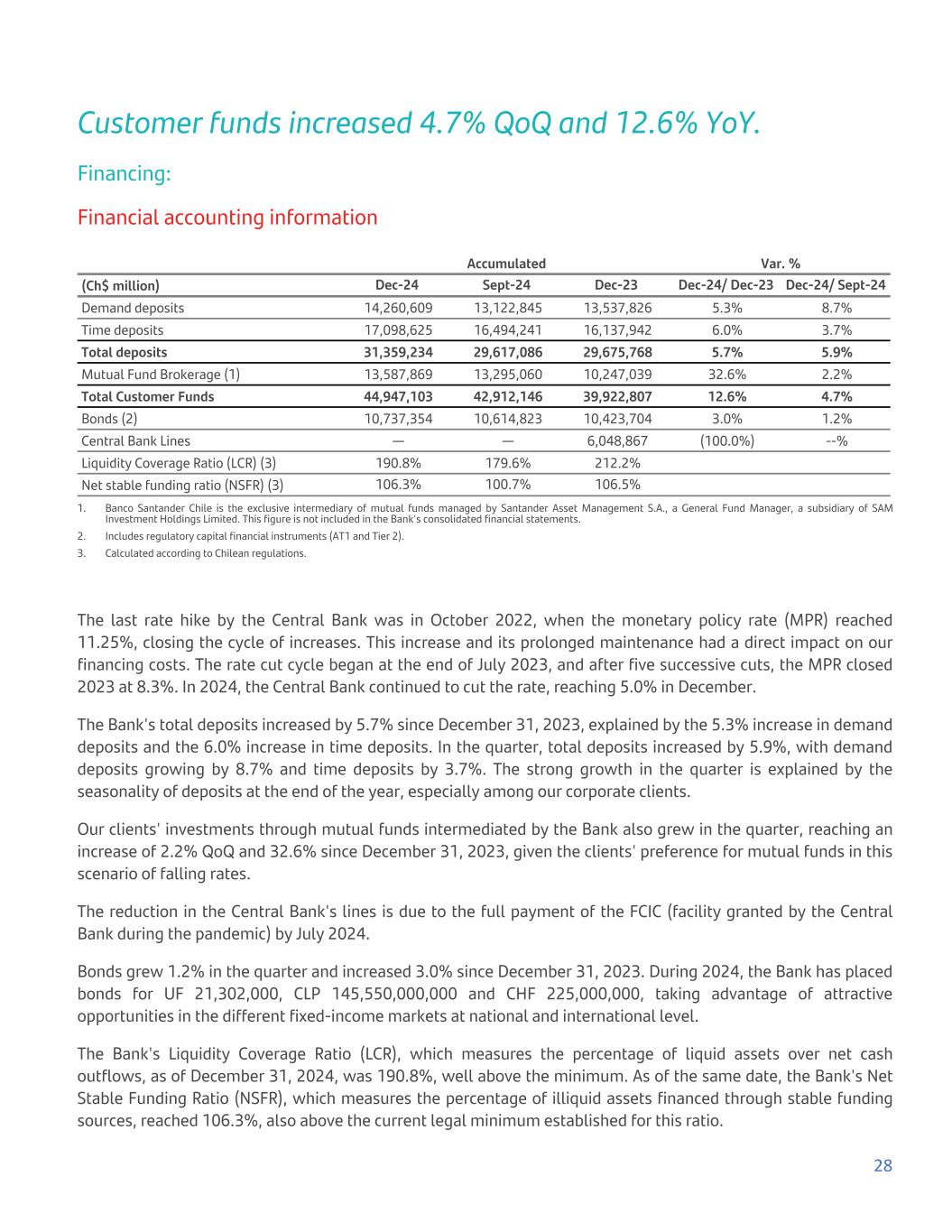
Customer funds increased 4.7% QoQ and 12.6% YoY. Financing: Financial accounting information Accumulated Var. % (Ch$ million) Dec-24 Sept-24 Dec-23 Dec-24/ Dec-23 Dec-24/ Sept-24 Demand deposits 14,260,609 13,122,845 13,537,826 5.3% 8.7% Time deposits 17,098,625 16,494,241 16,137,942 6.0% 3.7% Total deposits 31,359,234 29,617,086 29,675,768 5.7% 5.9% Mutual Fund Brokerage (1) 13,587,869 13,295,060 10,247,039 32.6% 2.2% Total Customer Funds 44,947,103 42,912,146 39,922,807 12.6% 4.7% Bonds (2) 10,737,354 10,614,823 10,423,704 3.0% 1.2% Central Bank Lines — — 6,048,867 (100.0%) --% Liquidity Coverage Ratio (LCR) (3) 190.8% 179.6% 212.2% Net stable funding ratio (NSFR) (3) 106.3% 100.7% 106.5% 1. Banco Santander Chile is the exclusive intermediary of mutual funds managed by Santander Asset Management S.A., a General Fund Manager, a subsidiary of SAM Investment Holdings Limited. This figure is not included in the Bank's consolidated financial statements. 2. Includes regulatory capital financial instruments (AT1 and Tier 2). 3. Calculated according to Chilean regulations. The last rate hike by the Central Bank was in October 2022, when the monetary policy rate (MPR) reached 11.25%, closing the cycle of increases. This increase and its prolonged maintenance had a direct impact on our financing costs. The rate cut cycle began at the end of July 2023, and after five successive cuts, the MPR closed 2023 at 8.3%. In 2024, the Central Bank continued to cut the rate, reaching 5.0% in December. The Bank's total deposits increased by 5.7% since December 31, 2023, explained by the 5.3% increase in demand deposits and the 6.0% increase in time deposits. In the quarter, total deposits increased by 5.9%, with demand deposits growing by 8.7% and time deposits by 3.7%. The strong growth in the quarter is explained by the seasonality of deposits at the end of the year, especially among our corporate clients. Our clients' investments through mutual funds intermediated by the Bank also grew in the quarter, reaching an increase of 2.2% QoQ and 32.6% since December 31, 2023, given the clients' preference for mutual funds in this scenario of falling rates. The reduction in the Central Bank's lines is due to the full payment of the FCIC (facility granted by the Central Bank during the pandemic) by July 2024. Bonds grew 1.2% in the quarter and increased 3.0% since December 31, 2023. During 2024, the Bank has placed bonds for UF 21,302,000, CLP 145,550,000,000 and CHF 225,000,000, taking advantage of attractive opportunities in the different fixed-income markets at national and international level. The Bank's Liquidity Coverage Ratio (LCR), which measures the percentage of liquid assets over net cash outflows, as of December 31, 2024, was 190.8%, well above the minimum. As of the same date, the Bank's Net Stable Funding Ratio (NSFR), which measures the percentage of illiquid assets financed through stable funding sources, reached 106.3%, also above the current legal minimum established for this ratio. 28
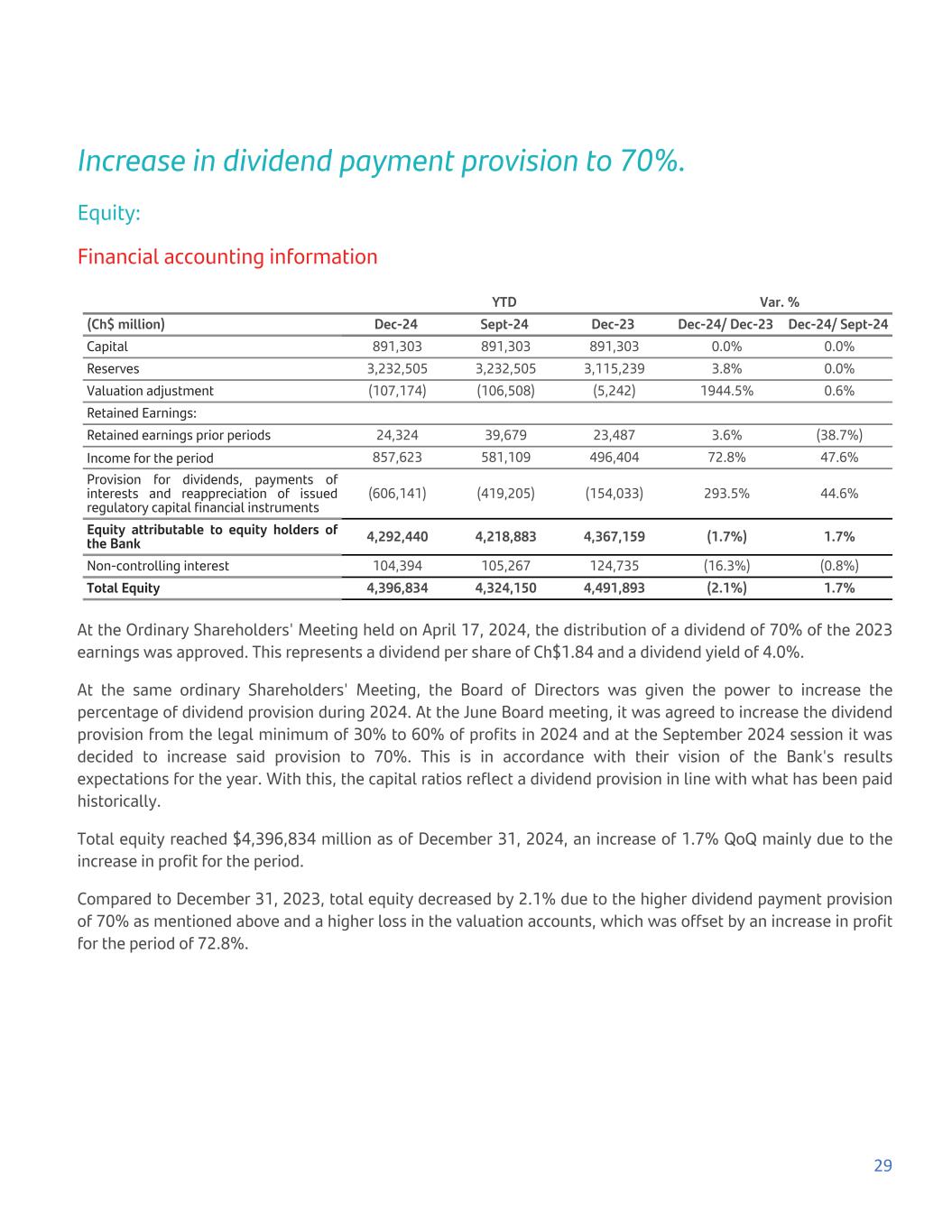
Increase in dividend payment provision to 70%. Equity: Financial accounting information YTD Var. % (Ch$ million) Dec-24 Sept-24 Dec-23 Dec-24/ Dec-23 Dec-24/ Sept-24 Capital 891,303 891,303 891,303 0.0% 0.0% Reserves 3,232,505 3,232,505 3,115,239 3.8% 0.0% Valuation adjustment (107,174) (106,508) (5,242) 1944.5% 0.6% Retained Earnings: Retained earnings prior periods 24,324 39,679 23,487 3.6% (38.7%) Income for the period 857,623 581,109 496,404 72.8% 47.6% Provision for dividends, payments of interests and reappreciation of issued regulatory capital financial instruments (606,141) (419,205) (154,033) 293.5% 44.6% Equity attributable to equity holders of the Bank 4,292,440 4,218,883 4,367,159 (1.7%) 1.7% Non-controlling interest 104,394 105,267 124,735 (16.3%) (0.8%) Total Equity 4,396,834 4,324,150 4,491,893 (2.1%) 1.7% At the Ordinary Shareholders' Meeting held on April 17, 2024, the distribution of a dividend of 70% of the 2023 earnings was approved. This represents a dividend per share of Ch$1.84 and a dividend yield of 4.0%. At the same ordinary Shareholders' Meeting, the Board of Directors was given the power to increase the percentage of dividend provision during 2024. At the June Board meeting, it was agreed to increase the dividend provision from the legal minimum of 30% to 60% of profits in 2024 and at the September 2024 session it was decided to increase said provision to 70%. This is in accordance with their vision of the Bank's results expectations for the year. With this, the capital ratios reflect a dividend provision in line with what has been paid historically. Total equity reached $4,396,834 million as of December 31, 2024, an increase of 1.7% QoQ mainly due to the increase in profit for the period. Compared to December 31, 2023, total equity decreased by 2.1% due to the higher dividend payment provision of 70% as mentioned above and a higher loss in the valuation accounts, which was offset by an increase in profit for the period of 72.8%. 29
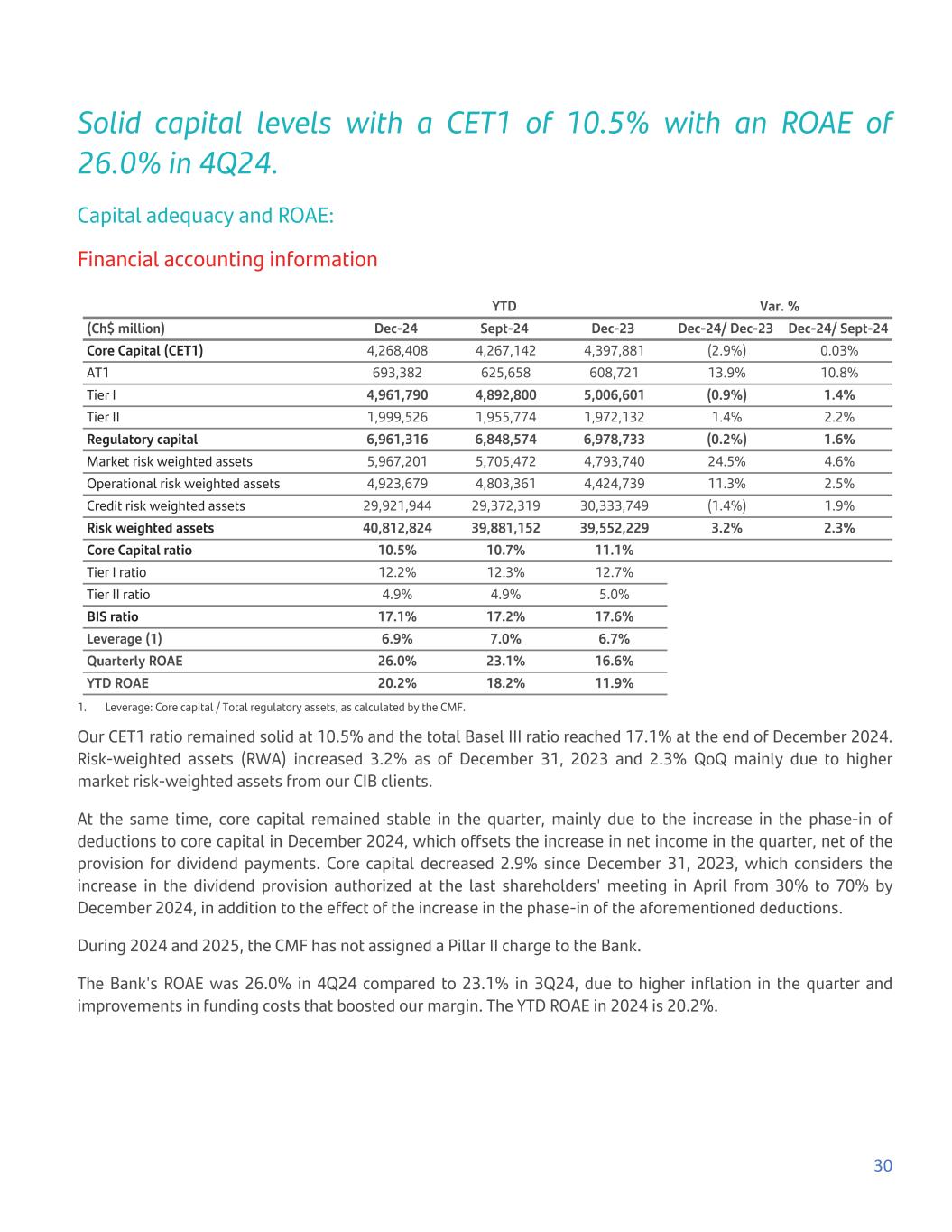
Solid capital levels with a CET1 of 10.5% with an ROAE of 26.0% in 4Q24. Capital adequacy and ROAE: Financial accounting information YTD Var. % (Ch$ million) Dec-24 Sept-24 Dec-23 Dec-24/ Dec-23 Dec-24/ Sept-24 Core Capital (CET1) 4,268,408 4,267,142 4,397,881 (2.9%) 0.03% AT1 693,382 625,658 608,721 13.9% 10.8% Tier I 4,961,790 4,892,800 5,006,601 (0.9%) 1.4% Tier II 1,999,526 1,955,774 1,972,132 1.4% 2.2% Regulatory capital 6,961,316 6,848,574 6,978,733 (0.2%) 1.6% Market risk weighted assets 5,967,201 5,705,472 4,793,740 24.5% 4.6% Operational risk weighted assets 4,923,679 4,803,361 4,424,739 11.3% 2.5% Credit risk weighted assets 29,921,944 29,372,319 30,333,749 (1.4%) 1.9% Risk weighted assets 40,812,824 39,881,152 39,552,229 3.2% 2.3% Core Capital ratio 10.5% 10.7% 11.1% Tier I ratio 12.2% 12.3% 12.7% Tier II ratio 4.9% 4.9% 5.0% BIS ratio 17.1% 17.2% 17.6% Leverage (1) 6.9% 7.0% 6.7% Quarterly ROAE 26.0% 23.1% 16.6% YTD ROAE 20.2% 18.2% 11.9% 1. Leverage: Core capital / Total regulatory assets, as calculated by the CMF. Our CET1 ratio remained solid at 10.5% and the total Basel III ratio reached 17.1% at the end of December 2024. Risk-weighted assets (RWA) increased 3.2% as of December 31, 2023 and 2.3% QoQ mainly due to higher market risk-weighted assets from our CIB clients. At the same time, core capital remained stable in the quarter, mainly due to the increase in the phase-in of deductions to core capital in December 2024, which offsets the increase in net income in the quarter, net of the provision for dividend payments. Core capital decreased 2.9% since December 31, 2023, which considers the increase in the dividend provision authorized at the last shareholders' meeting in April from 30% to 70% by December 2024, in addition to the effect of the increase in the phase-in of the aforementioned deductions. During 2024 and 2025, the CMF has not assigned a Pillar II charge to the Bank. The Bank's ROAE was 26.0% in 4Q24 compared to 23.1% in 3Q24, due to higher inflation in the quarter and improvements in funding costs that boosted our margin. The YTD ROAE in 2024 is 20.2%. 30
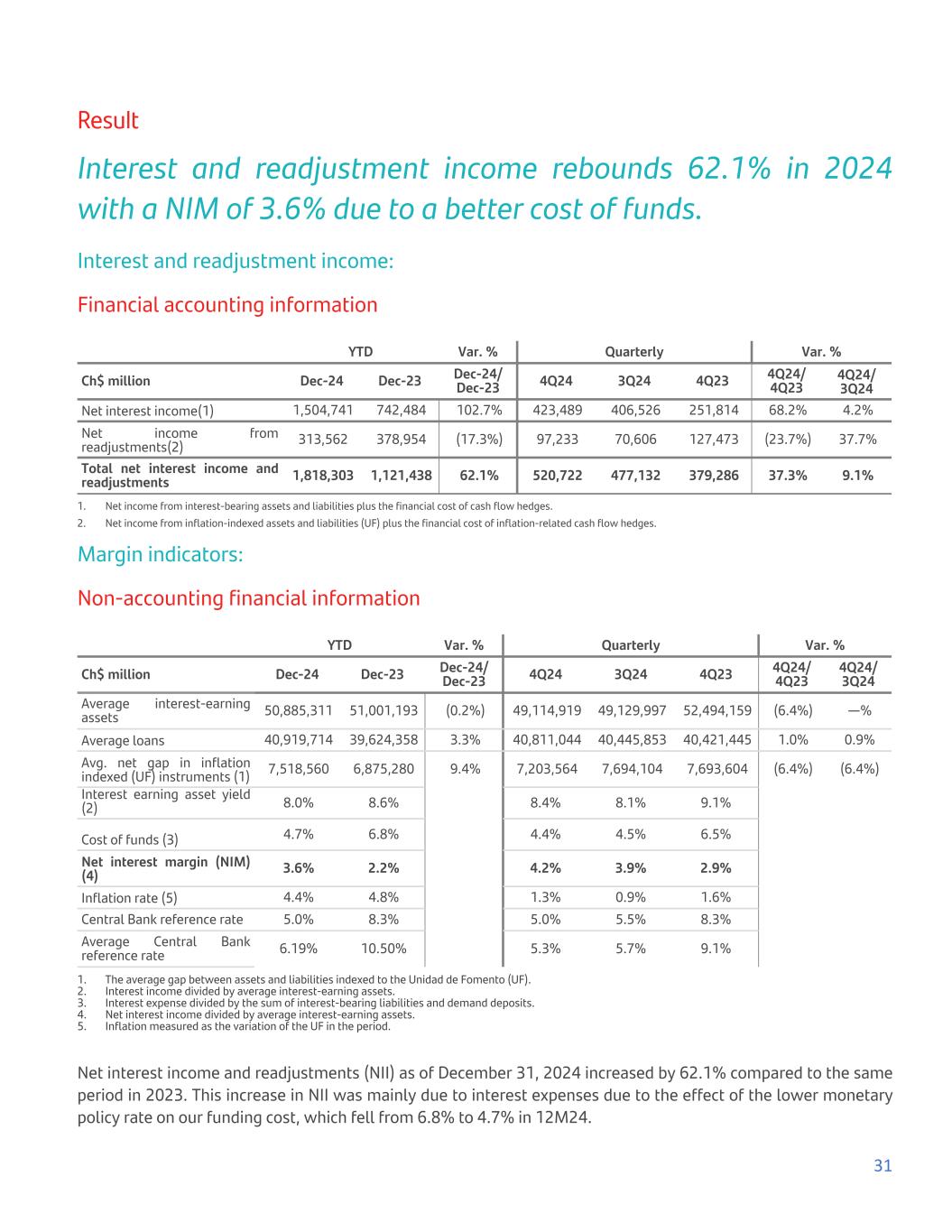
Result Interest and readjustment income rebounds 62.1% in 2024 with a NIM of 3.6% due to a better cost of funds. Interest and readjustment income: Financial accounting information YTD Var. % Quarterly Var. % Ch$ million Dec-24 Dec-23 Dec-24/ Dec-23 4Q24 3Q24 4Q23 4Q24/ 4Q23 4Q24/ 3Q24 Net interest income(1) 1,504,741 742,484 102.7% 423,489 406,526 251,814 68.2% 4.2% Net income from readjustments(2) 313,562 378,954 (17.3%) 97,233 70,606 127,473 (23.7%) 37.7% Total net interest income and readjustments 1,818,303 1,121,438 62.1% 520,722 477,132 379,286 37.3% 9.1% 1. Net income from interest-bearing assets and liabilities plus the financial cost of cash flow hedges. 2. Net income from inflation-indexed assets and liabilities (UF) plus the financial cost of inflation-related cash flow hedges. Margin indicators: Non-accounting financial information YTD Var. % Quarterly Var. % Ch$ million Dec-24 Dec-23 Dec-24/ Dec-23 4Q24 3Q24 4Q23 4Q24/ 4Q23 4Q24/ 3Q24 Average interest-earning assets 50,885,311 51,001,193 (0.2%) 49,114,919 49,129,997 52,494,159 (6.4%) —% Average loans 40,919,714 39,624,358 3.3% 40,811,044 40,445,853 40,421,445 1.0% 0.9% Avg. net gap in inflation indexed (UF) instruments (1) 7,518,560 6,875,280 9.4% 7,203,564 7,694,104 7,693,604 (6.4%) (6.4%) Interest earning asset yield (2) 8.0% 8.6% 8.4% 8.1% 9.1% Cost of funds (3) 4.7% 6.8% 4.4% 4.5% 6.5% Net interest margin (NIM) (4) 3.6% 2.2% 4.2% 3.9% 2.9% Inflation rate (5) 4.4% 4.8% 1.3% 0.9% 1.6% Central Bank reference rate 5.0% 8.3% 5.0% 5.5% 8.3% Average Central Bank reference rate 6.19% 10.50% 5.3% 5.7% 9.1% 1. The average gap between assets and liabilities indexed to the Unidad de Fomento (UF). 2. Interest income divided by average interest-earning assets. 3. Interest expense divided by the sum of interest-bearing liabilities and demand deposits. 4. Net interest income divided by average interest-earning assets. 5. Inflation measured as the variation of the UF in the period. Net interest income and readjustments (NII) as of December 31, 2024 increased by 62.1% compared to the same period in 2023. This increase in NII was mainly due to interest expenses due to the effect of the lower monetary policy rate on our funding cost, which fell from 6.8% to 4.7% in 12M24. 31
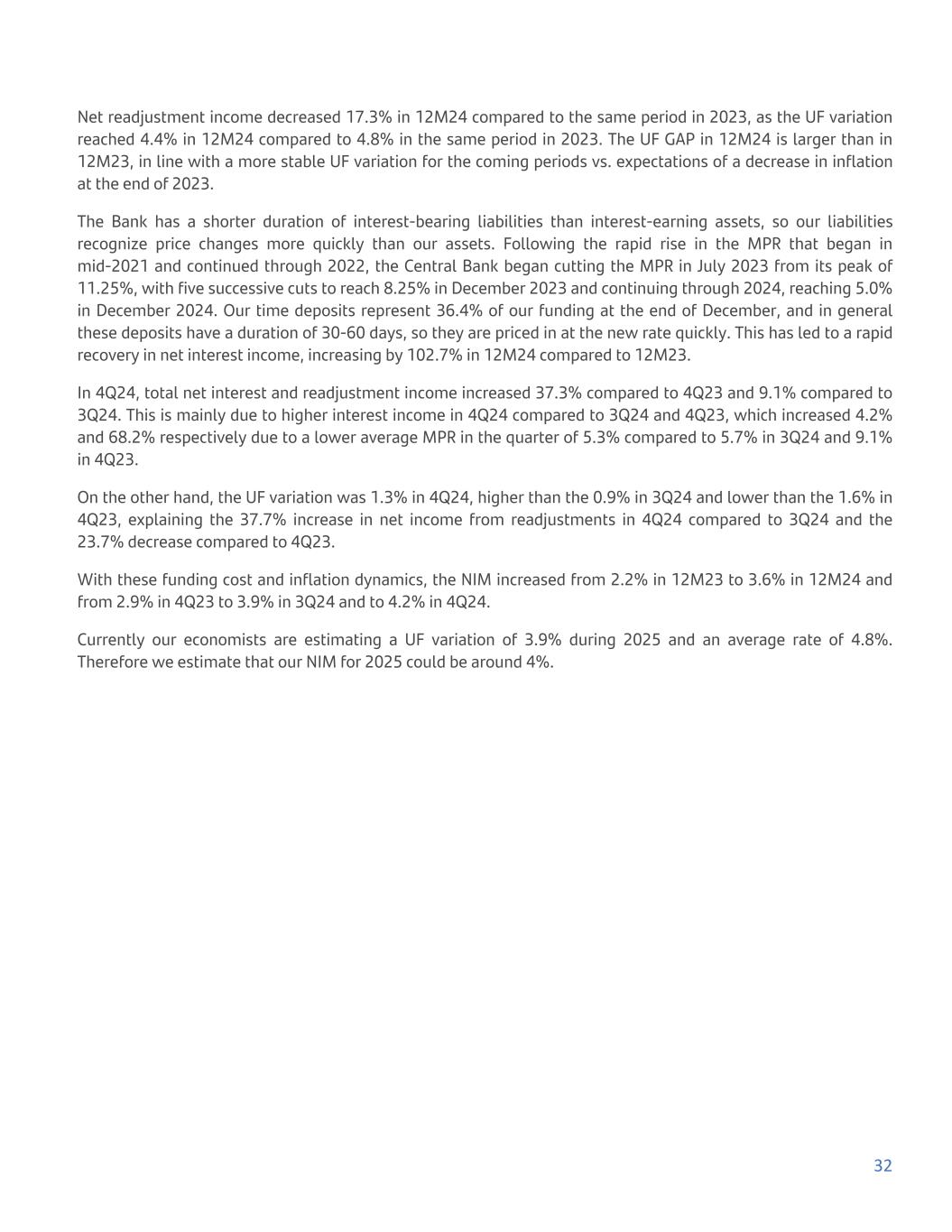
Net readjustment income decreased 17.3% in 12M24 compared to the same period in 2023, as the UF variation reached 4.4% in 12M24 compared to 4.8% in the same period in 2023. The UF GAP in 12M24 is larger than in 12M23, in line with a more stable UF variation for the coming periods vs. expectations of a decrease in inflation at the end of 2023. The Bank has a shorter duration of interest-bearing liabilities than interest-earning assets, so our liabilities recognize price changes more quickly than our assets. Following the rapid rise in the MPR that began in mid-2021 and continued through 2022, the Central Bank began cutting the MPR in July 2023 from its peak of 11.25%, with five successive cuts to reach 8.25% in December 2023 and continuing through 2024, reaching 5.0% in December 2024. Our time deposits represent 36.4% of our funding at the end of December, and in general these deposits have a duration of 30-60 days, so they are priced in at the new rate quickly. This has led to a rapid recovery in net interest income, increasing by 102.7% in 12M24 compared to 12M23. In 4Q24, total net interest and readjustment income increased 37.3% compared to 4Q23 and 9.1% compared to 3Q24. This is mainly due to higher interest income in 4Q24 compared to 3Q24 and 4Q23, which increased 4.2% and 68.2% respectively due to a lower average MPR in the quarter of 5.3% compared to 5.7% in 3Q24 and 9.1% in 4Q23. On the other hand, the UF variation was 1.3% in 4Q24, higher than the 0.9% in 3Q24 and lower than the 1.6% in 4Q23, explaining the 37.7% increase in net income from readjustments in 4Q24 compared to 3Q24 and the 23.7% decrease compared to 4Q23. With these funding cost and inflation dynamics, the NIM increased from 2.2% in 12M23 to 3.6% in 12M24 and from 2.9% in 4Q23 to 3.9% in 3Q24 and to 4.2% in 4Q24. Currently our economists are estimating a UF variation of 3.9% during 2025 and an average rate of 4.8%. Therefore we estimate that our NIM for 2025 could be around 4%. 32
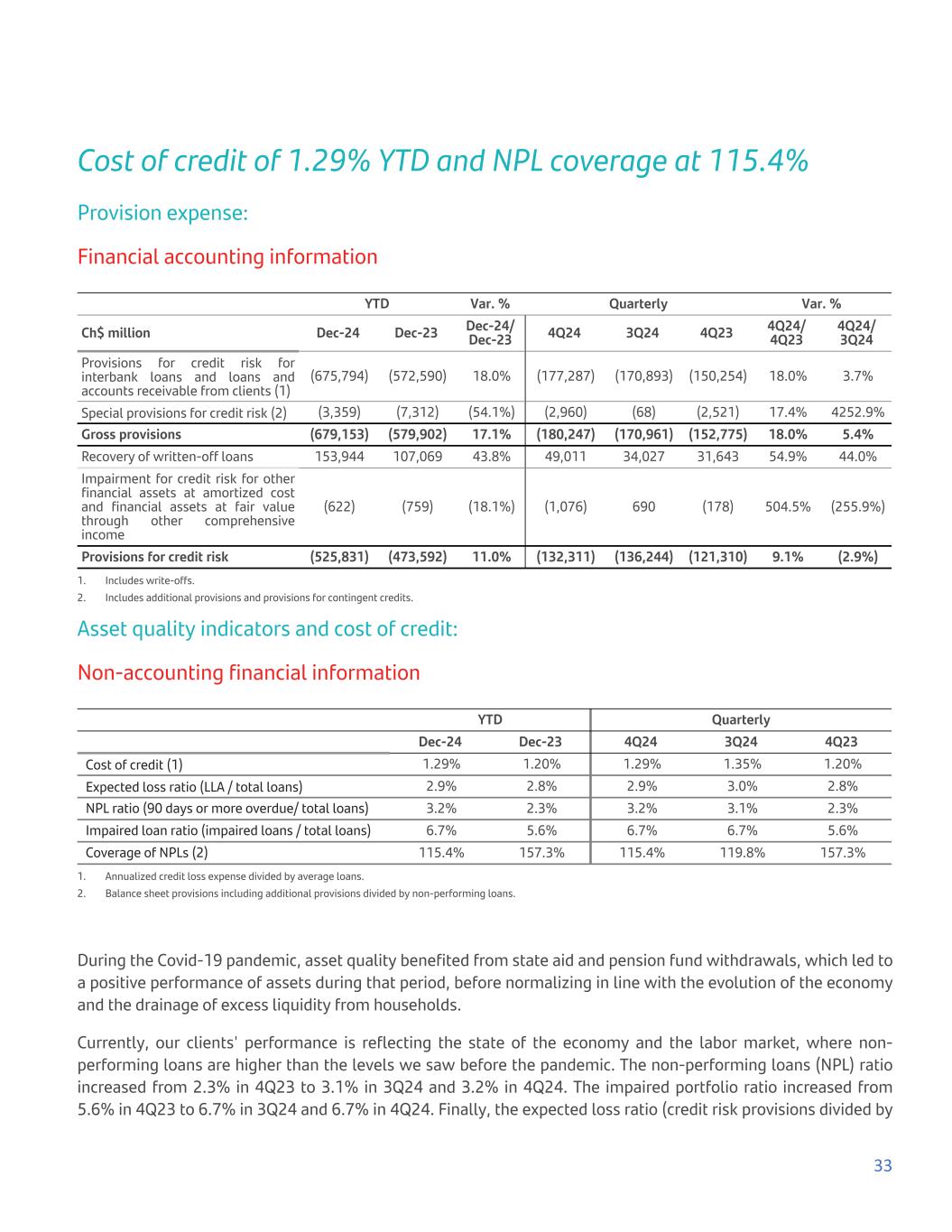
Cost of credit of 1.29% YTD and NPL coverage at 115.4% Provision expense: Financial accounting information YTD Var. % Quarterly Var. % Ch$ million Dec-24 Dec-23 Dec-24/ Dec-23 4Q24 3Q24 4Q23 4Q24/ 4Q23 4Q24/ 3Q24 Provisions for credit risk for interbank loans and loans and accounts receivable from clients (1) (675,794) (572,590) 18.0% (177,287) (170,893) (150,254) 18.0% 3.7% Special provisions for credit risk (2) (3,359) (7,312) (54.1%) (2,960) (68) (2,521) 17.4% 4252.9% Gross provisions (679,153) (579,902) 17.1% (180,247) (170,961) (152,775) 18.0% 5.4% Recovery of written-off loans 153,944 107,069 43.8% 49,011 34,027 31,643 54.9% 44.0% Impairment for credit risk for other financial assets at amortized cost and financial assets at fair value through other comprehensive income (622) (759) (18.1%) (1,076) 690 (178) 504.5% (255.9%) Provisions for credit risk (525,831) (473,592) 11.0% (132,311) (136,244) (121,310) 9.1% (2.9%) 1. Includes write-offs. 2. Includes additional provisions and provisions for contingent credits. Asset quality indicators and cost of credit: Non-accounting financial information YTD Quarterly Dec-24 Dec-23 4Q24 3Q24 4Q23 Cost of credit (1) 1.29% 1.20% 1.29% 1.35% 1.20% Expected loss ratio (LLA / total loans) 2.9% 2.8% 2.9% 3.0% 2.8% NPL ratio (90 days or more overdue/ total loans) 3.2% 2.3% 3.2% 3.1% 2.3% Impaired loan ratio (impaired loans / total loans) 6.7% 5.6% 6.7% 6.7% 5.6% Coverage of NPLs (2) 115.4% 157.3% 115.4% 119.8% 157.3% 1. Annualized credit loss expense divided by average loans. 2. Balance sheet provisions including additional provisions divided by non-performing loans. During the Covid-19 pandemic, asset quality benefited from state aid and pension fund withdrawals, which led to a positive performance of assets during that period, before normalizing in line with the evolution of the economy and the drainage of excess liquidity from households. Currently, our clients' performance is reflecting the state of the economy and the labor market, where non- performing loans are higher than the levels we saw before the pandemic. The non-performing loans (NPL) ratio increased from 2.3% in 4Q23 to 3.1% in 3Q24 and 3.2% in 4Q24. The impaired portfolio ratio increased from 5.6% in 4Q23 to 6.7% in 3Q24 and 6.7% in 4Q24. Finally, the expected loss ratio (credit risk provisions divided by 33
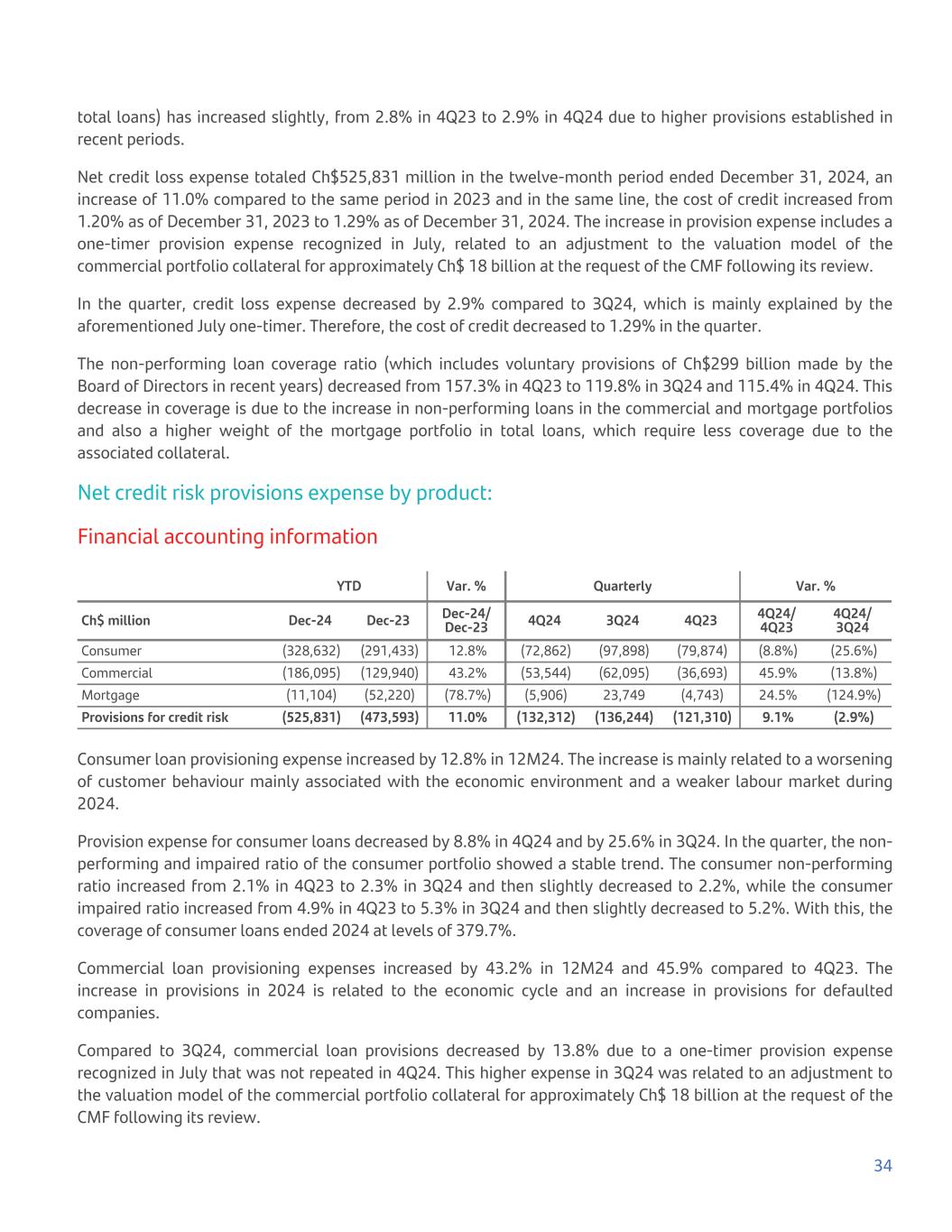
total loans) has increased slightly, from 2.8% in 4Q23 to 2.9% in 4Q24 due to higher provisions established in recent periods. Net credit loss expense totaled Ch$525,831 million in the twelve-month period ended December 31, 2024, an increase of 11.0% compared to the same period in 2023 and in the same line, the cost of credit increased from 1.20% as of December 31, 2023 to 1.29% as of December 31, 2024. The increase in provision expense includes a one-timer provision expense recognized in July, related to an adjustment to the valuation model of the commercial portfolio collateral for approximately Ch$ 18 billion at the request of the CMF following its review. In the quarter, credit loss expense decreased by 2.9% compared to 3Q24, which is mainly explained by the aforementioned July one-timer. Therefore, the cost of credit decreased to 1.29% in the quarter. The non-performing loan coverage ratio (which includes voluntary provisions of Ch$299 billion made by the Board of Directors in recent years) decreased from 157.3% in 4Q23 to 119.8% in 3Q24 and 115.4% in 4Q24. This decrease in coverage is due to the increase in non-performing loans in the commercial and mortgage portfolios and also a higher weight of the mortgage portfolio in total loans, which require less coverage due to the associated collateral. Net credit risk provisions expense by product: Financial accounting information YTD Var. % Quarterly Var. % Ch$ million Dec-24 Dec-23 Dec-24/ Dec-23 4Q24 3Q24 4Q23 4Q24/ 4Q23 4Q24/ 3Q24 Consumer (328,632) (291,433) 12.8% (72,862) (97,898) (79,874) (8.8%) (25.6%) Commercial (186,095) (129,940) 43.2% (53,544) (62,095) (36,693) 45.9% (13.8%) Mortgage (11,104) (52,220) (78.7%) (5,906) 23,749 (4,743) 24.5% (124.9%) Provisions for credit risk (525,831) (473,593) 11.0% (132,312) (136,244) (121,310) 9.1% (2.9%) Consumer loan provisioning expense increased by 12.8% in 12M24. The increase is mainly related to a worsening of customer behaviour mainly associated with the economic environment and a weaker labour market during 2024. Provision expense for consumer loans decreased by 8.8% in 4Q24 and by 25.6% in 3Q24. In the quarter, the non- performing and impaired ratio of the consumer portfolio showed a stable trend. The consumer non-performing ratio increased from 2.1% in 4Q23 to 2.3% in 3Q24 and then slightly decreased to 2.2%, while the consumer impaired ratio increased from 4.9% in 4Q23 to 5.3% in 3Q24 and then slightly decreased to 5.2%. With this, the coverage of consumer loans ended 2024 at levels of 379.7%. Commercial loan provisioning expenses increased by 43.2% in 12M24 and 45.9% compared to 4Q23. The increase in provisions in 2024 is related to the economic cycle and an increase in provisions for defaulted companies. Compared to 3Q24, commercial loan provisions decreased by 13.8% due to a one-timer provision expense recognized in July that was not repeated in 4Q24. This higher expense in 3Q24 was related to an adjustment to the valuation model of the commercial portfolio collateral for approximately Ch$ 18 billion at the request of the CMF following its review. 34
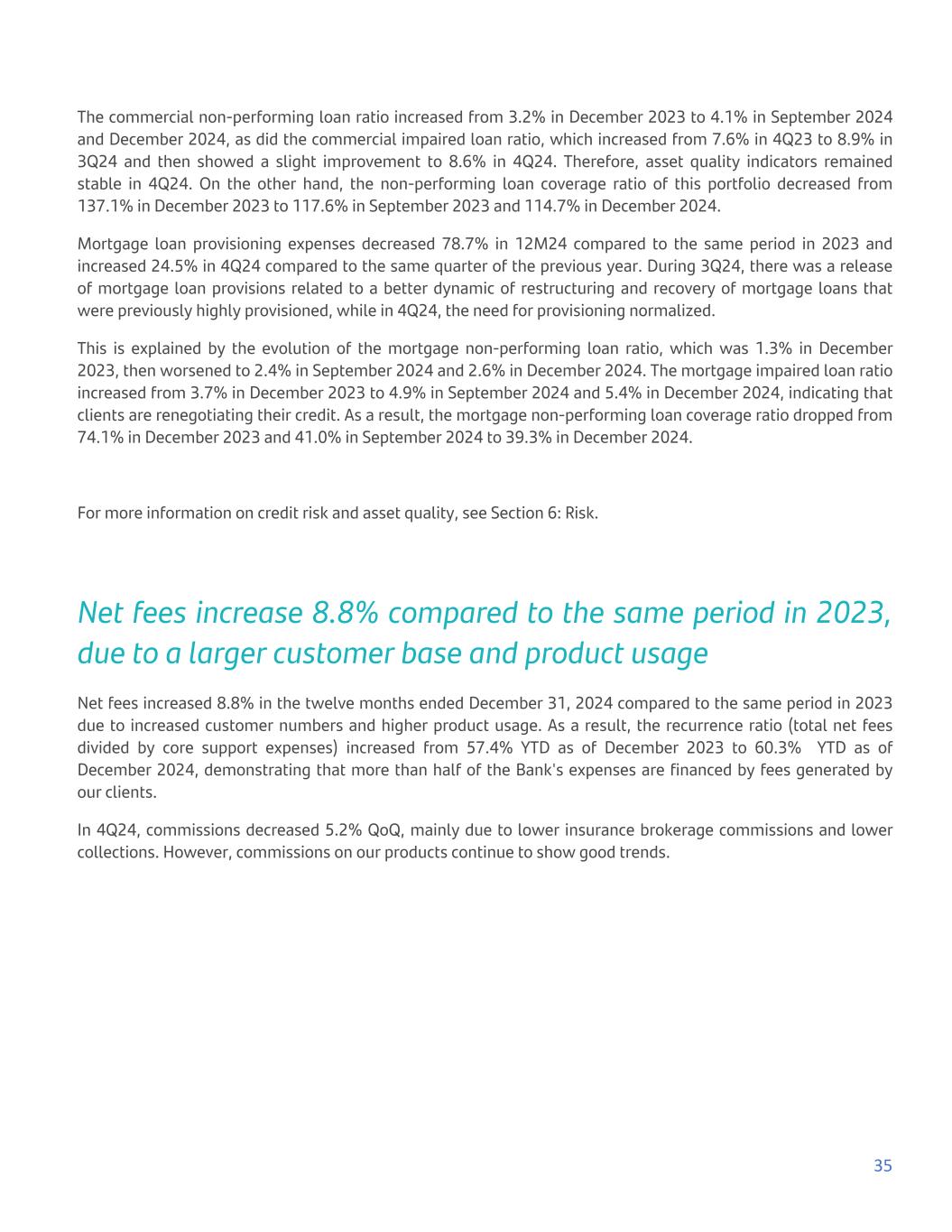
The commercial non-performing loan ratio increased from 3.2% in December 2023 to 4.1% in September 2024 and December 2024, as did the commercial impaired loan ratio, which increased from 7.6% in 4Q23 to 8.9% in 3Q24 and then showed a slight improvement to 8.6% in 4Q24. Therefore, asset quality indicators remained stable in 4Q24. On the other hand, the non-performing loan coverage ratio of this portfolio decreased from 137.1% in December 2023 to 117.6% in September 2023 and 114.7% in December 2024. Mortgage loan provisioning expenses decreased 78.7% in 12M24 compared to the same period in 2023 and increased 24.5% in 4Q24 compared to the same quarter of the previous year. During 3Q24, there was a release of mortgage loan provisions related to a better dynamic of restructuring and recovery of mortgage loans that were previously highly provisioned, while in 4Q24, the need for provisioning normalized. This is explained by the evolution of the mortgage non-performing loan ratio, which was 1.3% in December 2023, then worsened to 2.4% in September 2024 and 2.6% in December 2024. The mortgage impaired loan ratio increased from 3.7% in December 2023 to 4.9% in September 2024 and 5.4% in December 2024, indicating that clients are renegotiating their credit. As a result, the mortgage non-performing loan coverage ratio dropped from 74.1% in December 2023 and 41.0% in September 2024 to 39.3% in December 2024. For more information on credit risk and asset quality, see Section 6: Risk. Net fees increase 8.8% compared to the same period in 2023, due to a larger customer base and product usage Net fees increased 8.8% in the twelve months ended December 31, 2024 compared to the same period in 2023 due to increased customer numbers and higher product usage. As a result, the recurrence ratio (total net fees divided by core support expenses) increased from 57.4% YTD as of December 2023 to 60.3% YTD as of December 2024, demonstrating that more than half of the Bank's expenses are financed by fees generated by our clients. In 4Q24, commissions decreased 5.2% QoQ, mainly due to lower insurance brokerage commissions and lower collections. However, commissions on our products continue to show good trends. 35
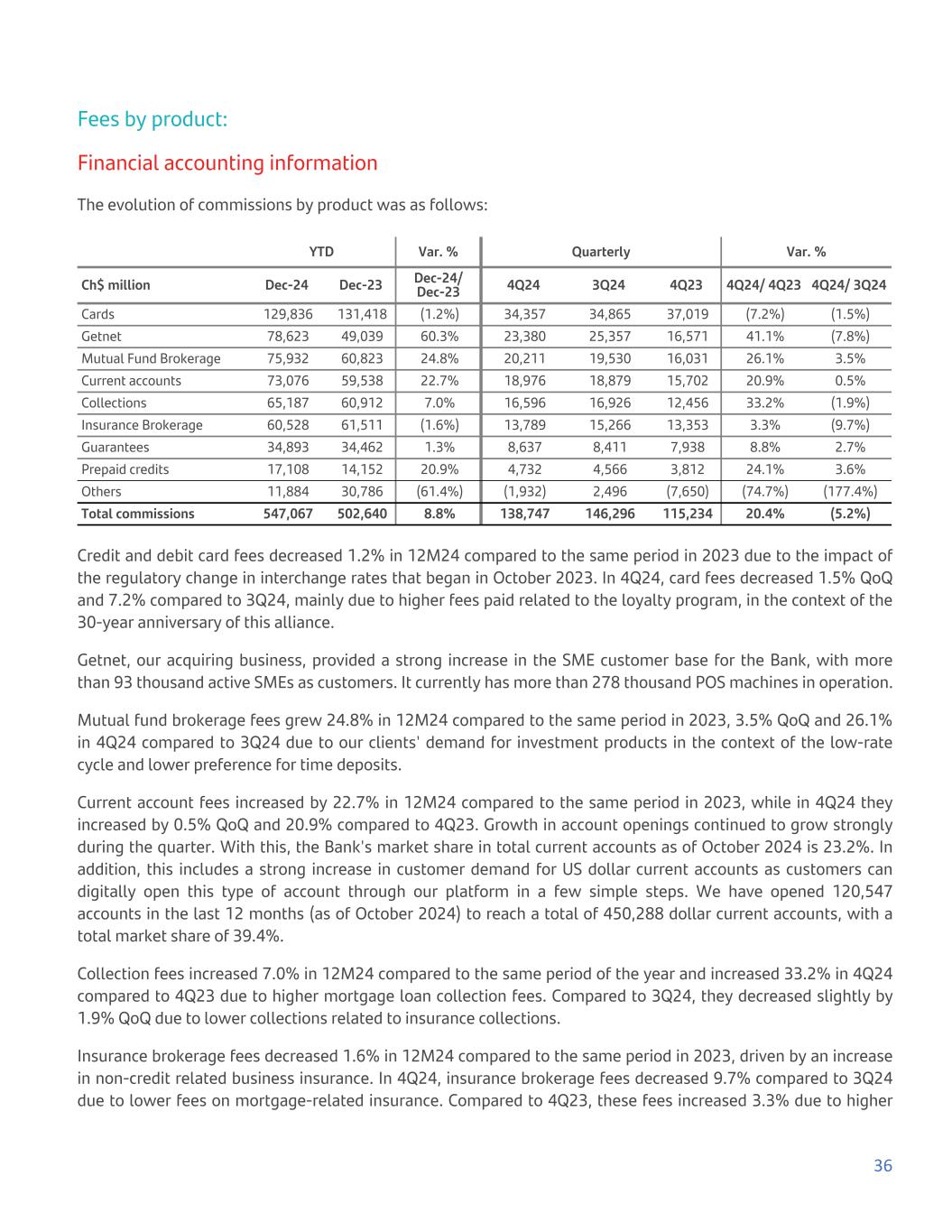
Fees by product: Financial accounting information The evolution of commissions by product was as follows: YTD Var. % Quarterly Var. % Ch$ million Dec-24 Dec-23 Dec-24/ Dec-23 4Q24 3Q24 4Q23 4Q24/ 4Q23 4Q24/ 3Q24 Cards 129,836 131,418 (1.2%) 34,357 34,865 37,019 (7.2%) (1.5%) Getnet 78,623 49,039 60.3% 23,380 25,357 16,571 41.1% (7.8%) Mutual Fund Brokerage 75,932 60,823 24.8% 20,211 19,530 16,031 26.1% 3.5% Current accounts 73,076 59,538 22.7% 18,976 18,879 15,702 20.9% 0.5% Collections 65,187 60,912 7.0% 16,596 16,926 12,456 33.2% (1.9%) Insurance Brokerage 60,528 61,511 (1.6%) 13,789 15,266 13,353 3.3% (9.7%) Guarantees 34,893 34,462 1.3% 8,637 8,411 7,938 8.8% 2.7% Prepaid credits 17,108 14,152 20.9% 4,732 4,566 3,812 24.1% 3.6% Others 11,884 30,786 (61.4%) (1,932) 2,496 (7,650) (74.7%) (177.4%) Total commissions 547,067 502,640 8.8% 138,747 146,296 115,234 20.4% (5.2%) Credit and debit card fees decreased 1.2% in 12M24 compared to the same period in 2023 due to the impact of the regulatory change in interchange rates that began in October 2023. In 4Q24, card fees decreased 1.5% QoQ and 7.2% compared to 3Q24, mainly due to higher fees paid related to the loyalty program, in the context of the 30-year anniversary of this alliance. Getnet, our acquiring business, provided a strong increase in the SME customer base for the Bank, with more than 93 thousand active SMEs as customers. It currently has more than 278 thousand POS machines in operation. Mutual fund brokerage fees grew 24.8% in 12M24 compared to the same period in 2023, 3.5% QoQ and 26.1% in 4Q24 compared to 3Q24 due to our clients' demand for investment products in the context of the low-rate cycle and lower preference for time deposits. Current account fees increased by 22.7% in 12M24 compared to the same period in 2023, while in 4Q24 they increased by 0.5% QoQ and 20.9% compared to 4Q23. Growth in account openings continued to grow strongly during the quarter. With this, the Bank's market share in total current accounts as of October 2024 is 23.2%. In addition, this includes a strong increase in customer demand for US dollar current accounts as customers can digitally open this type of account through our platform in a few simple steps. We have opened 120,547 accounts in the last 12 months (as of October 2024) to reach a total of 450,288 dollar current accounts, with a total market share of 39.4%. Collection fees increased 7.0% in 12M24 compared to the same period of the year and increased 33.2% in 4Q24 compared to 4Q23 due to higher mortgage loan collection fees. Compared to 3Q24, they decreased slightly by 1.9% QoQ due to lower collections related to insurance collections. Insurance brokerage fees decreased 1.6% in 12M24 compared to the same period in 2023, driven by an increase in non-credit related business insurance. In 4Q24, insurance brokerage fees decreased 9.7% compared to 3Q24 due to lower fees on mortgage-related insurance. Compared to 4Q23, these fees increased 3.3% due to higher 36
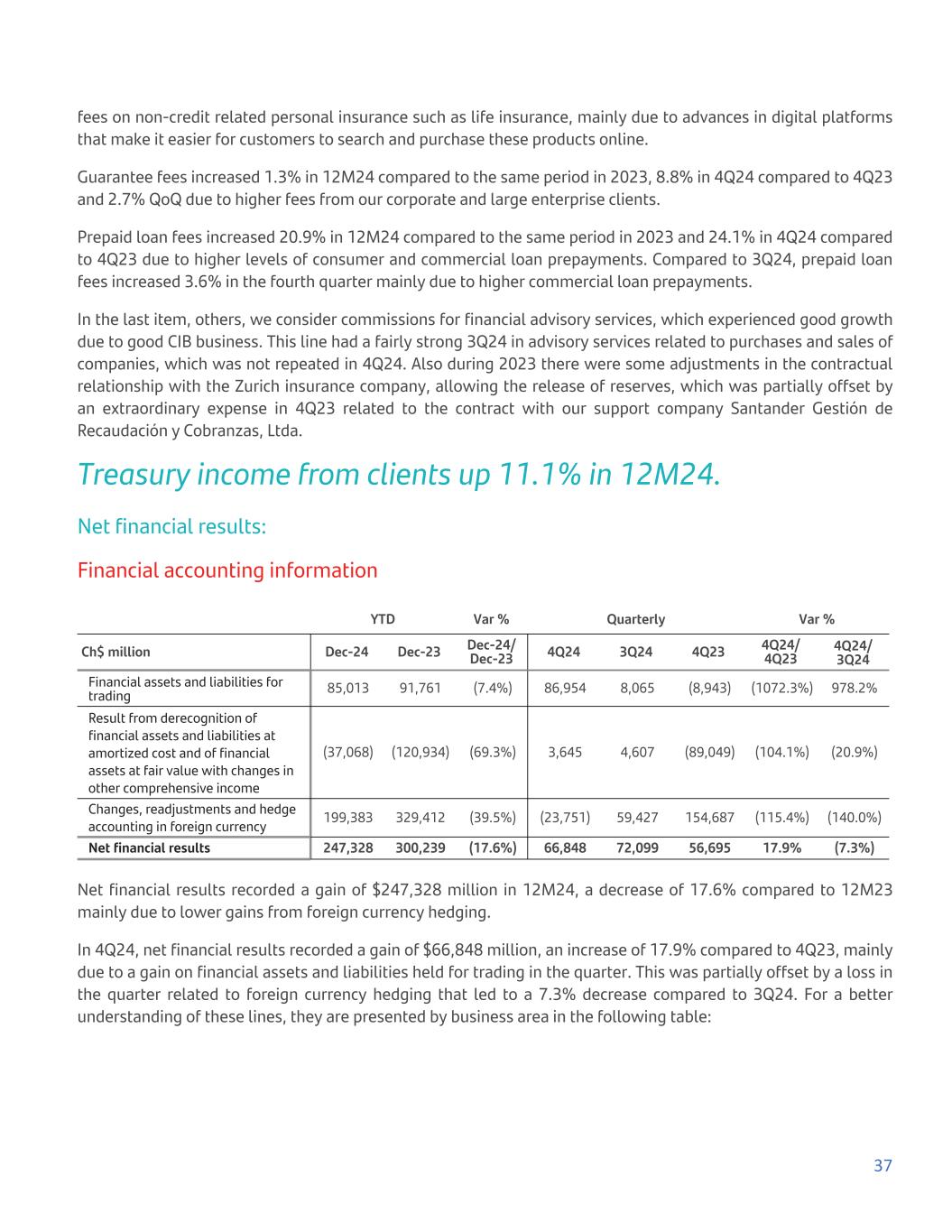
fees on non-credit related personal insurance such as life insurance, mainly due to advances in digital platforms that make it easier for customers to search and purchase these products online. Guarantee fees increased 1.3% in 12M24 compared to the same period in 2023, 8.8% in 4Q24 compared to 4Q23 and 2.7% QoQ due to higher fees from our corporate and large enterprise clients. Prepaid loan fees increased 20.9% in 12M24 compared to the same period in 2023 and 24.1% in 4Q24 compared to 4Q23 due to higher levels of consumer and commercial loan prepayments. Compared to 3Q24, prepaid loan fees increased 3.6% in the fourth quarter mainly due to higher commercial loan prepayments. In the last item, others, we consider commissions for financial advisory services, which experienced good growth due to good CIB business. This line had a fairly strong 3Q24 in advisory services related to purchases and sales of companies, which was not repeated in 4Q24. Also during 2023 there were some adjustments in the contractual relationship with the Zurich insurance company, allowing the release of reserves, which was partially offset by an extraordinary expense in 4Q23 related to the contract with our support company Santander Gestión de Recaudación y Cobranzas, Ltda. Treasury income from clients up 11.1% in 12M24. Net financial results: Financial accounting information YTD Var % Quarterly Var % Ch$ million Dec-24 Dec-23 Dec-24/ Dec-23 4Q24 3Q24 4Q23 4Q24/ 4Q23 4Q24/ 3Q24 Financial assets and liabilities for trading 85,013 91,761 (7.4%) 86,954 8,065 (8,943) (1072.3%) 978.2% Result from derecognition of financial assets and liabilities at amortized cost and of financial assets at fair value with changes in other comprehensive income (37,068) (120,934) (69.3%) 3,645 4,607 (89,049) (104.1%) (20.9%) Changes, readjustments and hedge accounting in foreign currency 199,383 329,412 (39.5%) (23,751) 59,427 154,687 (115.4%) (140.0%) Net financial results 247,328 300,239 (17.6%) 66,848 72,099 56,695 17.9% (7.3%) Net financial results recorded a gain of $247,328 million in 12M24, a decrease of 17.6% compared to 12M23 mainly due to lower gains from foreign currency hedging. In 4Q24, net financial results recorded a gain of $66,848 million, an increase of 17.9% compared to 4Q23, mainly due to a gain on financial assets and liabilities held for trading in the quarter. This was partially offset by a loss in the quarter related to foreign currency hedging that led to a 7.3% decrease compared to 3Q24. For a better understanding of these lines, they are presented by business area in the following table: 37
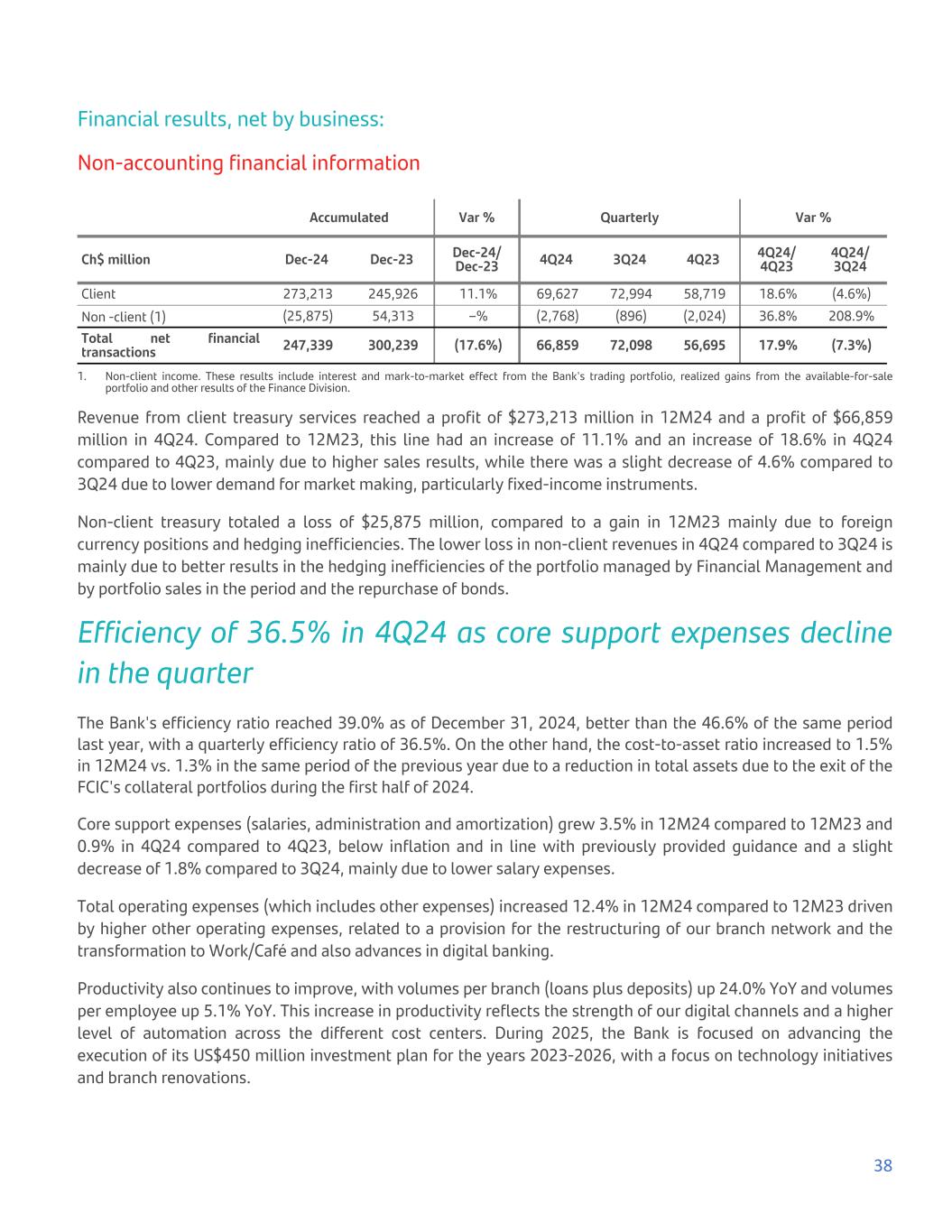
Financial results, net by business: Non-accounting financial information Accumulated Var % Quarterly Var % Ch$ million Dec-24 Dec-23 Dec-24/ Dec-23 4Q24 3Q24 4Q23 4Q24/ 4Q23 4Q24/ 3Q24 Client 273,213 245,926 11.1% 69,627 72,994 58,719 18.6% (4.6%) Non -client (1) (25,875) 54,313 –% (2,768) (896) (2,024) 36.8% 208.9% Total net financial transactions 247,339 300,239 (17.6%) 66,859 72,098 56,695 17.9% (7.3%) 1. Non-client income. These results include interest and mark-to-market effect from the Bank's trading portfolio, realized gains from the available-for-sale portfolio and other results of the Finance Division. Revenue from client treasury services reached a profit of $273,213 million in 12M24 and a profit of $66,859 million in 4Q24. Compared to 12M23, this line had an increase of 11.1% and an increase of 18.6% in 4Q24 compared to 4Q23, mainly due to higher sales results, while there was a slight decrease of 4.6% compared to 3Q24 due to lower demand for market making, particularly fixed-income instruments. Non-client treasury totaled a loss of $25,875 million, compared to a gain in 12M23 mainly due to foreign currency positions and hedging inefficiencies. The lower loss in non-client revenues in 4Q24 compared to 3Q24 is mainly due to better results in the hedging inefficiencies of the portfolio managed by Financial Management and by portfolio sales in the period and the repurchase of bonds. Efficiency of 36.5% in 4Q24 as core support expenses decline in the quarter The Bank's efficiency ratio reached 39.0% as of December 31, 2024, better than the 46.6% of the same period last year, with a quarterly efficiency ratio of 36.5%. On the other hand, the cost-to-asset ratio increased to 1.5% in 12M24 vs. 1.3% in the same period of the previous year due to a reduction in total assets due to the exit of the FCIC's collateral portfolios during the first half of 2024. Core support expenses (salaries, administration and amortization) grew 3.5% in 12M24 compared to 12M23 and 0.9% in 4Q24 compared to 4Q23, below inflation and in line with previously provided guidance and a slight decrease of 1.8% compared to 3Q24, mainly due to lower salary expenses. Total operating expenses (which includes other expenses) increased 12.4% in 12M24 compared to 12M23 driven by higher other operating expenses, related to a provision for the restructuring of our branch network and the transformation to Work/Café and also advances in digital banking. Productivity also continues to improve, with volumes per branch (loans plus deposits) up 24.0% YoY and volumes per employee up 5.1% YoY. This increase in productivity reflects the strength of our digital channels and a higher level of automation across the different cost centers. During 2025, the Bank is focused on advancing the execution of its US$450 million investment plan for the years 2023-2026, with a focus on technology initiatives and branch renovations. 38
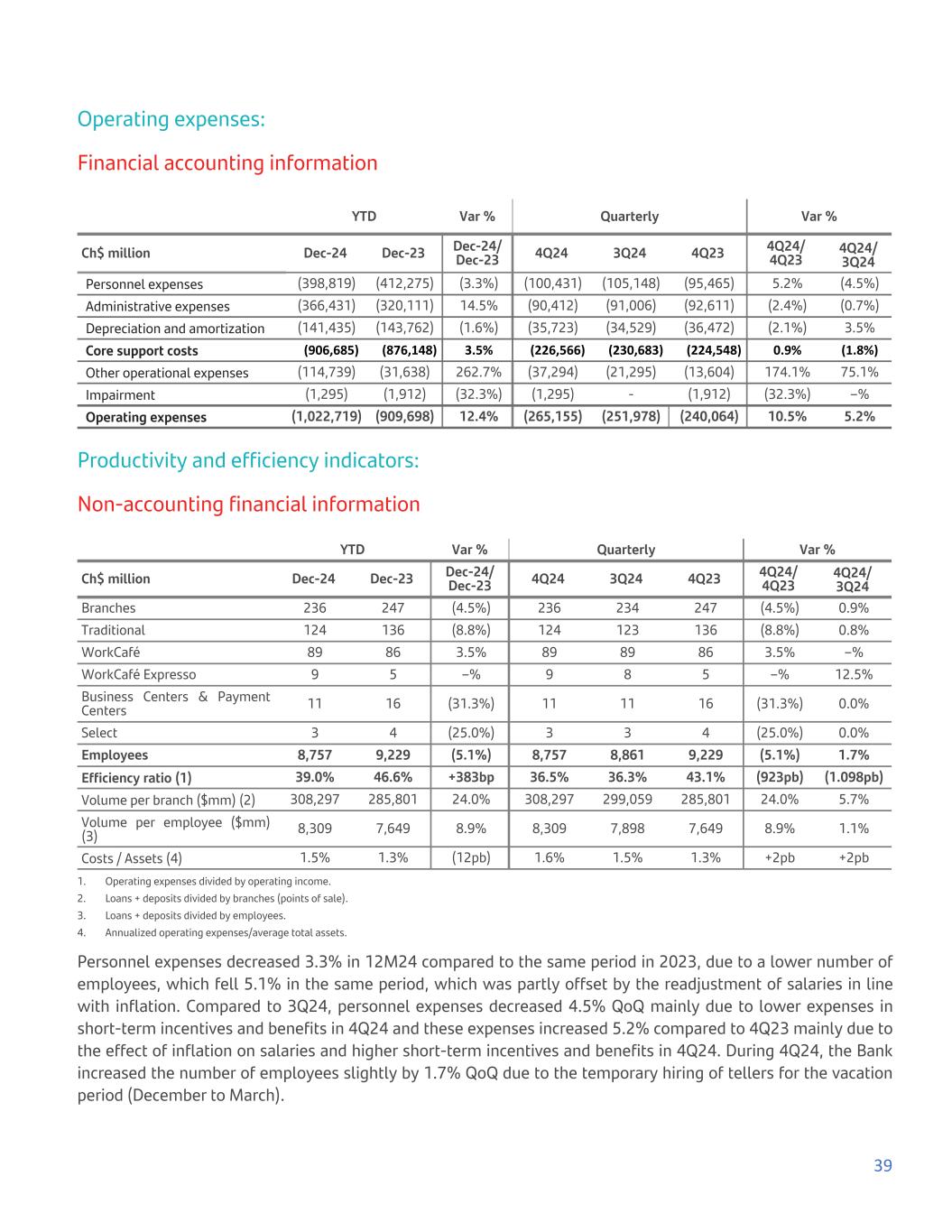
Operating expenses: Financial accounting information YTD Var % Quarterly Var % Ch$ million Dec-24 Dec-23 Dec-24/ Dec-23 4Q24 3Q24 4Q23 4Q24/ 4Q23 4Q24/ 3Q24 Personnel expenses (398,819) (412,275) (3.3%) (100,431) (105,148) (95,465) 5.2% (4.5%) Administrative expenses (366,431) (320,111) 14.5% (90,412) (91,006) (92,611) (2.4%) (0.7%) Depreciation and amortization (141,435) (143,762) (1.6%) (35,723) (34,529) (36,472) (2.1%) 3.5% Core support costs (906,685) (876,148) 3.5% (226,566) (230,683) (224,548) 0.9% (1.8%) Other operational expenses (114,739) (31,638) 262.7% (37,294) (21,295) (13,604) 174.1% 75.1% Impairment (1,295) (1,912) (32.3%) (1,295) - (1,912) (32.3%) –% Operating expenses (1,022,719) (909,698) 12.4% (265,155) (251,978) (240,064) 10.5% 5.2% Productivity and efficiency indicators: Non-accounting financial information YTD Var % Quarterly Var % Ch$ million Dec-24 Dec-23 Dec-24/ Dec-23 4Q24 3Q24 4Q23 4Q24/ 4Q23 4Q24/ 3Q24 Branches 236 247 (4.5%) 236 234 247 (4.5%) 0.9% Traditional 124 136 (8.8%) 124 123 136 (8.8%) 0.8% WorkCafé 89 86 3.5% 89 89 86 3.5% –% WorkCafé Expresso 9 5 –% 9 8 5 –% 12.5% Business Centers & Payment Centers 11 16 (31.3%) 11 11 16 (31.3%) 0.0% Select 3 4 (25.0%) 3 3 4 (25.0%) 0.0% Employees 8,757 9,229 (5.1%) 8,757 8,861 9,229 (5.1%) 1.7% Efficiency ratio (1) 39.0% 46.6% +383bp 36.5% 36.3% 43.1% (923pb) (1.098pb) Volume per branch ($mm) (2) 308,297 285,801 24.0% 308,297 299,059 285,801 24.0% 5.7% Volume per employee ($mm) (3) 8,309 7,649 8.9% 8,309 7,898 7,649 8.9% 1.1% Costs / Assets (4) 1.5% 1.3% (12pb) 1.6% 1.5% 1.3% +2pb +2pb 1. Operating expenses divided by operating income. 2. Loans + deposits divided by branches (points of sale). 3. Loans + deposits divided by employees. 4. Annualized operating expenses/average total assets. Personnel expenses decreased 3.3% in 12M24 compared to the same period in 2023, due to a lower number of employees, which fell 5.1% in the same period, which was partly offset by the readjustment of salaries in line with inflation. Compared to 3Q24, personnel expenses decreased 4.5% QoQ mainly due to lower expenses in short-term incentives and benefits in 4Q24 and these expenses increased 5.2% compared to 4Q23 mainly due to the effect of inflation on salaries and higher short-term incentives and benefits in 4Q24. During 4Q24, the Bank increased the number of employees slightly by 1.7% QoQ due to the temporary hiring of tellers for the vacation period (December to March). 39
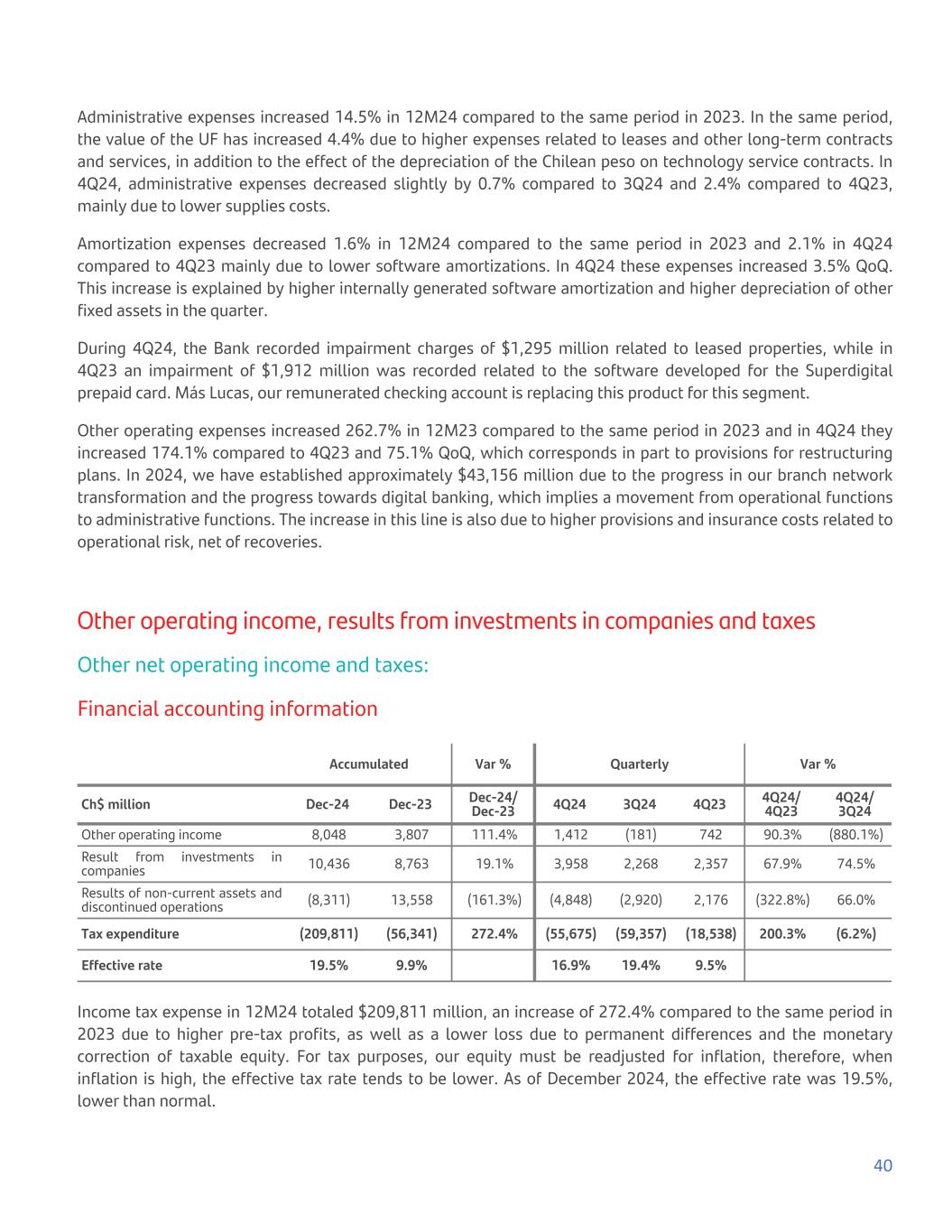
Administrative expenses increased 14.5% in 12M24 compared to the same period in 2023. In the same period, the value of the UF has increased 4.4% due to higher expenses related to leases and other long-term contracts and services, in addition to the effect of the depreciation of the Chilean peso on technology service contracts. In 4Q24, administrative expenses decreased slightly by 0.7% compared to 3Q24 and 2.4% compared to 4Q23, mainly due to lower supplies costs. Amortization expenses decreased 1.6% in 12M24 compared to the same period in 2023 and 2.1% in 4Q24 compared to 4Q23 mainly due to lower software amortizations. In 4Q24 these expenses increased 3.5% QoQ. This increase is explained by higher internally generated software amortization and higher depreciation of other fixed assets in the quarter. During 4Q24, the Bank recorded impairment charges of $1,295 million related to leased properties, while in 4Q23 an impairment of $1,912 million was recorded related to the software developed for the Superdigital prepaid card. Más Lucas, our remunerated checking account is replacing this product for this segment. Other operating expenses increased 262.7% in 12M23 compared to the same period in 2023 and in 4Q24 they increased 174.1% compared to 4Q23 and 75.1% QoQ, which corresponds in part to provisions for restructuring plans. In 2024, we have established approximately $43,156 million due to the progress in our branch network transformation and the progress towards digital banking, which implies a movement from operational functions to administrative functions. The increase in this line is also due to higher provisions and insurance costs related to operational risk, net of recoveries. Other operating income, results from investments in companies and taxes Other net operating income and taxes: Financial accounting information Accumulated Var % Quarterly Var % Ch$ million Dec-24 Dec-23 Dec-24/ Dec-23 4Q24 3Q24 4Q23 4Q24/ 4Q23 4Q24/ 3Q24 Other operating income 8,048 3,807 111.4% 1,412 (181) 742 90.3% (880.1%) Result from investments in companies 10,436 8,763 19.1% 3,958 2,268 2,357 67.9% 74.5% Results of non-current assets and discontinued operations (8,311) 13,558 (161.3%) (4,848) (2,920) 2,176 (322.8%) 66.0% Tax expenditure (209,811) (56,341) 272.4% (55,675) (59,357) (18,538) 200.3% (6.2%) Effective rate 19.5% 9.9% 16.9% 19.4% 9.5% Income tax expense in 12M24 totaled $209,811 million, an increase of 272.4% compared to the same period in 2023 due to higher pre-tax profits, as well as a lower loss due to permanent differences and the monetary correction of taxable equity. For tax purposes, our equity must be readjusted for inflation, therefore, when inflation is high, the effective tax rate tends to be lower. As of December 2024, the effective rate was 19.5%, lower than normal. 40
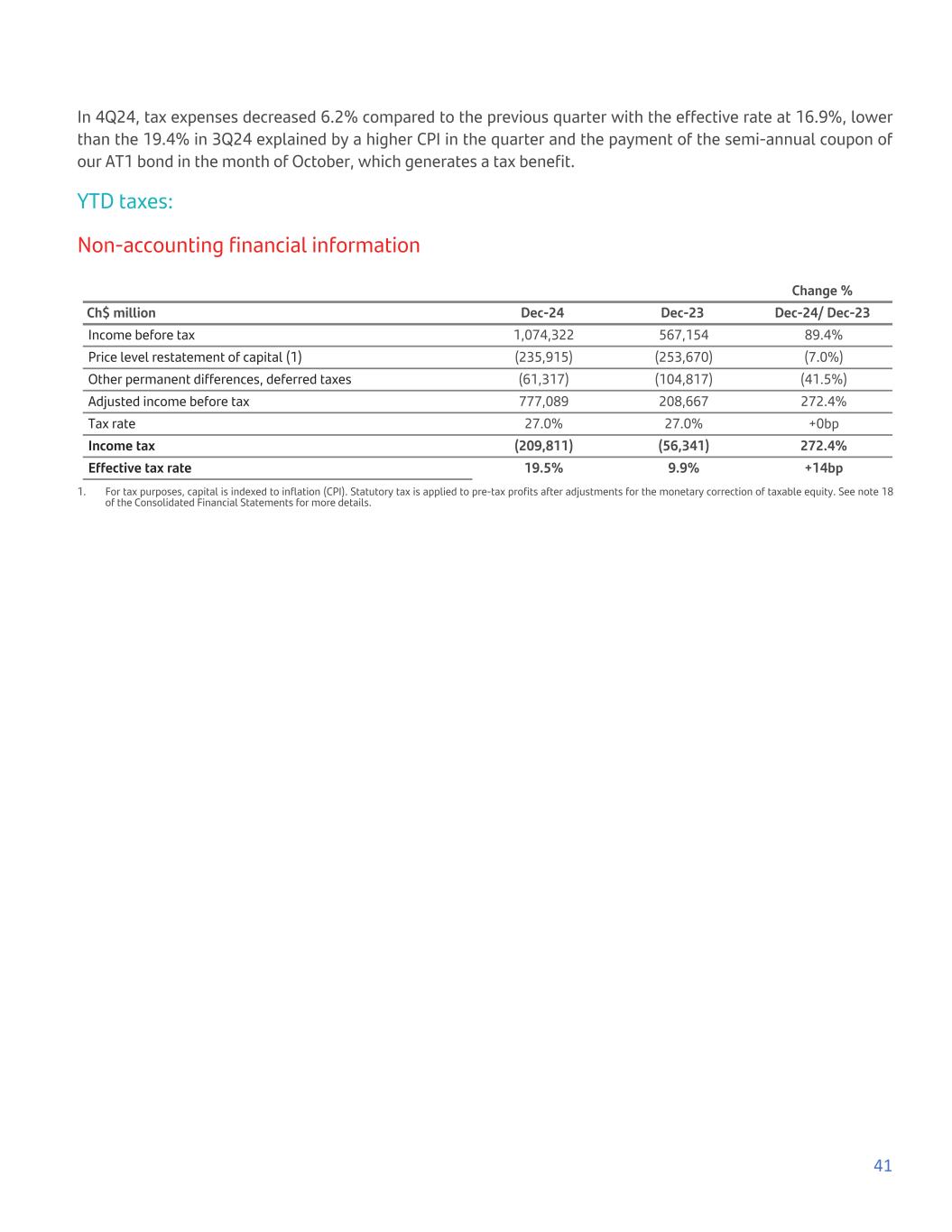
In 4Q24, tax expenses decreased 6.2% compared to the previous quarter with the effective rate at 16.9%, lower than the 19.4% in 3Q24 explained by a higher CPI in the quarter and the payment of the semi-annual coupon of our AT1 bond in the month of October, which generates a tax benefit. YTD taxes: Non-accounting financial information Change % Ch$ million Dec-24 Dec-23 Dec-24/ Dec-23 Income before tax 1,074,322 567,154 89.4% Price level restatement of capital (1) (235,915) (253,670) (7.0%) Other permanent differences, deferred taxes (61,317) (104,817) (41.5%) Adjusted income before tax 777,089 208,667 272.4% Tax rate 27.0% 27.0% +0bp Income tax (209,811) (56,341) 272.4% Effective tax rate 19.5% 9.9% +14bp 1. For tax purposes, capital is indexed to inflation (CPI). Statutory tax is applied to pre-tax profits after adjustments for the monetary correction of taxable equity. See note 18 of the Consolidated Financial Statements for more details. 41
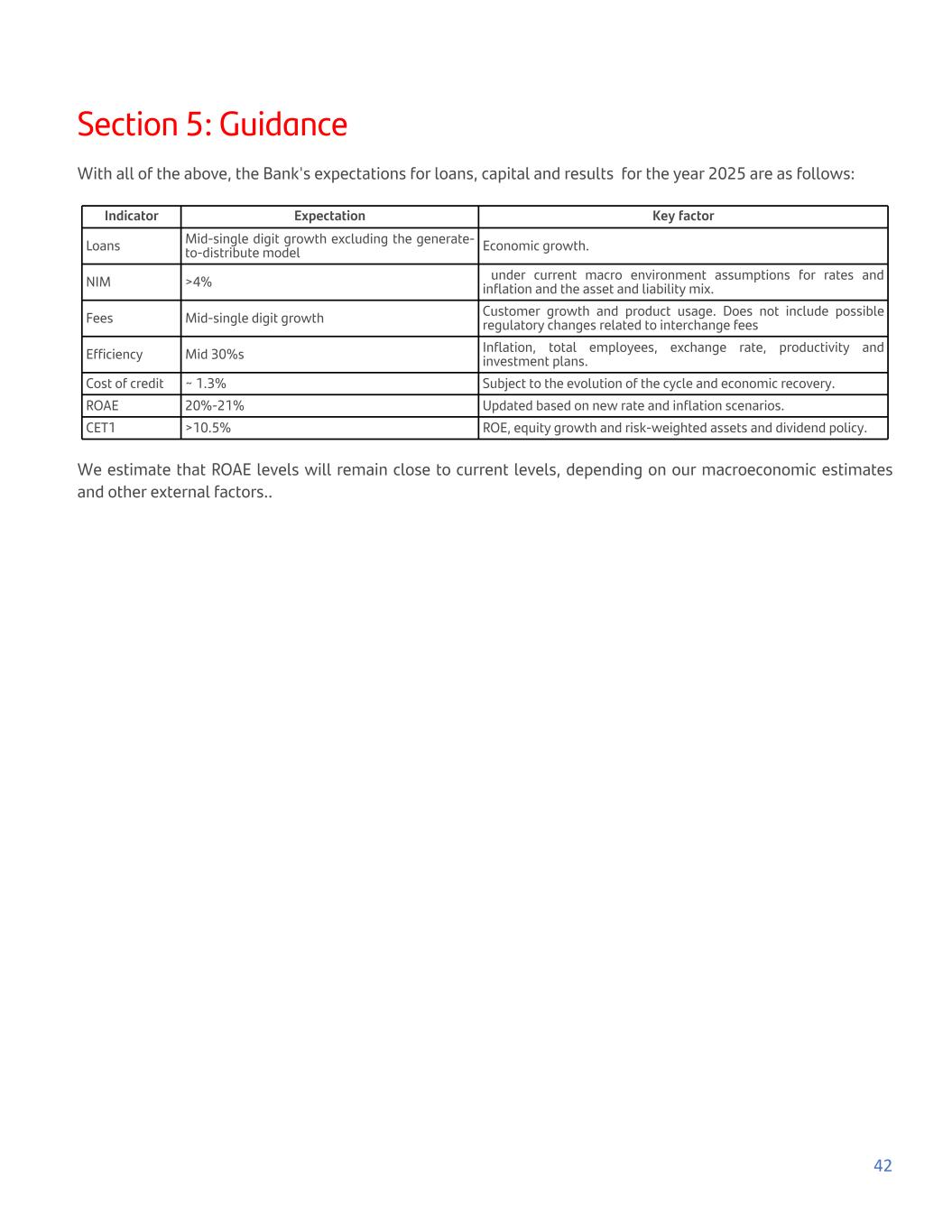
Section 5: Guidance With all of the above, the Bank's expectations for loans, capital and results for the year 2025 are as follows: Indicator Expectation Key factor Loans Mid-single digit growth excluding the generate- to-distribute model Economic growth. NIM >4% under current macro environment assumptions for rates and inflation and the asset and liability mix. Fees Mid-single digit growth Customer growth and product usage. Does not include possible regulatory changes related to interchange fees Efficiency Mid 30%s Inflation, total employees, exchange rate, productivity and investment plans. Cost of credit ~ 1.3% Subject to the evolution of the cycle and economic recovery. ROAE 20%-21% Updated based on new rate and inflation scenarios. CET1 >10.5% ROE, equity growth and risk-weighted assets and dividend policy. We estimate that ROAE levels will remain close to current levels, depending on our macroeconomic estimates and other external factors.. 42
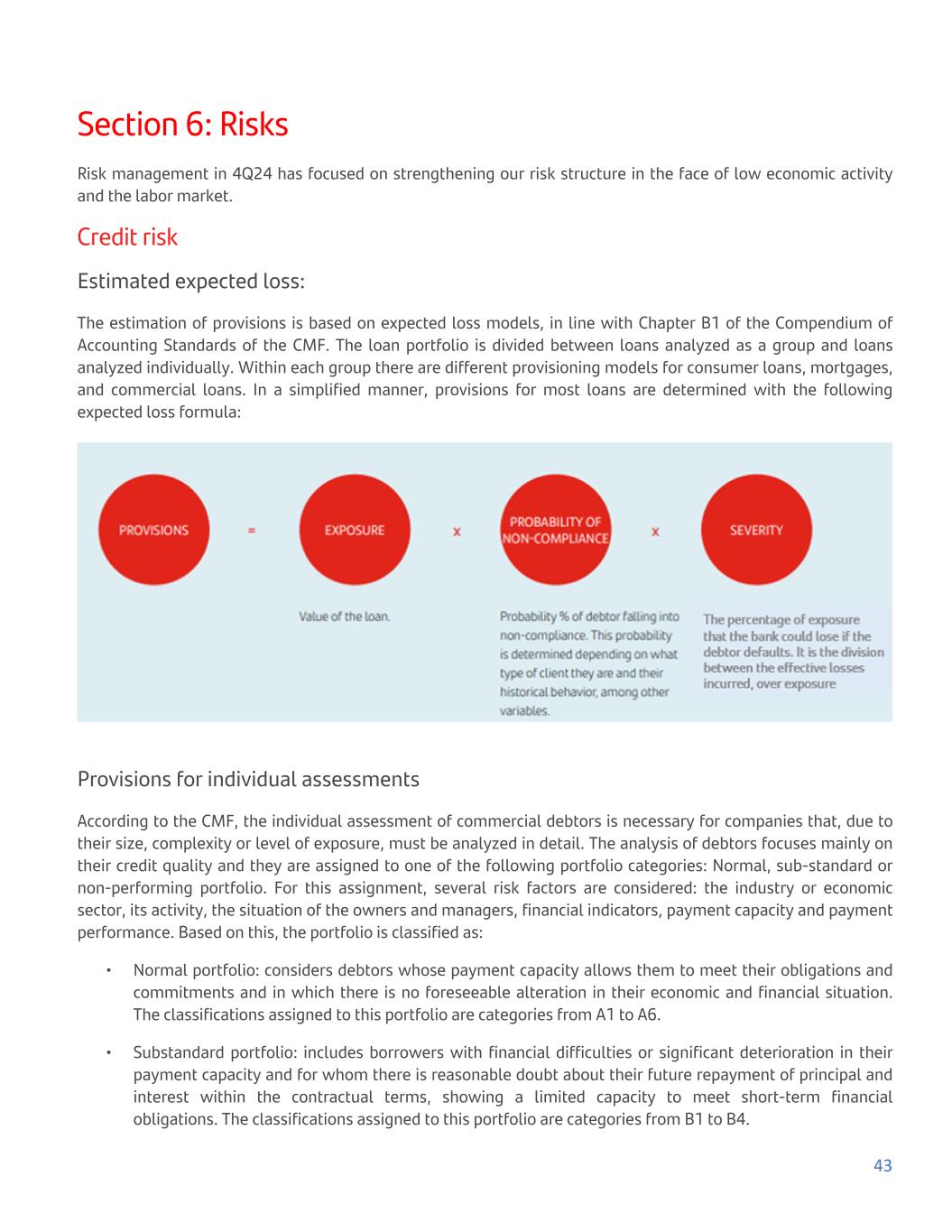
Section 6: Risks Risk management in 4Q24 has focused on strengthening our risk structure in the face of low economic activity and the labor market. Credit risk Estimated expected loss: The estimation of provisions is based on expected loss models, in line with Chapter B1 of the Compendium of Accounting Standards of the CMF. The loan portfolio is divided between loans analyzed as a group and loans analyzed individually. Within each group there are different provisioning models for consumer loans, mortgages, and commercial loans. In a simplified manner, provisions for most loans are determined with the following expected loss formula: Provisions for individual assessments According to the CMF, the individual assessment of commercial debtors is necessary for companies that, due to their size, complexity or level of exposure, must be analyzed in detail. The analysis of debtors focuses mainly on their credit quality and they are assigned to one of the following portfolio categories: Normal, sub-standard or non-performing portfolio. For this assignment, several risk factors are considered: the industry or economic sector, its activity, the situation of the owners and managers, financial indicators, payment capacity and payment performance. Based on this, the portfolio is classified as: • Normal portfolio: considers debtors whose payment capacity allows them to meet their obligations and commitments and in which there is no foreseeable alteration in their economic and financial situation. The classifications assigned to this portfolio are categories from A1 to A6. • Substandard portfolio: includes borrowers with financial difficulties or significant deterioration in their payment capacity and for whom there is reasonable doubt about their future repayment of principal and interest within the contractual terms, showing a limited capacity to meet short-term financial obligations. The classifications assigned to this portfolio are categories from B1 to B4. 43
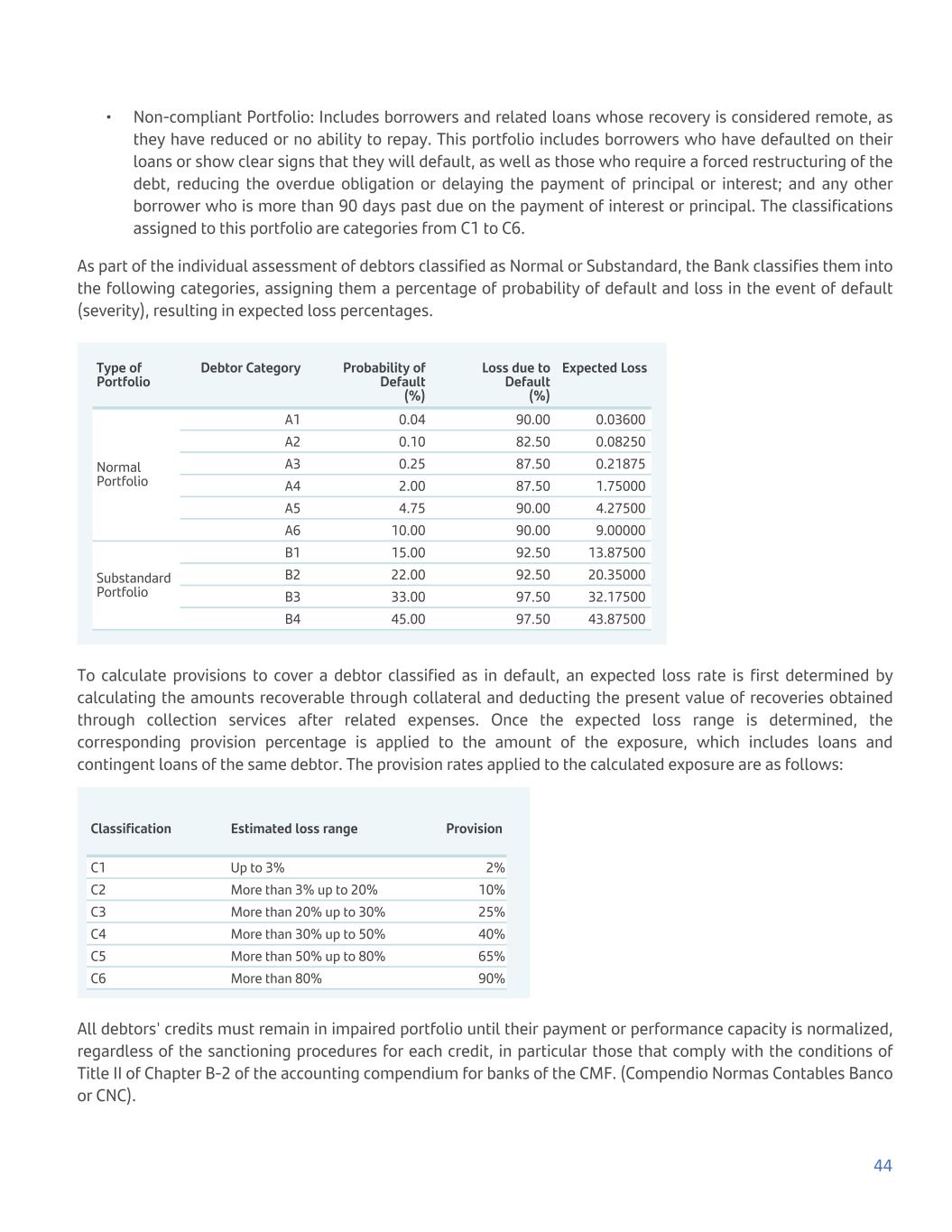
• Non-compliant Portfolio: Includes borrowers and related loans whose recovery is considered remote, as they have reduced or no ability to repay. This portfolio includes borrowers who have defaulted on their loans or show clear signs that they will default, as well as those who require a forced restructuring of the debt, reducing the overdue obligation or delaying the payment of principal or interest; and any other borrower who is more than 90 days past due on the payment of interest or principal. The classifications assigned to this portfolio are categories from C1 to C6. As part of the individual assessment of debtors classified as Normal or Substandard, the Bank classifies them into the following categories, assigning them a percentage of probability of default and loss in the event of default (severity), resulting in expected loss percentages. Type of Portfolio Debtor Category Probability of Default (%) Loss due to Default (%) Expected Loss Normal Portfolio A1 0.04 90.00 0.03600 A2 0.10 82.50 0.08250 A3 0.25 87.50 0.21875 A4 2.00 87.50 1.75000 A5 4.75 90.00 4.27500 A6 10.00 90.00 9.00000 Substandard Portfolio B1 15.00 92.50 13.87500 B2 22.00 92.50 20.35000 B3 33.00 97.50 32.17500 B4 45.00 97.50 43.87500 To calculate provisions to cover a debtor classified as in default, an expected loss rate is first determined by calculating the amounts recoverable through collateral and deducting the present value of recoveries obtained through collection services after related expenses. Once the expected loss range is determined, the corresponding provision percentage is applied to the amount of the exposure, which includes loans and contingent loans of the same debtor. The provision rates applied to the calculated exposure are as follows: Classification Estimated loss range Provision C1 Up to 3% 2% C2 More than 3% up to 20% 10% C3 More than 20% up to 30% 25% C4 More than 30% up to 50% 40% C5 More than 50% up to 80% 65% C6 More than 80% 90% All debtors' credits must remain in impaired portfolio until their payment or performance capacity is normalized, regardless of the sanctioning procedures for each credit, in particular those that comply with the conditions of Title II of Chapter B-2 of the accounting compendium for banks of the CMF. (Compendio Normas Contables Banco or CNC). 44
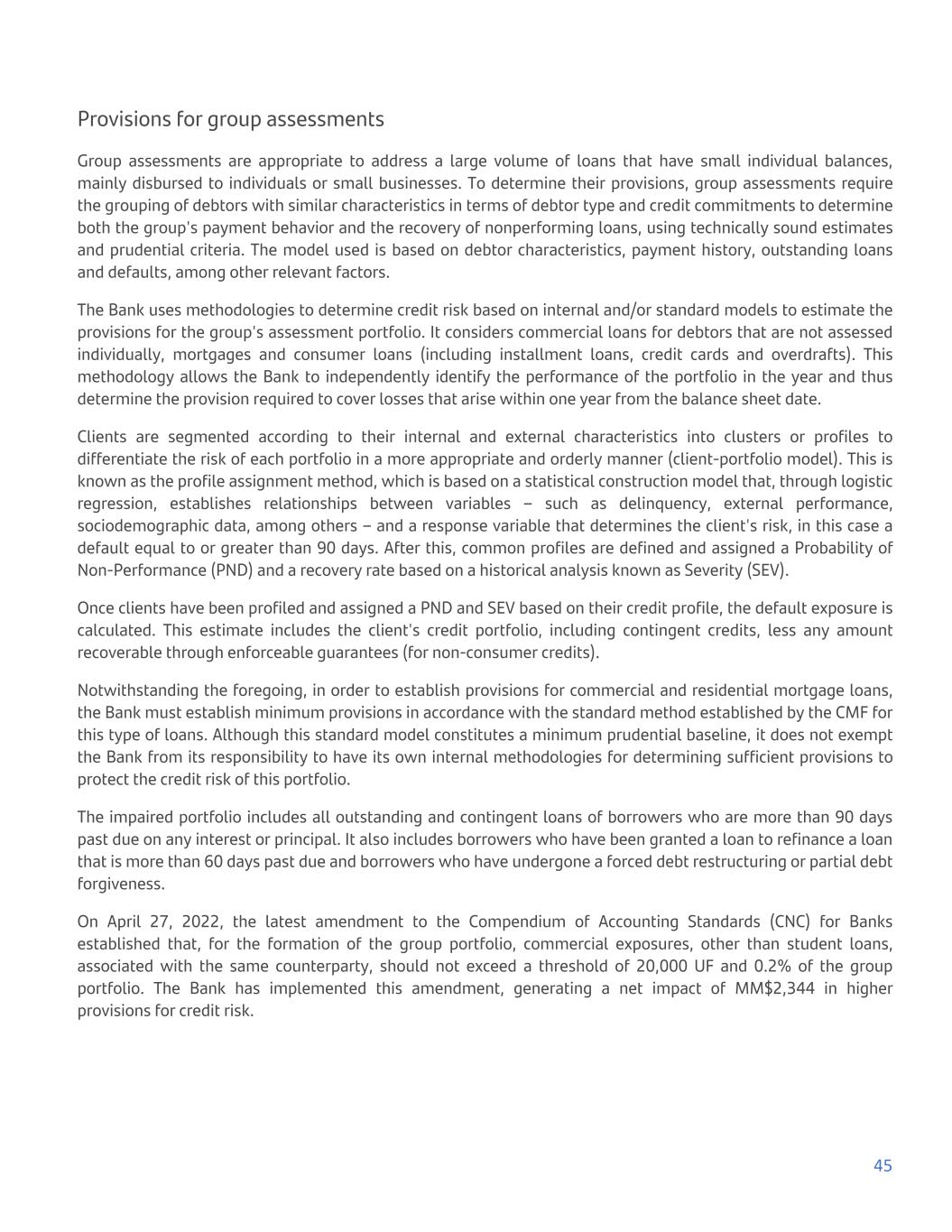
Provisions for group assessments Group assessments are appropriate to address a large volume of loans that have small individual balances, mainly disbursed to individuals or small businesses. To determine their provisions, group assessments require the grouping of debtors with similar characteristics in terms of debtor type and credit commitments to determine both the group's payment behavior and the recovery of nonperforming loans, using technically sound estimates and prudential criteria. The model used is based on debtor characteristics, payment history, outstanding loans and defaults, among other relevant factors. The Bank uses methodologies to determine credit risk based on internal and/or standard models to estimate the provisions for the group's assessment portfolio. It considers commercial loans for debtors that are not assessed individually, mortgages and consumer loans (including installment loans, credit cards and overdrafts). This methodology allows the Bank to independently identify the performance of the portfolio in the year and thus determine the provision required to cover losses that arise within one year from the balance sheet date. Clients are segmented according to their internal and external characteristics into clusters or profiles to differentiate the risk of each portfolio in a more appropriate and orderly manner (client-portfolio model). This is known as the profile assignment method, which is based on a statistical construction model that, through logistic regression, establishes relationships between variables – such as delinquency, external performance, sociodemographic data, among others – and a response variable that determines the client's risk, in this case a default equal to or greater than 90 days. After this, common profiles are defined and assigned a Probability of Non-Performance (PND) and a recovery rate based on a historical analysis known as Severity (SEV). Once clients have been profiled and assigned a PND and SEV based on their credit profile, the default exposure is calculated. This estimate includes the client's credit portfolio, including contingent credits, less any amount recoverable through enforceable guarantees (for non-consumer credits). Notwithstanding the foregoing, in order to establish provisions for commercial and residential mortgage loans, the Bank must establish minimum provisions in accordance with the standard method established by the CMF for this type of loans. Although this standard model constitutes a minimum prudential baseline, it does not exempt the Bank from its responsibility to have its own internal methodologies for determining sufficient provisions to protect the credit risk of this portfolio. The impaired portfolio includes all outstanding and contingent loans of borrowers who are more than 90 days past due on any interest or principal. It also includes borrowers who have been granted a loan to refinance a loan that is more than 60 days past due and borrowers who have undergone a forced debt restructuring or partial debt forgiveness. On April 27, 2022, the latest amendment to the Compendium of Accounting Standards (CNC) for Banks established that, for the formation of the group portfolio, commercial exposures, other than student loans, associated with the same counterparty, should not exceed a threshold of 20,000 UF and 0.2% of the group portfolio. The Bank has implemented this amendment, generating a net impact of MM$2,344 in higher provisions for credit risk. 45
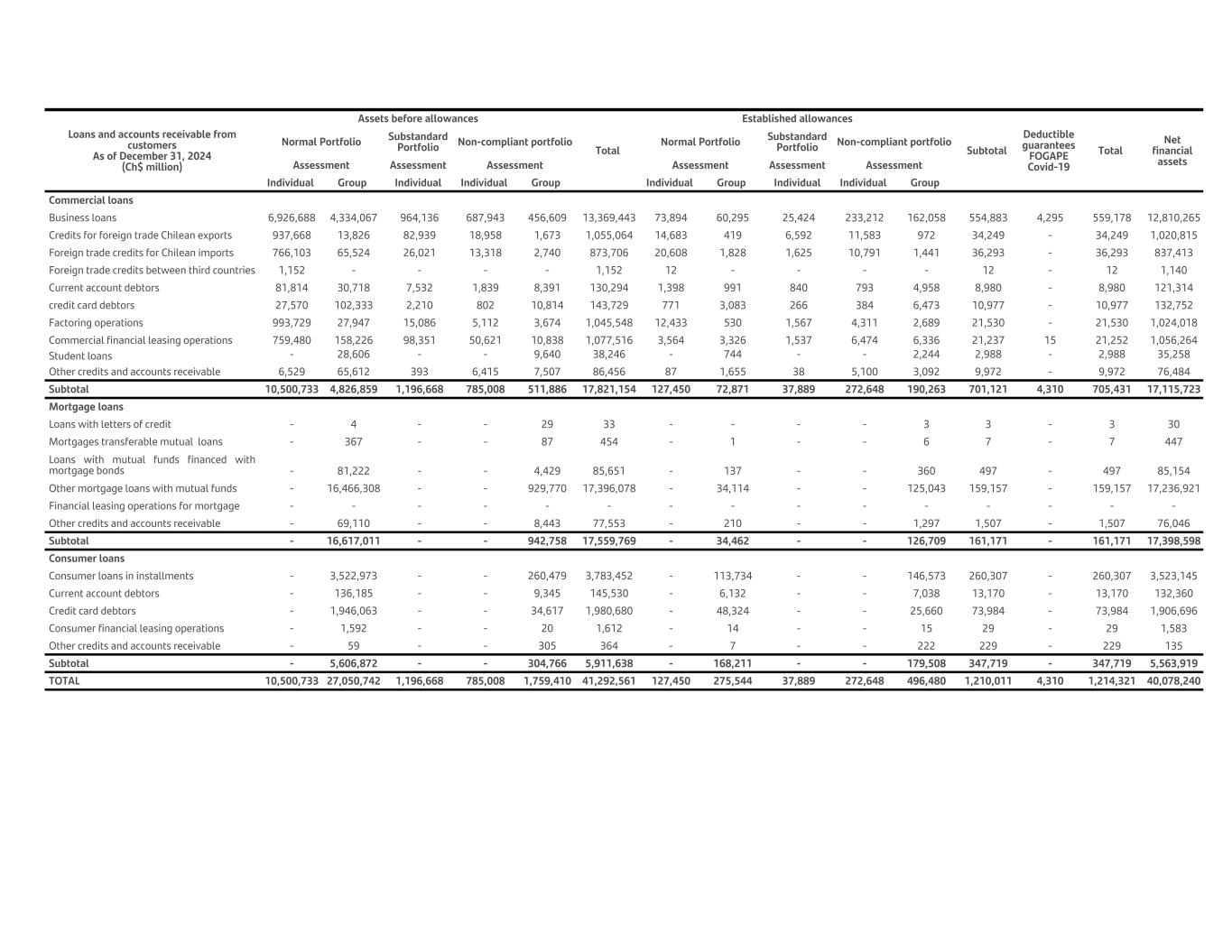
Loans and accounts receivable from customers As of December 31, 2024 (Ch$ million) Assets before allowances Total Established allowances Subtotal Deductible guarantees FOGAPE Covid-19 Total Net financial assets Normal Portfolio Substandard Portfolio Non-compliant portfolio Normal Portfolio Substandard Portfolio Non-compliant portfolio Assessment Assessment Assessment Assessment Assessment Assessment Individual Group Individual Individual Group Individual Group Individual Individual Group Commercial loans Business loans 6,926,688 4,334,067 964,136 687,943 456,609 13,369,443 73,894 60,295 25,424 233,212 162,058 554,883 4,295 559,178 12,810,265 Credits for foreign trade Chilean exports 937,668 13,826 82,939 18,958 1,673 1,055,064 14,683 419 6,592 11,583 972 34,249 - 34,249 1,020,815 Foreign trade credits for Chilean imports 766,103 65,524 26,021 13,318 2,740 873,706 20,608 1,828 1,625 10,791 1,441 36,293 - 36,293 837,413 Foreign trade credits between third countries 1,152 - - - - 1,152 12 - - - - 12 - 12 1,140 Current account debtors 81,814 30,718 7,532 1,839 8,391 130,294 1,398 991 840 793 4,958 8,980 - 8,980 121,314 credit card debtors 27,570 102,333 2,210 802 10,814 143,729 771 3,083 266 384 6,473 10,977 - 10,977 132,752 Factoring operations 993,729 27,947 15,086 5,112 3,674 1,045,548 12,433 530 1,567 4,311 2,689 21,530 - 21,530 1,024,018 Commercial financial leasing operations 759,480 158,226 98,351 50,621 10,838 1,077,516 3,564 3,326 1,537 6,474 6,336 21,237 15 21,252 1,056,264 Student loans - 28,606 - - 9,640 38,246 - 744 - - 2,244 2,988 - 2,988 35,258 Other credits and accounts receivable 6,529 65,612 393 6,415 7,507 86,456 87 1,655 38 5,100 3,092 9,972 - 9,972 76,484 Subtotal 10,500,733 4,826,859 1,196,668 785,008 511,886 17,821,154 127,450 72,871 37,889 272,648 190,263 701,121 4,310 705,431 17,115,723 Mortgage loans Loans with letters of credit - 4 - - 29 33 - - - - 3 3 - 3 30 Mortgages transferable mutual loans - 367 - - 87 454 - 1 - - 6 7 - 7 447 Loans with mutual funds financed with mortgage bonds - 81,222 - - 4,429 85,651 - 137 - - 360 497 - 497 85,154 Other mortgage loans with mutual funds - 16,466,308 - - 929,770 17,396,078 - 34,114 - - 125,043 159,157 - 159,157 17,236,921 Financial leasing operations for mortgage - - - - - - - - - - - - - - - Other credits and accounts receivable - 69,110 - - 8,443 77,553 - 210 - - 1,297 1,507 - 1,507 76,046 Subtotal - 16,617,011 - - 942,758 17,559,769 - 34,462 - - 126,709 161,171 - 161,171 17,398,598 Consumer loans Consumer loans in installments - 3,522,973 - - 260,479 3,783,452 - 113,734 - - 146,573 260,307 - 260,307 3,523,145 Current account debtors - 136,185 - - 9,345 145,530 - 6,132 - - 7,038 13,170 - 13,170 132,360 Credit card debtors - 1,946,063 - - 34,617 1,980,680 - 48,324 - - 25,660 73,984 - 73,984 1,906,696 Consumer financial leasing operations - 1,592 - - 20 1,612 - 14 - - 15 29 - 29 1,583 Other credits and accounts receivable - 59 - - 305 364 - 7 - - 222 229 - 229 135 Subtotal - 5,606,872 - - 304,766 5,911,638 - 168,211 - - 179,508 347,719 - 347,719 5,563,919 TOTAL 10,500,733 27,050,742 1,196,668 785,008 1,759,410 41,292,561 127,450 275,544 37,889 272,648 496,480 1,210,011 4,310 1,214,321 40,078,240
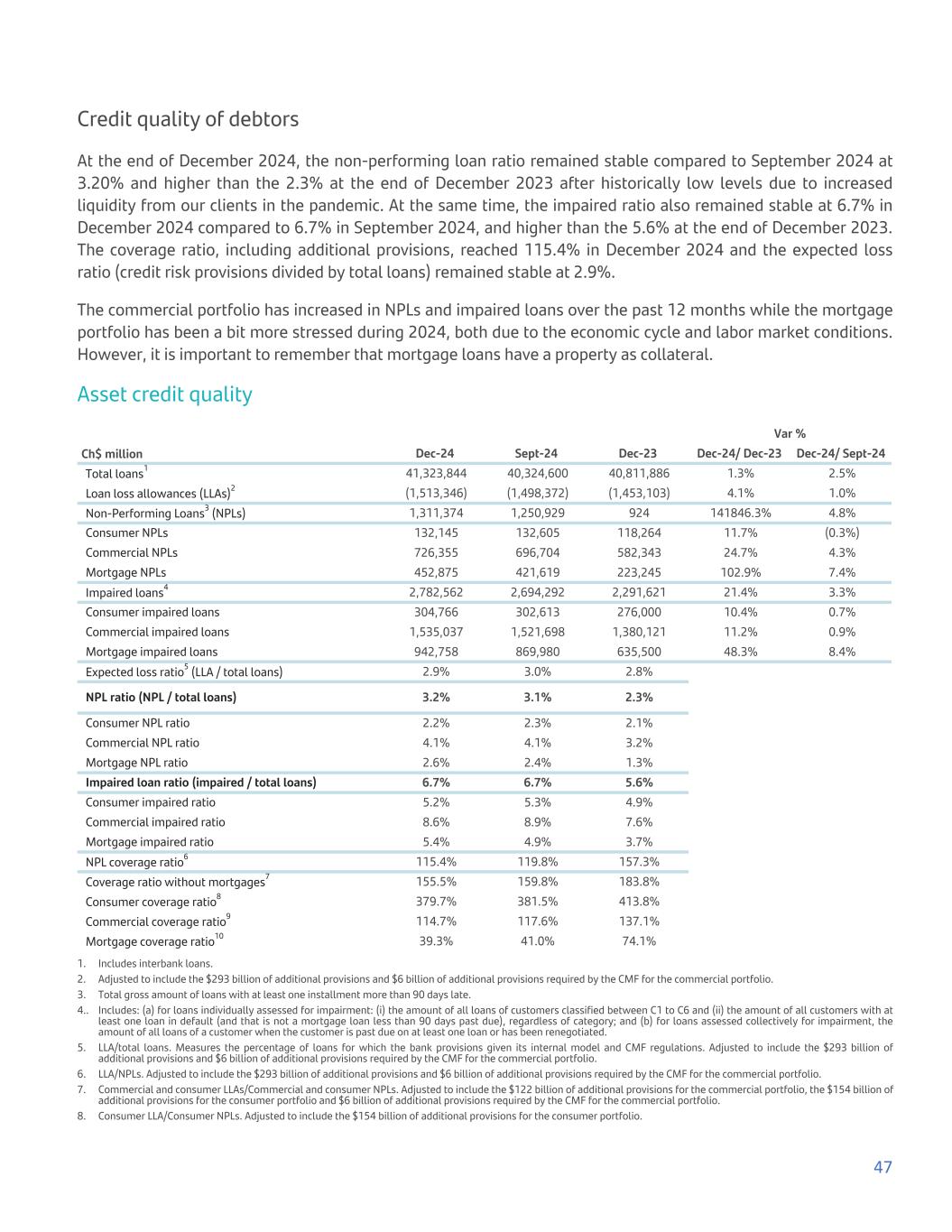
Credit quality of debtors At the end of December 2024, the non-performing loan ratio remained stable compared to September 2024 at 3.20% and higher than the 2.3% at the end of December 2023 after historically low levels due to increased liquidity from our clients in the pandemic. At the same time, the impaired ratio also remained stable at 6.7% in December 2024 compared to 6.7% in September 2024, and higher than the 5.6% at the end of December 2023. The coverage ratio, including additional provisions, reached 115.4% in December 2024 and the expected loss ratio (credit risk provisions divided by total loans) remained stable at 2.9%. The commercial portfolio has increased in NPLs and impaired loans over the past 12 months while the mortgage portfolio has been a bit more stressed during 2024, both due to the economic cycle and labor market conditions. However, it is important to remember that mortgage loans have a property as collateral. Asset credit quality Var % Ch$ million Dec-24 Sept-24 Dec-23 Dec-24/ Dec-23 Dec-24/ Sept-24 Total loans1 41,323,844 40,324,600 40,811,886 1.3% 2.5% Loan loss allowances (LLAs)2 (1,513,346) (1,498,372) (1,453,103) 4.1% 1.0% Non-Performing Loans3 (NPLs) 1,311,374 1,250,929 924 141846.3% 4.8% Consumer NPLs 132,145 132,605 118,264 11.7% (0.3%) Commercial NPLs 726,355 696,704 582,343 24.7% 4.3% Mortgage NPLs 452,875 421,619 223,245 102.9% 7.4% Impaired loans4 2,782,562 2,694,292 2,291,621 21.4% 3.3% Consumer impaired loans 304,766 302,613 276,000 10.4% 0.7% Commercial impaired loans 1,535,037 1,521,698 1,380,121 11.2% 0.9% Mortgage impaired loans 942,758 869,980 635,500 48.3% 8.4% Expected loss ratio5 (LLA / total loans) 2.9% 3.0% 2.8% NPL ratio (NPL / total loans) 3.2% 3.1% 2.3% Consumer NPL ratio 2.2% 2.3% 2.1% Commercial NPL ratio 4.1% 4.1% 3.2% Mortgage NPL ratio 2.6% 2.4% 1.3% Impaired loan ratio (impaired / total loans) 6.7% 6.7% 5.6% Consumer impaired ratio 5.2% 5.3% 4.9% Commercial impaired ratio 8.6% 8.9% 7.6% Mortgage impaired ratio 5.4% 4.9% 3.7% NPL coverage ratio6 115.4% 119.8% 157.3% Coverage ratio without mortgages7 155.5% 159.8% 183.8% Consumer coverage ratio8 379.7% 381.5% 413.8% Commercial coverage ratio9 114.7% 117.6% 137.1% Mortgage coverage ratio10 39.3% 41.0% 74.1% 1. Includes interbank loans. 2. Adjusted to include the $293 billion of additional provisions and $6 billion of additional provisions required by the CMF for the commercial portfolio. 3. Total gross amount of loans with at least one installment more than 90 days late. 4.. Includes: (a) for loans individually assessed for impairment: (i) the amount of all loans of customers classified between C1 to C6 and (ii) the amount of all customers with at least one loan in default (and that is not a mortgage loan less than 90 days past due), regardless of category; and (b) for loans assessed collectively for impairment, the amount of all loans of a customer when the customer is past due on at least one loan or has been renegotiated. 5. LLA/total loans. Measures the percentage of loans for which the bank provisions given its internal model and CMF regulations. Adjusted to include the $293 billion of additional provisions and $6 billion of additional provisions required by the CMF for the commercial portfolio. 6. LLA/NPLs. Adjusted to include the $293 billion of additional provisions and $6 billion of additional provisions required by the CMF for the commercial portfolio. 7. Commercial and consumer LLAs/Commercial and consumer NPLs. Adjusted to include the $122 billion of additional provisions for the commercial portfolio, the $154 billion of additional provisions for the consumer portfolio and $6 billion of additional provisions required by the CMF for the commercial portfolio. 8. Consumer LLA/Consumer NPLs. Adjusted to include the $154 billion of additional provisions for the consumer portfolio. 47
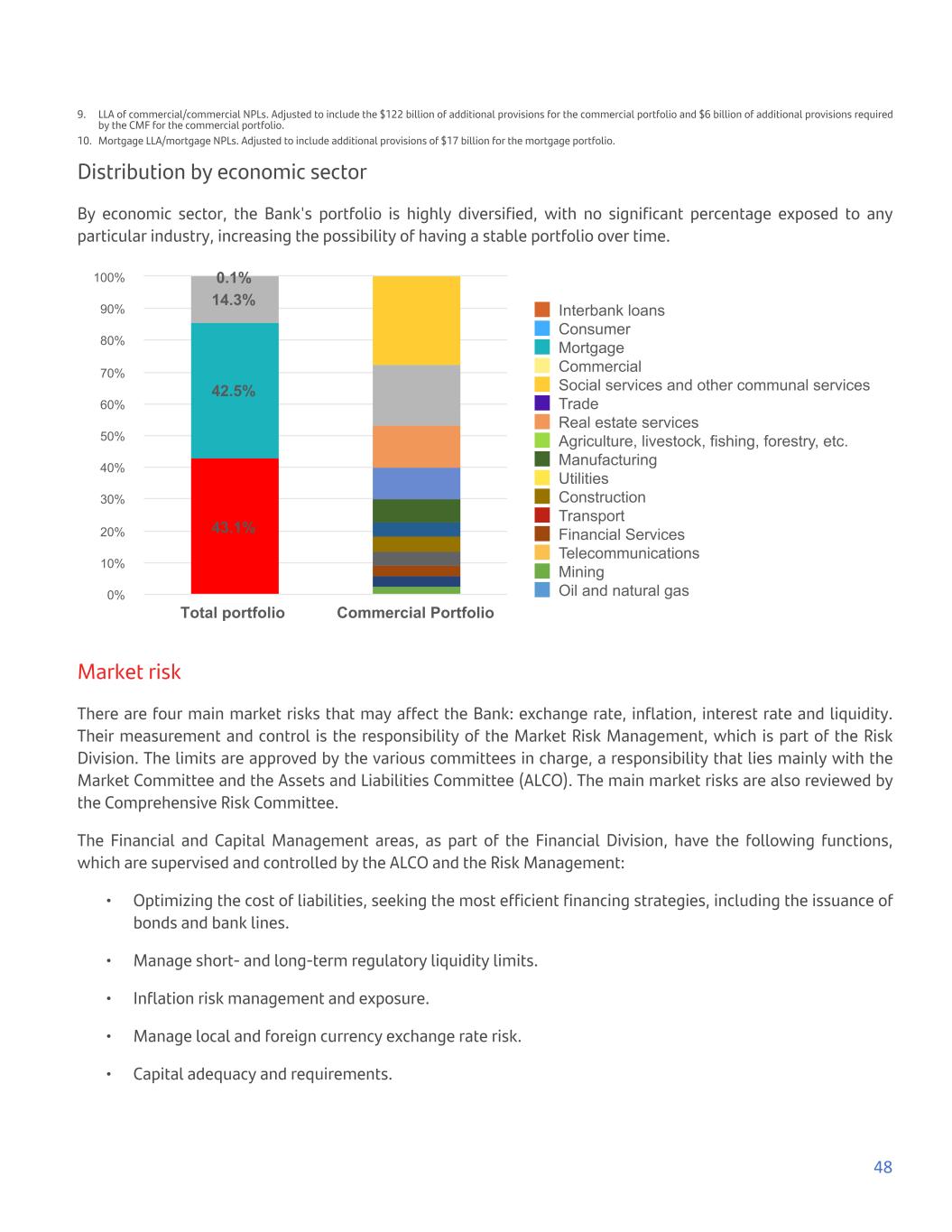
9. LLA of commercial/commercial NPLs. Adjusted to include the $122 billion of additional provisions for the commercial portfolio and $6 billion of additional provisions required by the CMF for the commercial portfolio. 10. Mortgage LLA/mortgage NPLs. Adjusted to include additional provisions of $17 billion for the mortgage portfolio. Distribution by economic sector By economic sector, the Bank's portfolio is highly diversified, with no significant percentage exposed to any particular industry, increasing the possibility of having a stable portfolio over time. 43.1% 42.5% 14.3% 0.1% Interbank loans Consumer Mortgage Commercial Social services and other communal services Trade Real estate services Agriculture, livestock, fishing, forestry, etc. Manufacturing Utilities Construction Transport Financial Services Telecommunications Mining Oil and natural gas Total portfolio Commercial Portfolio 0% 10% 20% 30% 40% 50% 60% 70% 80% 90% 100% Market risk There are four main market risks that may affect the Bank: exchange rate, inflation, interest rate and liquidity. Their measurement and control is the responsibility of the Market Risk Management, which is part of the Risk Division. The limits are approved by the various committees in charge, a responsibility that lies mainly with the Market Committee and the Assets and Liabilities Committee (ALCO). The main market risks are also reviewed by the Comprehensive Risk Committee. The Financial and Capital Management areas, as part of the Financial Division, have the following functions, which are supervised and controlled by the ALCO and the Risk Management: • Optimizing the cost of liabilities, seeking the most efficient financing strategies, including the issuance of bonds and bank lines. • Manage short- and long-term regulatory liquidity limits. • Inflation risk management and exposure. • Manage local and foreign currency exchange rate risk. • Capital adequacy and requirements. 48
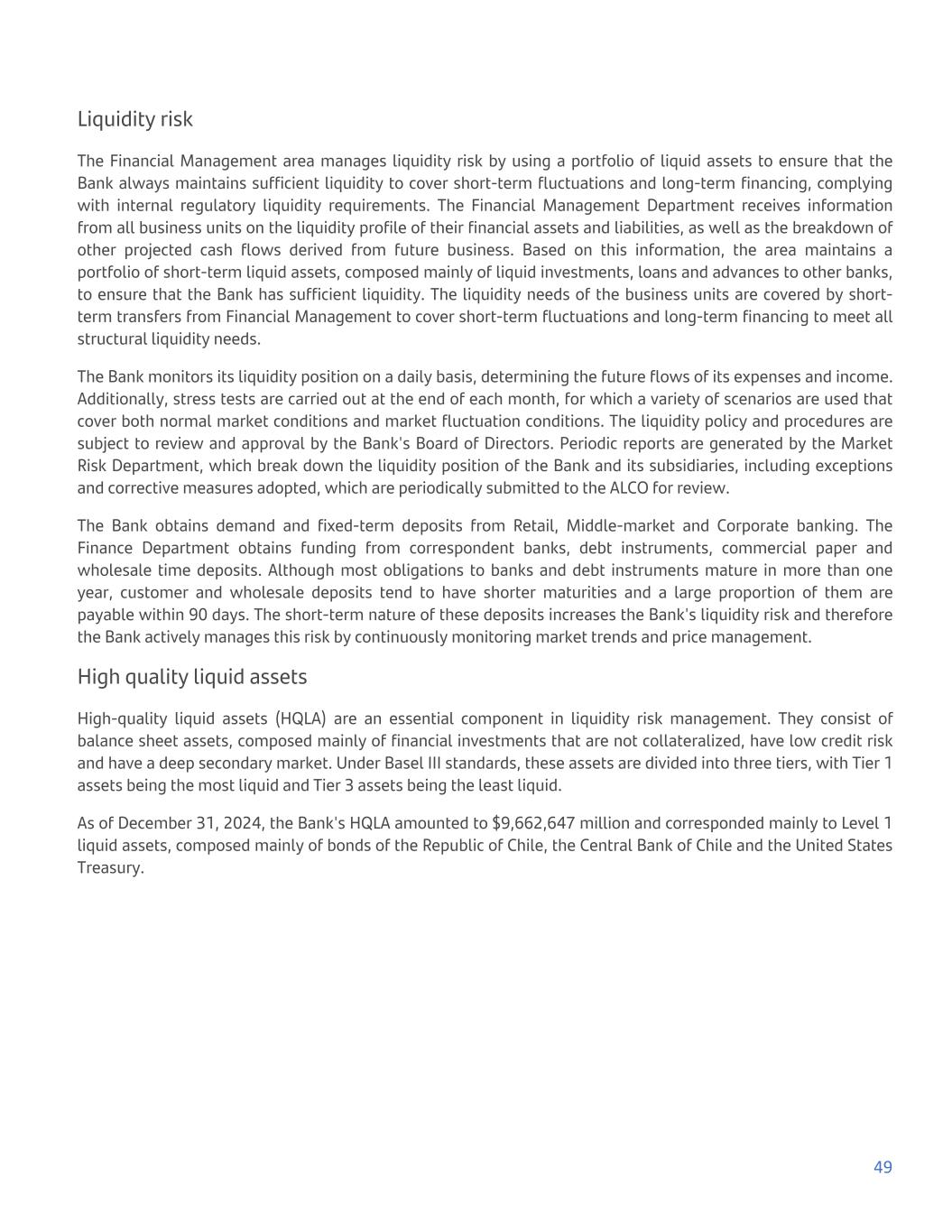
Liquidity risk The Financial Management area manages liquidity risk by using a portfolio of liquid assets to ensure that the Bank always maintains sufficient liquidity to cover short-term fluctuations and long-term financing, complying with internal regulatory liquidity requirements. The Financial Management Department receives information from all business units on the liquidity profile of their financial assets and liabilities, as well as the breakdown of other projected cash flows derived from future business. Based on this information, the area maintains a portfolio of short-term liquid assets, composed mainly of liquid investments, loans and advances to other banks, to ensure that the Bank has sufficient liquidity. The liquidity needs of the business units are covered by short- term transfers from Financial Management to cover short-term fluctuations and long-term financing to meet all structural liquidity needs. The Bank monitors its liquidity position on a daily basis, determining the future flows of its expenses and income. Additionally, stress tests are carried out at the end of each month, for which a variety of scenarios are used that cover both normal market conditions and market fluctuation conditions. The liquidity policy and procedures are subject to review and approval by the Bank's Board of Directors. Periodic reports are generated by the Market Risk Department, which break down the liquidity position of the Bank and its subsidiaries, including exceptions and corrective measures adopted, which are periodically submitted to the ALCO for review. The Bank obtains demand and fixed-term deposits from Retail, Middle-market and Corporate banking. The Finance Department obtains funding from correspondent banks, debt instruments, commercial paper and wholesale time deposits. Although most obligations to banks and debt instruments mature in more than one year, customer and wholesale deposits tend to have shorter maturities and a large proportion of them are payable within 90 days. The short-term nature of these deposits increases the Bank's liquidity risk and therefore the Bank actively manages this risk by continuously monitoring market trends and price management. High quality liquid assets High-quality liquid assets (HQLA) are an essential component in liquidity risk management. They consist of balance sheet assets, composed mainly of financial investments that are not collateralized, have low credit risk and have a deep secondary market. Under Basel III standards, these assets are divided into three tiers, with Tier 1 assets being the most liquid and Tier 3 assets being the least liquid. As of December 31, 2024, the Bank's HQLA amounted to $9,662,647 million and corresponded mainly to Level 1 liquid assets, composed mainly of bonds of the Republic of Chile, the Central Bank of Chile and the United States Treasury. 49
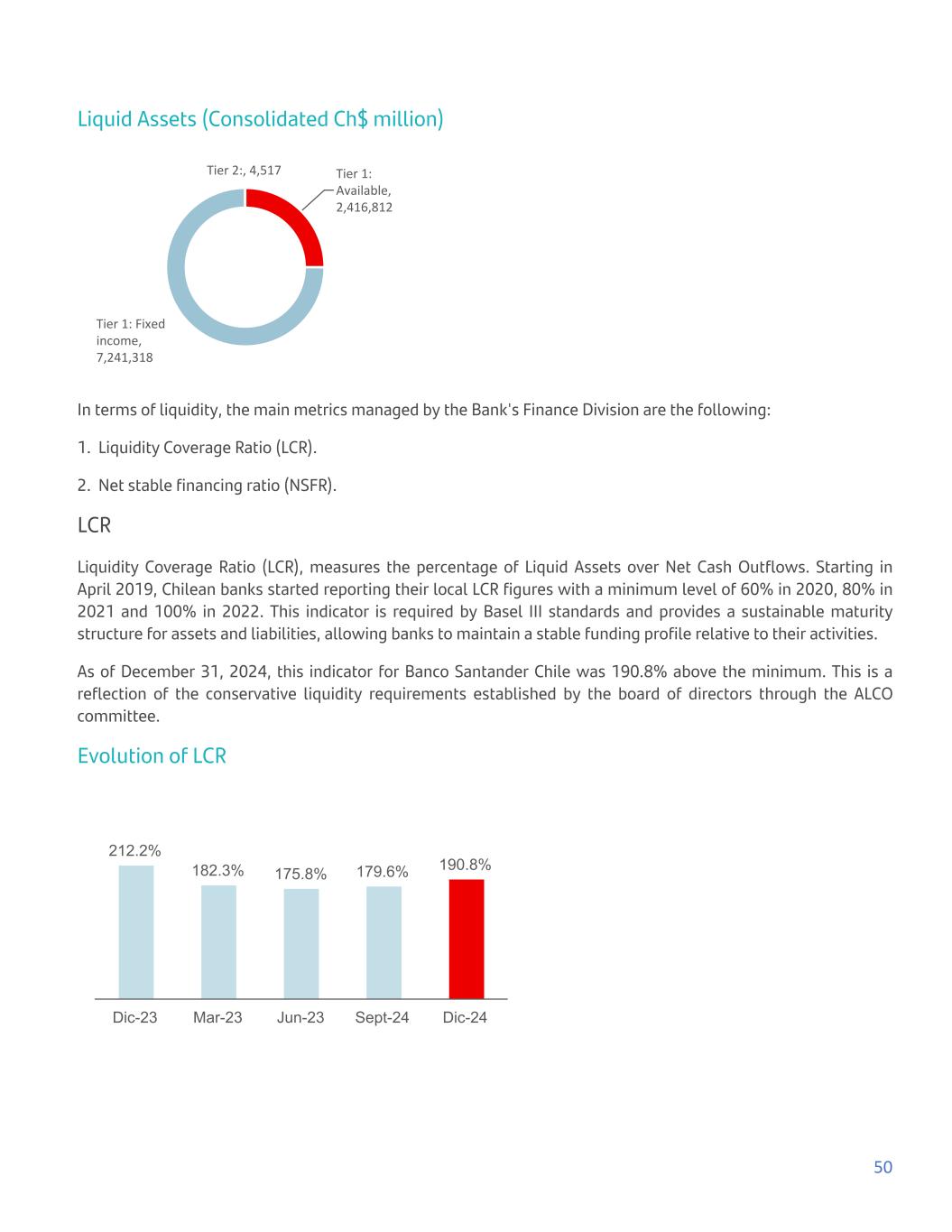
Liquid Assets (Consolidated Ch$ million) Tier 1: Available, 2,416,812 Tier 1: Fixed income, 7,241,318 Tier 2:, 4,517 In terms of liquidity, the main metrics managed by the Bank's Finance Division are the following: 1. Liquidity Coverage Ratio (LCR). 2. Net stable financing ratio (NSFR). LCR Liquidity Coverage Ratio (LCR), measures the percentage of Liquid Assets over Net Cash Outflows. Starting in April 2019, Chilean banks started reporting their local LCR figures with a minimum level of 60% in 2020, 80% in 2021 and 100% in 2022. This indicator is required by Basel III standards and provides a sustainable maturity structure for assets and liabilities, allowing banks to maintain a stable funding profile relative to their activities. As of December 31, 2024, this indicator for Banco Santander Chile was 190.8% above the minimum. This is a reflection of the conservative liquidity requirements established by the board of directors through the ALCO committee. Evolution of LCR 212.2% 182.3% 175.8% 179.6% 190.8% Dic-23 Mar-23 Jun-23 Sept-24 Dic-24 50
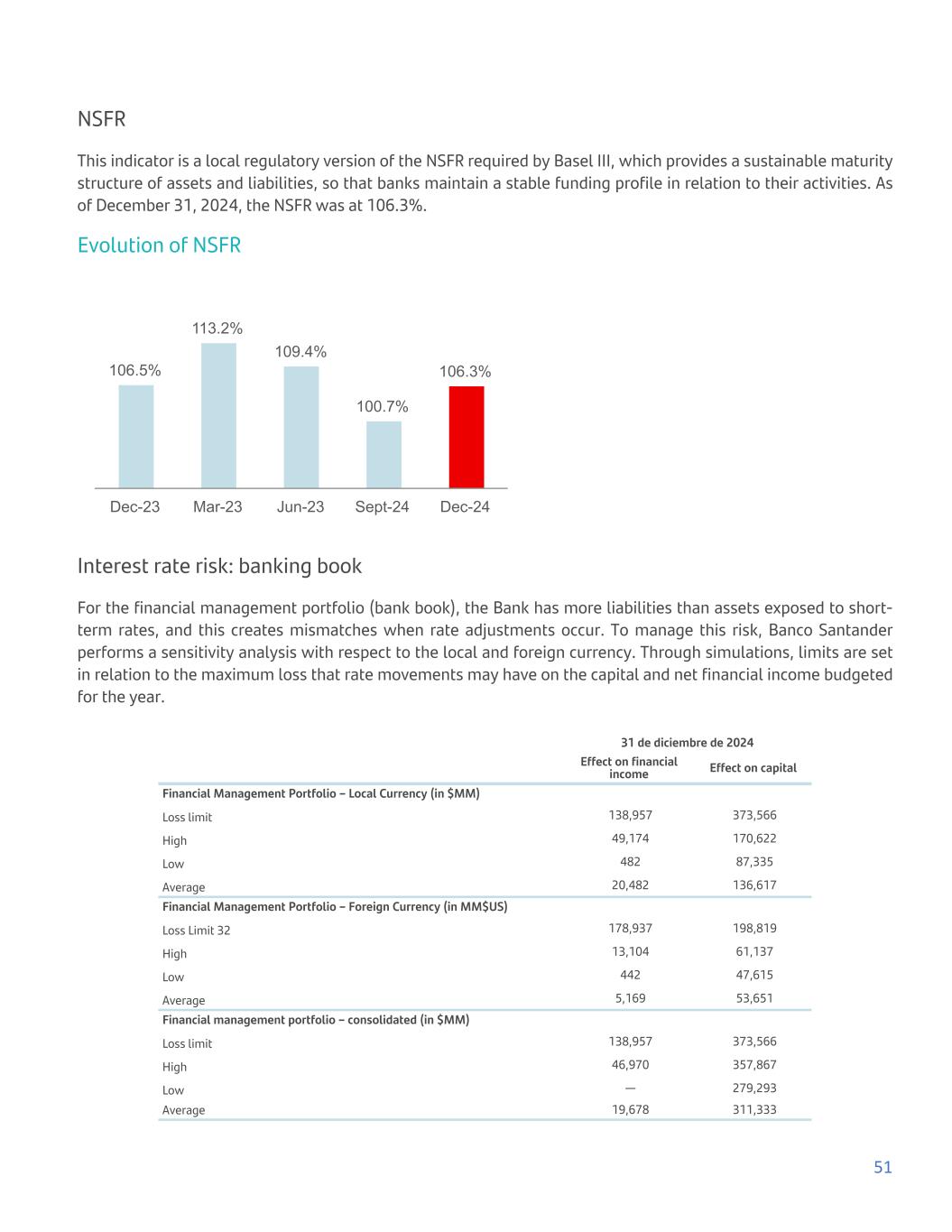
NSFR This indicator is a local regulatory version of the NSFR required by Basel III, which provides a sustainable maturity structure of assets and liabilities, so that banks maintain a stable funding profile in relation to their activities. As of December 31, 2024, the NSFR was at 106.3%. Evolution of NSFR 106.5% 113.2% 109.4% 100.7% 106.3% Dec-23 Mar-23 Jun-23 Sept-24 Dec-24 Interest rate risk: banking book For the financial management portfolio (bank book), the Bank has more liabilities than assets exposed to short- term rates, and this creates mismatches when rate adjustments occur. To manage this risk, Banco Santander performs a sensitivity analysis with respect to the local and foreign currency. Through simulations, limits are set in relation to the maximum loss that rate movements may have on the capital and net financial income budgeted for the year. 31 de diciembre de 2024 Effect on financial income Effect on capital Financial Management Portfolio – Local Currency (in $MM) Loss limit 138,957 373,566 High 49,174 170,622 Low 482 87,335 Average 20,482 136,617 Financial Management Portfolio – Foreign Currency (in MM$US) Loss Limit 32 178,937 198,819 High 13,104 61,137 Low 442 47,615 Average 5,169 53,651 Financial management portfolio – consolidated (in $MM) Loss limit 138,957 373,566 High 46,970 357,867 Low — 279,293 Average 19,678 311,333 51
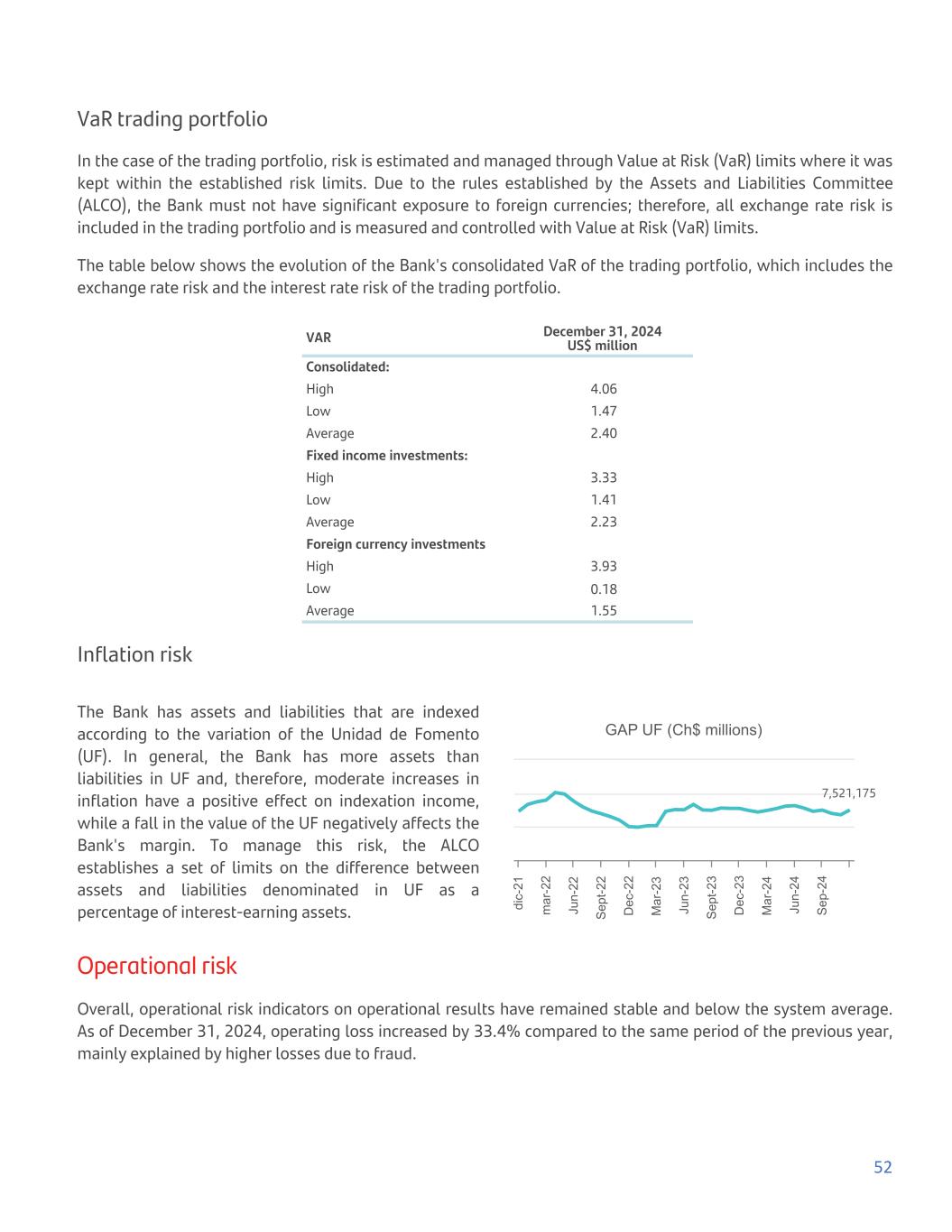
VaR trading portfolio In the case of the trading portfolio, risk is estimated and managed through Value at Risk (VaR) limits where it was kept within the established risk limits. Due to the rules established by the Assets and Liabilities Committee (ALCO), the Bank must not have significant exposure to foreign currencies; therefore, all exchange rate risk is included in the trading portfolio and is measured and controlled with Value at Risk (VaR) limits. The table below shows the evolution of the Bank's consolidated VaR of the trading portfolio, which includes the exchange rate risk and the interest rate risk of the trading portfolio. VAR December 31, 2024 US$ million Consolidated: High 4.06 Low 1.47 Average 2.40 Fixed income investments: High 3.33 Low 1.41 Average 2.23 Foreign currency investments High 3.93 Low 0.18 Average 1.55 Inflation risk The Bank has assets and liabilities that are indexed according to the variation of the Unidad de Fomento (UF). In general, the Bank has more assets than liabilities in UF and, therefore, moderate increases in inflation have a positive effect on indexation income, while a fall in the value of the UF negatively affects the Bank's margin. To manage this risk, the ALCO establishes a set of limits on the difference between assets and liabilities denominated in UF as a percentage of interest-earning assets. GAP UF (Ch$ millions) 7,521,175 di c- 21 m ar -2 2 Ju n- 22 S ep t-2 2 D ec -2 2 M ar -2 3 Ju n- 23 S ep t-2 3 D ec -2 3 M ar -2 4 Ju n- 24 S ep -2 4 Operational risk Overall, operational risk indicators on operational results have remained stable and below the system average. As of December 31, 2024, operating loss increased by 33.4% compared to the same period of the previous year, mainly explained by higher losses due to fraud. 52
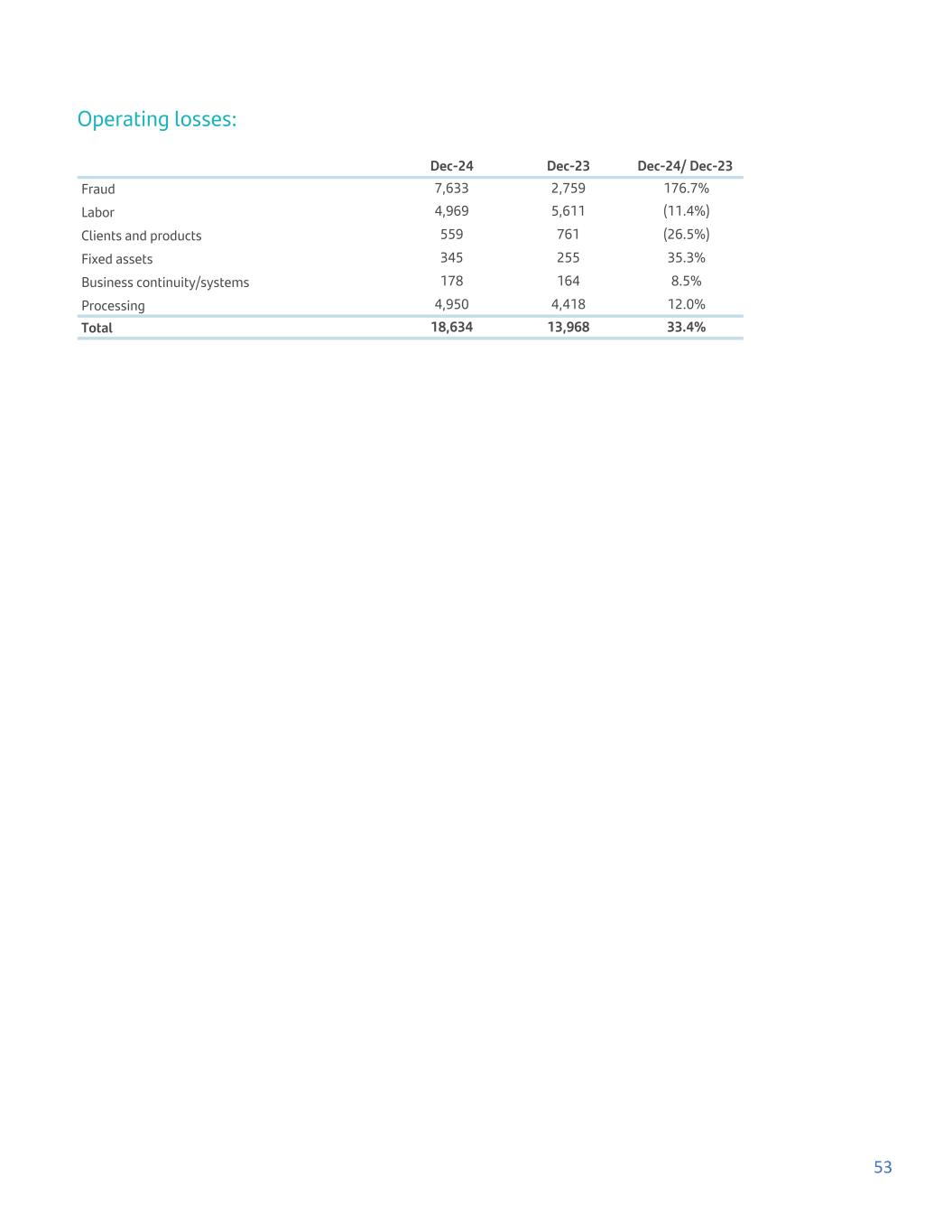
Operating losses: Dec-24 Dec-23 Dec-24/ Dec-23 Fraud 7,633 2,759 176.7% Labor 4,969 5,611 (11.4%) Clients and products 559 761 (26.5%) Fixed assets 345 255 35.3% Business continuity/systems 178 164 8.5% Processing 4,950 4,418 12.0% Total 18,634 13,968 33.4% 53
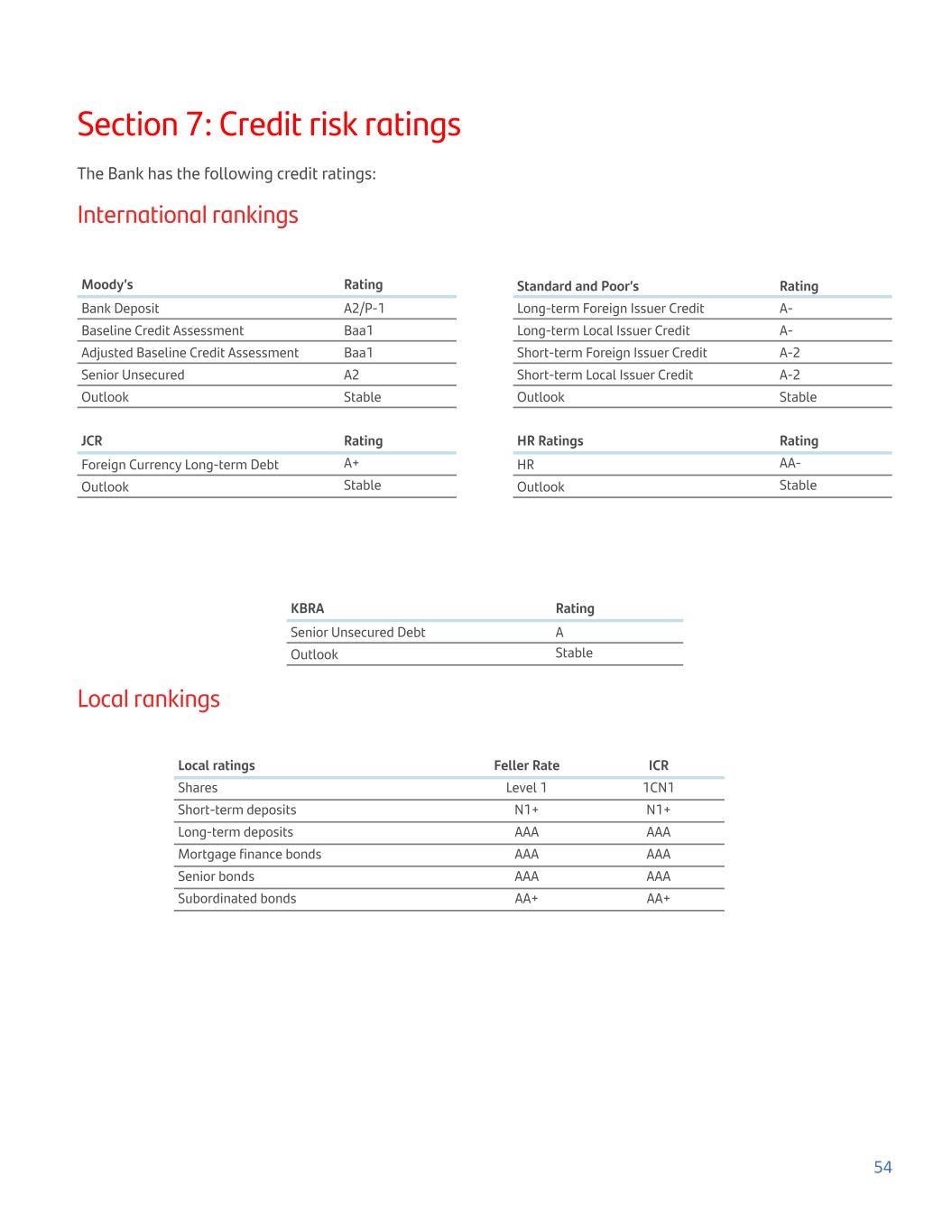
Section 7: Credit risk ratings The Bank has the following credit ratings: International rankings Moody’s Rating Bank Deposit A2/P-1 Baseline Credit Assessment Baa1 Adjusted Baseline Credit Assessment Baa1 Senior Unsecured A2 Outlook Stable Standard and Poor’s Rating Long-term Foreign Issuer Credit A- Long-term Local Issuer Credit A- Short-term Foreign Issuer Credit A-2 Short-term Local Issuer Credit A-2 Outlook Stable JCR Rating Foreign Currency Long-term Debt A+ Outlook Stable HR Ratings Rating HR AA- Outlook Stable KBRA Rating Senior Unsecured Debt A Outlook Stable Local rankings Local ratings Feller Rate ICR Shares Level 1 1CN1 Short-term deposits N1+ N1+ Long-term deposits AAA AAA Mortgage finance bonds AAA AAA Senior bonds AAA AAA Subordinated bonds AA+ AA+ 54
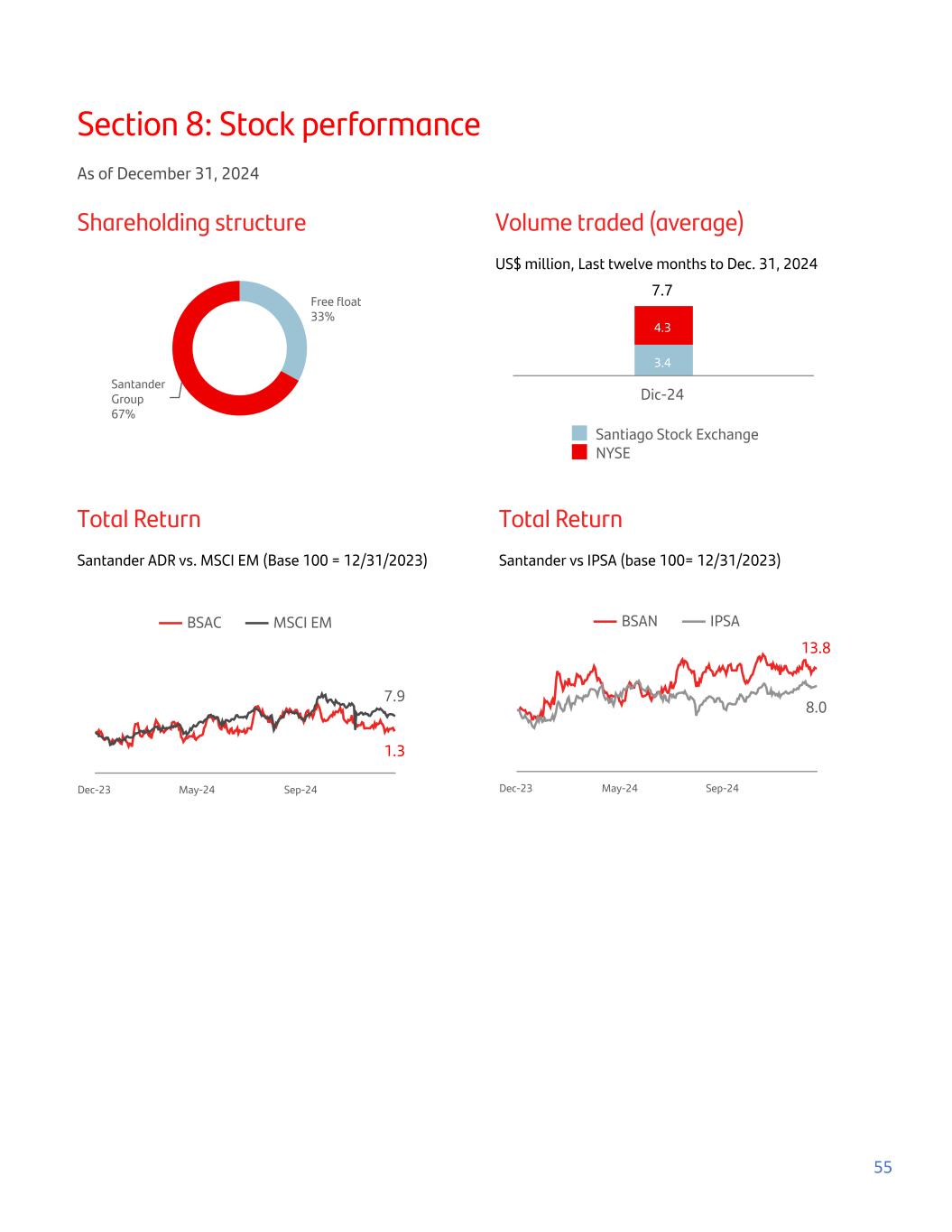
Section 8: Stock performance As of December 31, 2024 Shareholding structure Free float 33% Santander Group 67% Volume traded (average) US$ million, Last twelve months to Dec. 31, 2024 7.7 3.4 4.3 Santiago Stock Exchange NYSE Dic-24 Total Return Santander ADR vs. MSCI EM (Base 100 = 12/31/2023) 1.3 7.9 BSAC MSCI EM Dec-23 May-24 Sep-24 Total Return Santander vs IPSA (base 100= 12/31/2023) 13.8 8.0 BSAN IPSA Dec-23 May-24 Sep-24 55
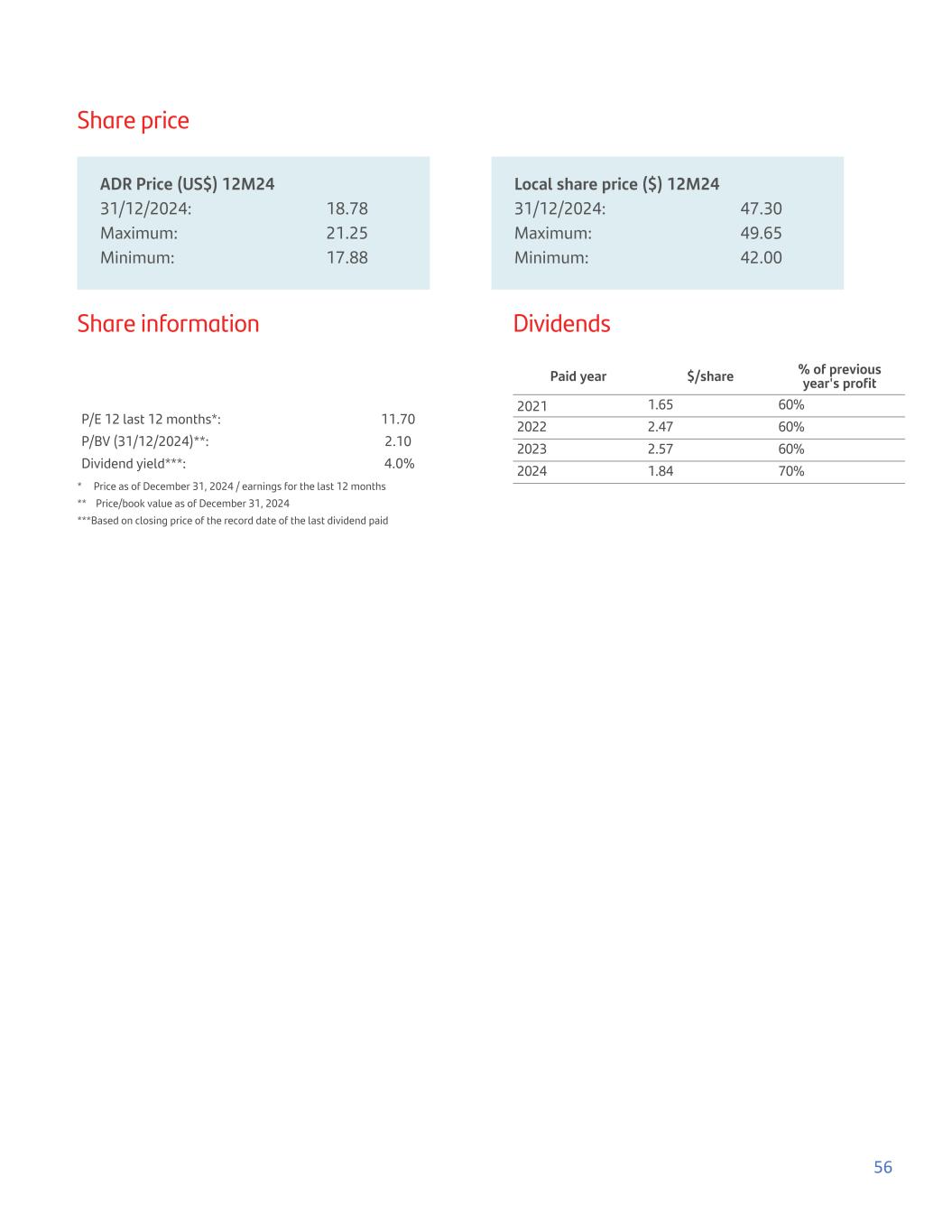
Share price ADR Price (US$) 12M24 Local share price ($) 12M24 31/12/2024: 18.78 31/12/2024: 47.30 Maximum: 21.25 Maximum: 49.65 Minimum: 17.88 Minimum: 42.00 We are building a more responsible bank. responsible. Share information P/E 12 last 12 months*: 11.70 P/BV (31/12/2024)**: 2.10 Dividend yield***: 4.0% * Price as of December 31, 2024 / earnings for the last 12 months ** Price/book value as of December 31, 2024 ***Based on closing price of the record date of the last dividend paid Dividends Paid year $/share % of previous year's profit 2021 1.65 60% 2022 2.47 60% 2023 2.57 60% 2024 1.84 70% 56
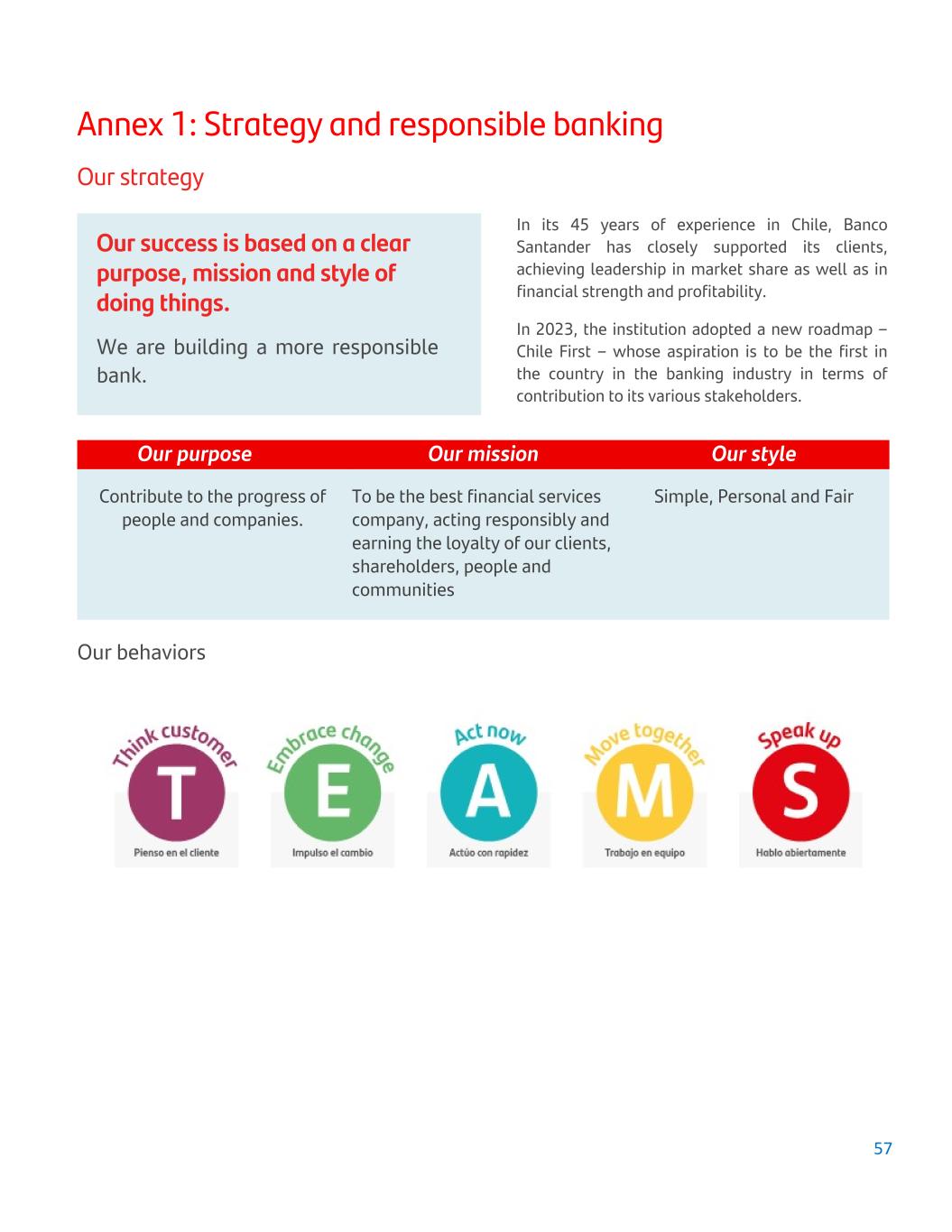
Annex 1: Strategy and responsible banking Our strategy In its 45 years of experience in Chile, Banco Santander has closely supported its clients, achieving leadership in market share as well as in financial strength and profitability. In 2023, the institution adopted a new roadmap – Chile First – whose aspiration is to be the first in the country in the banking industry in terms of contribution to its various stakeholders. Our success is based on a clear purpose, mission and style of doing things. We are building a more responsible bank. Our purpose Our mission Our style Contribute to the progress of people and companies. To be the best financial services company, acting responsibly and earning the loyalty of our clients, shareholders, people and communities Simple, Personal and Fair Our behaviors 57
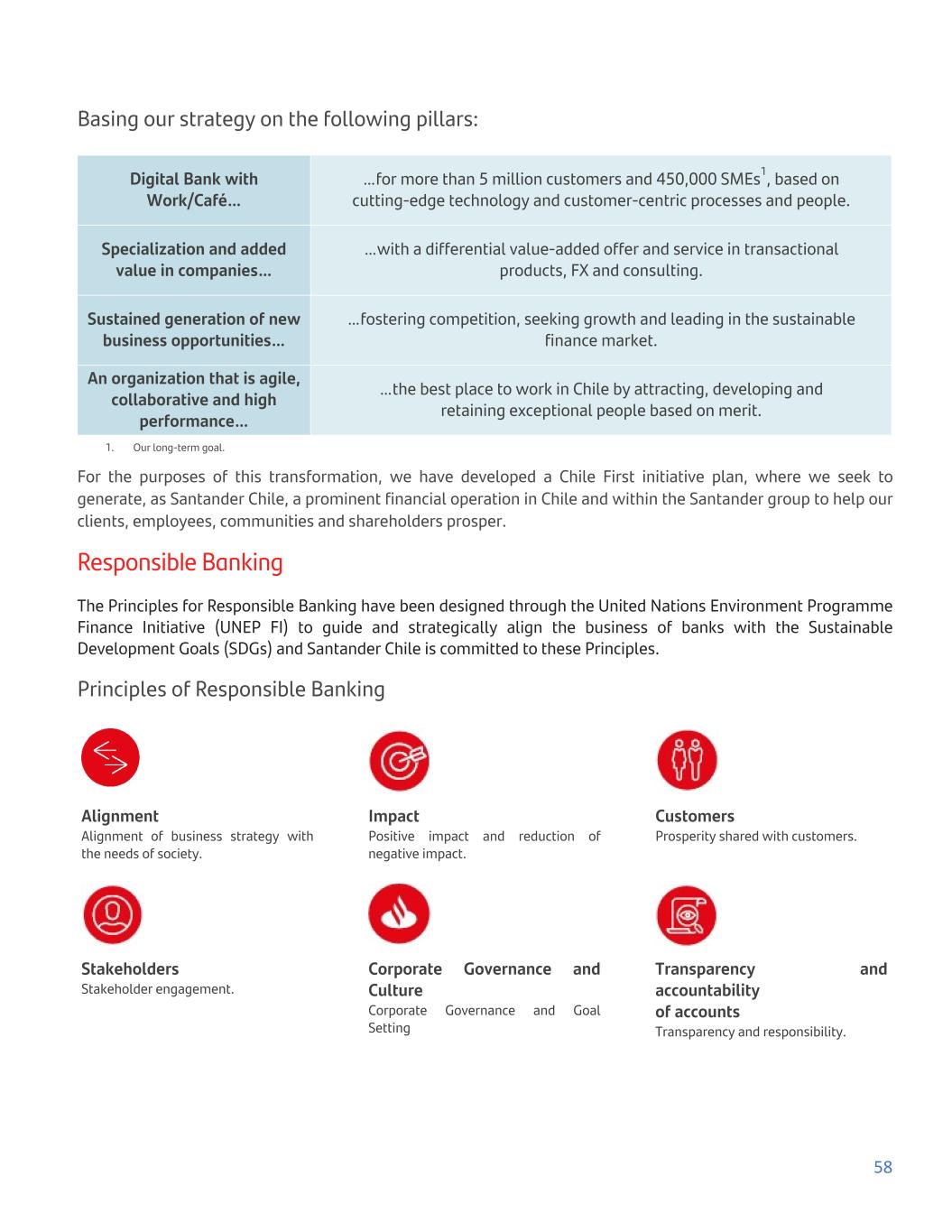
Basing our strategy on the following pillars: Digital Bank with Work/Café… …for more than 5 million customers and 450,000 SMEs1, based on cutting-edge technology and customer-centric processes and people. Specialization and added value in companies… …with a differential value-added offer and service in transactional products, FX and consulting. Sustained generation of new business opportunities… …fostering competition, seeking growth and leading in the sustainable finance market. An organization that is agile, collaborative and high performance… …the best place to work in Chile by attracting, developing and retaining exceptional people based on merit. 1. Our long-term goal. For the purposes of this transformation, we have developed a Chile First initiative plan, where we seek to generate, as Santander Chile, a prominent financial operation in Chile and within the Santander group to help our clients, employees, communities and shareholders prosper. Responsible Banking The Principles for Responsible Banking have been designed through the United Nations Environment Programme Finance Initiative (UNEP FI) to guide and strategically align the business of banks with the Sustainable Development Goals (SDGs) and Santander Chile is committed to these Principles. Principles of Responsible Banking Alignment Alignment of business strategy with the needs of society. Impact Positive impact and reduction of negative impact. Customers Prosperity shared with customers. Stakeholders Stakeholder engagement. Corporate Governance and Culture Corporate Governance and Goal Setting Transparency and accountability of accounts Transparency and responsibility. 58
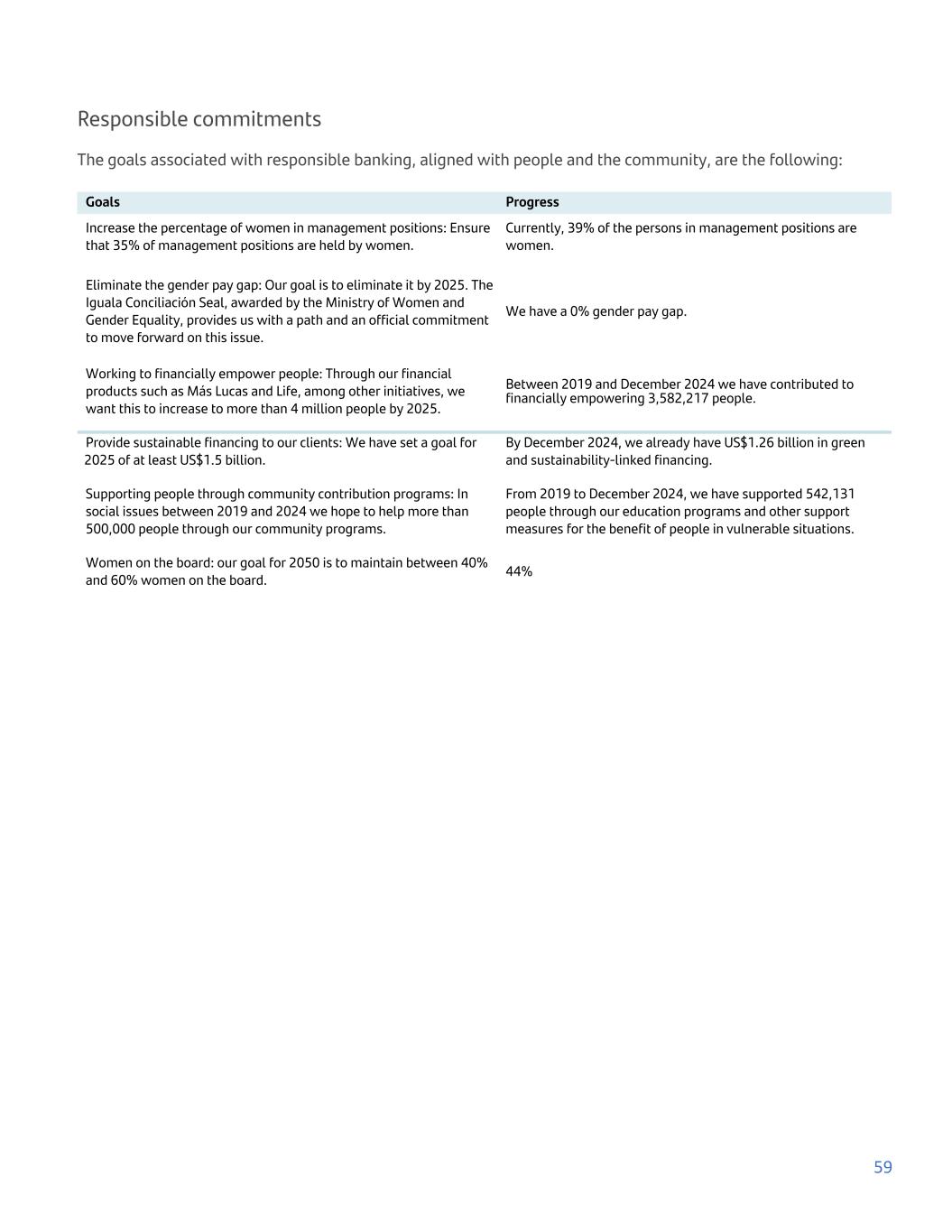
Responsible commitments The goals associated with responsible banking, aligned with people and the community, are the following: Goals Progress Increase the percentage of women in management positions: Ensure that 35% of management positions are held by women. Currently, 39% of the persons in management positions are women. Eliminate the gender pay gap: Our goal is to eliminate it by 2025. The Iguala Conciliación Seal, awarded by the Ministry of Women and Gender Equality, provides us with a path and an official commitment to move forward on this issue. We have a 0% gender pay gap. Working to financially empower people: Through our financial products such as Más Lucas and Life, among other initiatives, we want this to increase to more than 4 million people by 2025. Between 2019 and December 2024 we have contributed to financially empowering 3,582,217 people. Provide sustainable financing to our clients: We have set a goal for 2025 of at least US$1.5 billion. By December 2024, we already have US$1.26 billion in green and sustainability-linked financing. Supporting people through community contribution programs: In social issues between 2019 and 2024 we hope to help more than 500,000 people through our community programs. From 2019 to December 2024, we have supported 542,131 people through our education programs and other support measures for the benefit of people in vulnerable situations. Women on the board: our goal for 2050 is to maintain between 40% and 60% women on the board. 44% 59
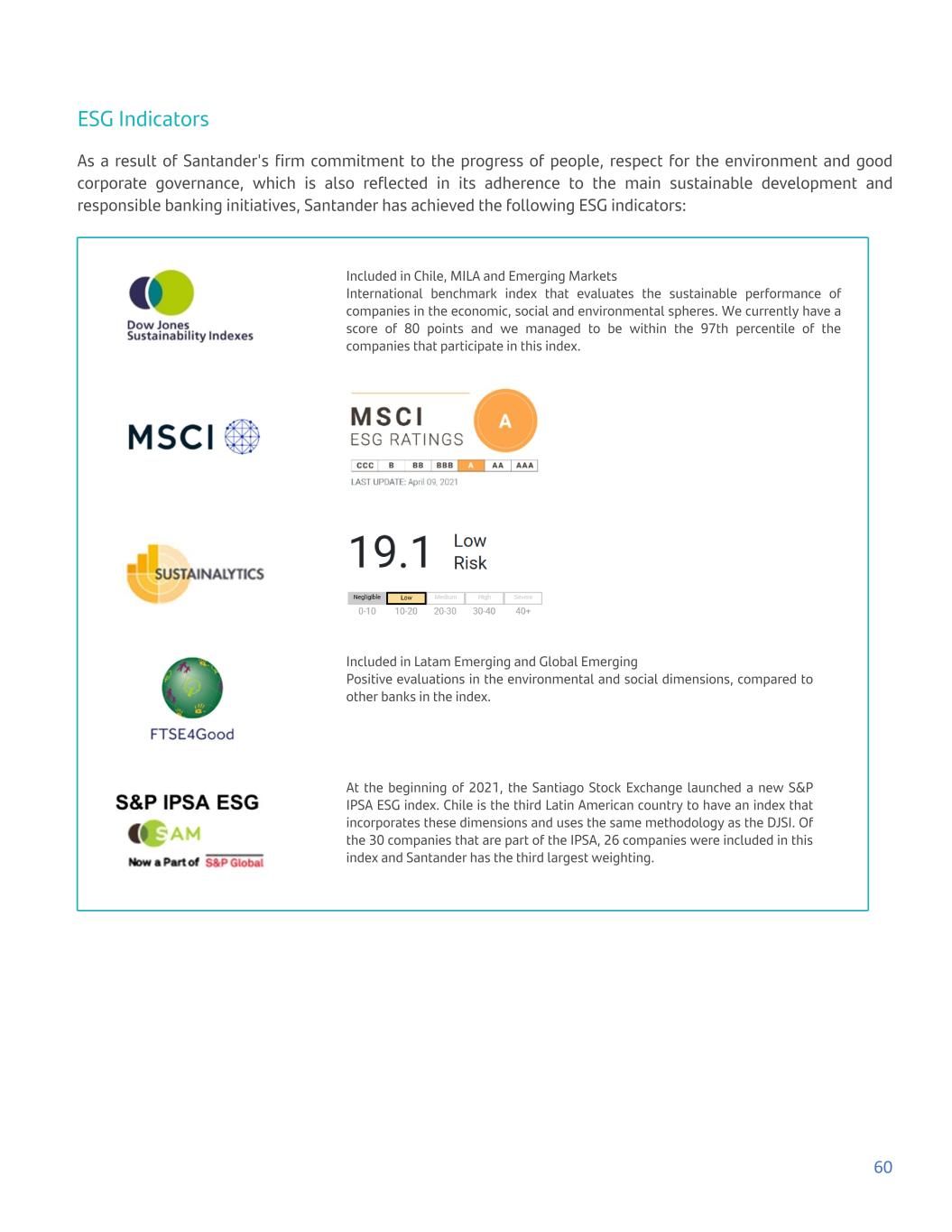
ESG Indicators As a result of Santander's firm commitment to the progress of people, respect for the environment and good corporate governance, which is also reflected in its adherence to the main sustainable development and responsible banking initiatives, Santander has achieved the following ESG indicators: Included in Chile, MILA and Emerging Markets International benchmark index that evaluates the sustainable performance of companies in the economic, social and environmental spheres. We currently have a score of 80 points and we managed to be within the 97th percentile of the companies that participate in this index. Included in Latam Emerging and Global Emerging Positive evaluations in the environmental and social dimensions, compared to other banks in the index. At the beginning of 2021, the Santiago Stock Exchange launched a new S&P IPSA ESG index. Chile is the third Latin American country to have an index that incorporates these dimensions and uses the same methodology as the DJSI. Of the 30 companies that are part of the IPSA, 26 companies were included in this index and Santander has the third largest weighting. 60
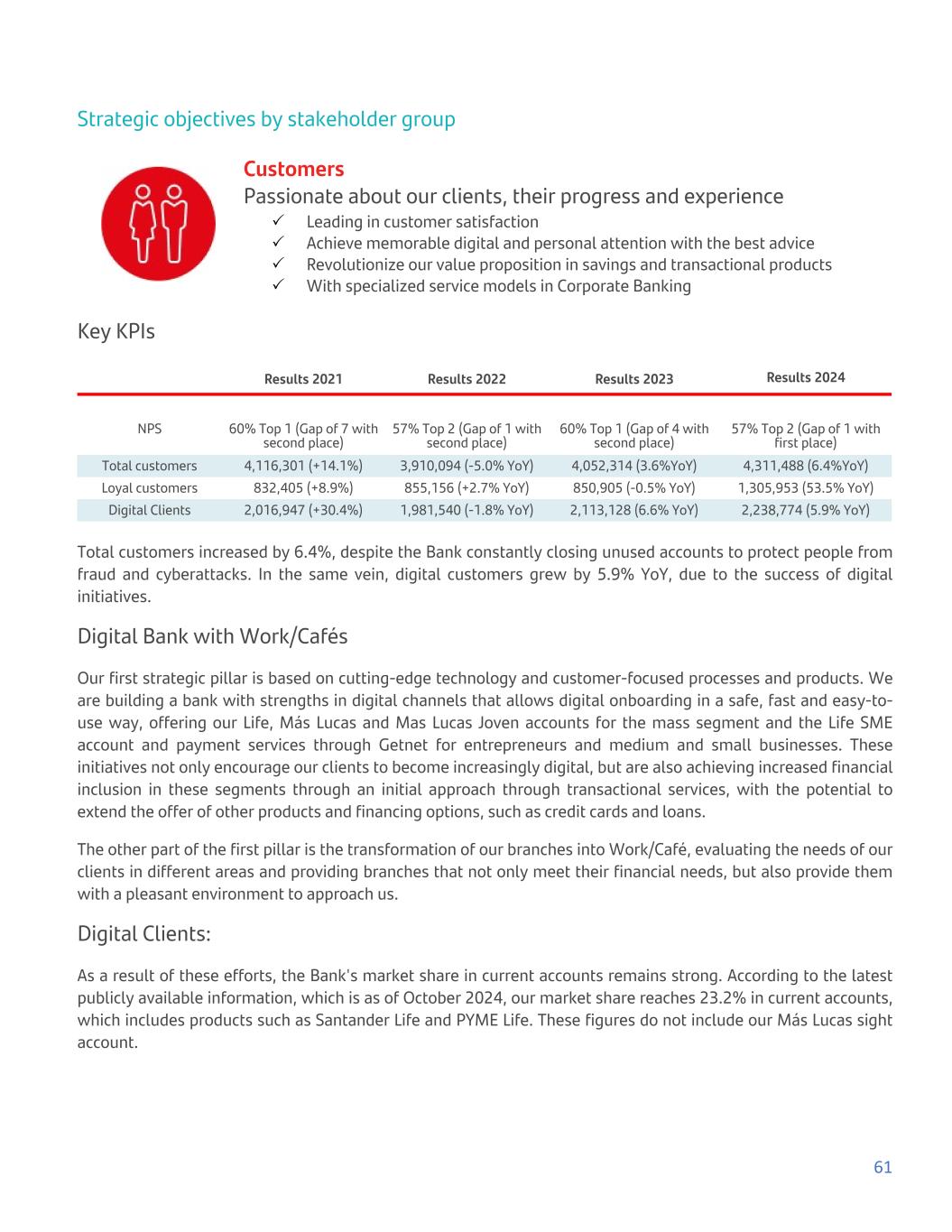
Strategic objectives by stakeholder group Customers Passionate about our clients, their progress and experience P Leading in customer satisfaction P Achieve memorable digital and personal attention with the best advice P Revolutionize our value proposition in savings and transactional products P With specialized service models in Corporate Banking Key KPIs Results 2021 Results 2022 Results 2023 Results 2024 NPS 60% Top 1 (Gap of 7 with second place) 57% Top 2 (Gap of 1 with second place) 60% Top 1 (Gap of 4 with second place) 57% Top 2 (Gap of 1 with first place) Total customers 4,116,301 (+14.1%) 3,910,094 (-5.0% YoY) 4,052,314 (3.6%YoY) 4,311,488 (6.4%YoY) Loyal customers 832,405 (+8.9%) 855,156 (+2.7% YoY) 850,905 (-0.5% YoY) 1,305,953 (53.5% YoY) Digital Clients 2,016,947 (+30.4%) 1,981,540 (-1.8% YoY) 2,113,128 (6.6% YoY) 2,238,774 (5.9% YoY) Total customers increased by 6.4%, despite the Bank constantly closing unused accounts to protect people from fraud and cyberattacks. In the same vein, digital customers grew by 5.9% YoY, due to the success of digital initiatives. Digital Bank with Work/Cafés Our first strategic pillar is based on cutting-edge technology and customer-focused processes and products. We are building a bank with strengths in digital channels that allows digital onboarding in a safe, fast and easy-to- use way, offering our Life, Más Lucas and Mas Lucas Joven accounts for the mass segment and the Life SME account and payment services through Getnet for entrepreneurs and medium and small businesses. These initiatives not only encourage our clients to become increasingly digital, but are also achieving increased financial inclusion in these segments through an initial approach through transactional services, with the potential to extend the offer of other products and financing options, such as credit cards and loans. The other part of the first pillar is the transformation of our branches into Work/Café, evaluating the needs of our clients in different areas and providing branches that not only meet their financial needs, but also provide them with a pleasant environment to approach us. Digital Clients: As a result of these efforts, the Bank's market share in current accounts remains strong. According to the latest publicly available information, which is as of October 2024, our market share reaches 23.2% in current accounts, which includes products such as Santander Life and PYME Life. These figures do not include our Más Lucas sight account. 61
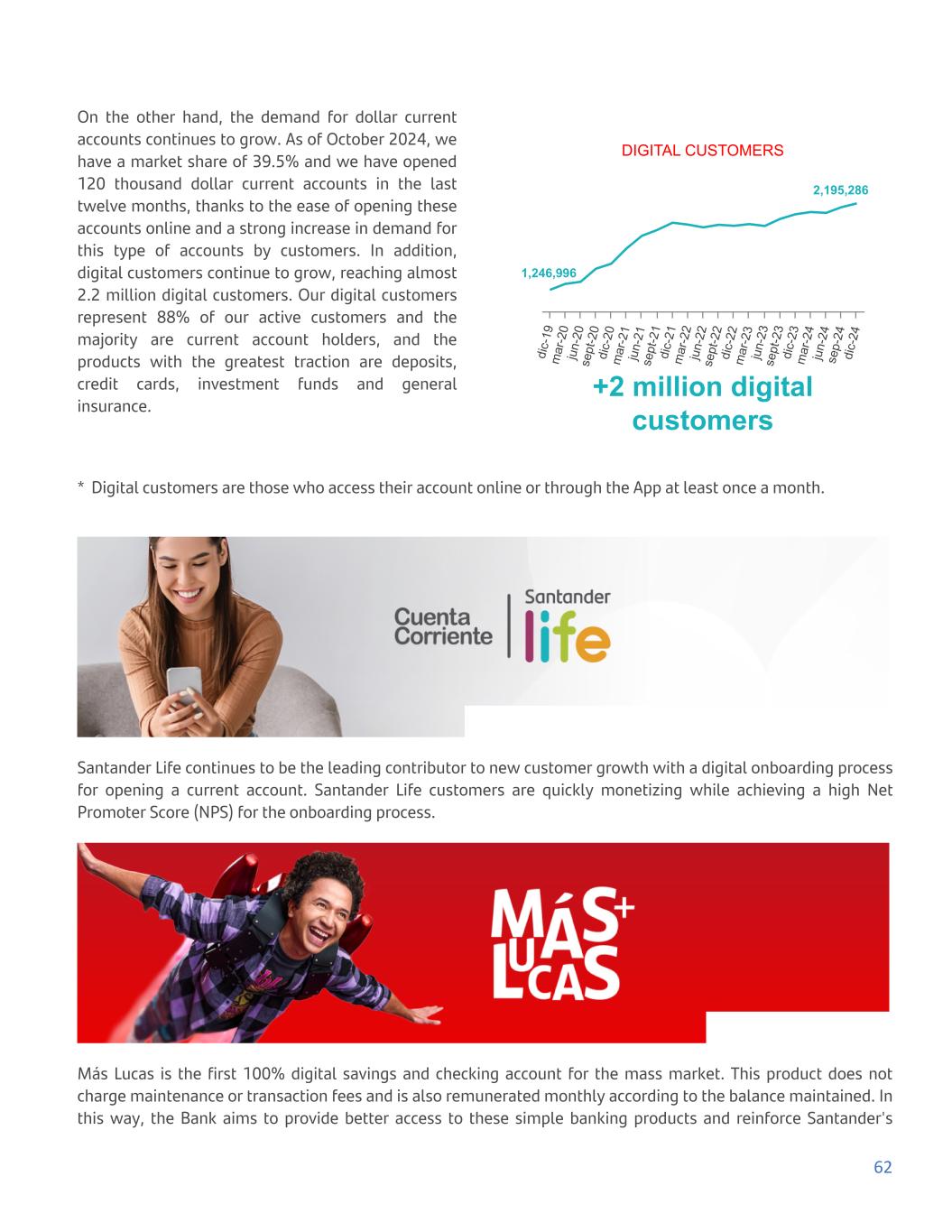
On the other hand, the demand for dollar current accounts continues to grow. As of October 2024, we have a market share of 39.5% and we have opened 120 thousand dollar current accounts in the last twelve months, thanks to the ease of opening these accounts online and a strong increase in demand for this type of accounts by customers. In addition, digital customers continue to grow, reaching almost 2.2 million digital customers. Our digital customers represent 88% of our active customers and the majority are current account holders, and the products with the greatest traction are deposits, credit cards, investment funds and general insurance. +2 million digital customers DIGITAL CUSTOMERS 1,246,996 2,195,286 di c- 19 m ar -2 0 ju n- 20 se pt -2 0 di c- 20 m ar -2 1 ju n- 21 se pt -2 1 di c- 21 m ar -2 2 ju n- 22 se pt -2 2 di c- 22 m ar -2 3 ju n- 23 se pt -2 3 di c- 23 m ar -2 4 ju n- 24 se p- 24 di c- 24 * Digital customers are those who access their account online or through the App at least once a month. Santander Life continues to be the leading contributor to new customer growth with a digital onboarding process for opening a current account. Santander Life customers are quickly monetizing while achieving a high Net Promoter Score (NPS) for the onboarding process. Más Lucas is the first 100% digital savings and checking account for the mass market. This product does not charge maintenance or transaction fees and is also remunerated monthly according to the balance maintained. In this way, the Bank aims to provide better access to these simple banking products and reinforce Santander's 62
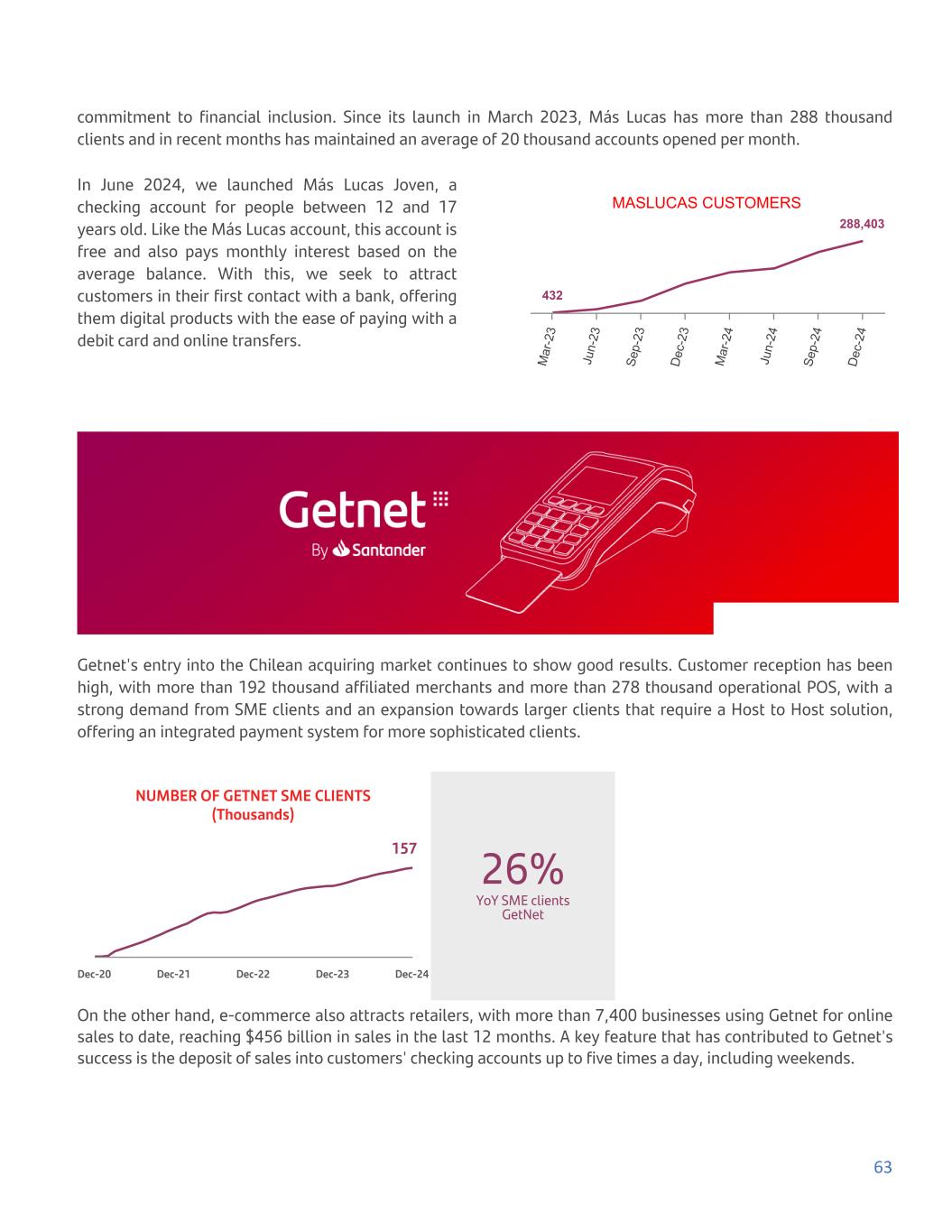
commitment to financial inclusion. Since its launch in March 2023, Más Lucas has more than 288 thousand clients and in recent months has maintained an average of 20 thousand accounts opened per month. In June 2024, we launched Más Lucas Joven, a checking account for people between 12 and 17 years old. Like the Más Lucas account, this account is free and also pays monthly interest based on the average balance. With this, we seek to attract customers in their first contact with a bank, offering them digital products with the ease of paying with a debit card and online transfers. MASLUCAS CUSTOMERS 432 288,403 M ar -2 3 Ju n- 23 Se p- 23 D ec -2 3 M ar -2 4 Ju n- 24 Se p- 24 D ec -2 4 Getnet's entry into the Chilean acquiring market continues to show good results. Customer reception has been high, with more than 192 thousand affiliated merchants and more than 278 thousand operational POS, with a strong demand from SME clients and an expansion towards larger clients that require a Host to Host solution, offering an integrated payment system for more sophisticated clients. NUMBER OF GETNET SME CLIENTS (Thousands) 157 Dec-20 Dec-21 Dec-22 Dec-23 Dec-24 26% YoY SME clients GetNet On the other hand, e-commerce also attracts retailers, with more than 7,400 businesses using Getnet for online sales to date, reaching $456 billion in sales in the last 12 months. A key feature that has contributed to Getnet's success is the deposit of sales into customers' checking accounts up to five times a day, including weekends. 63
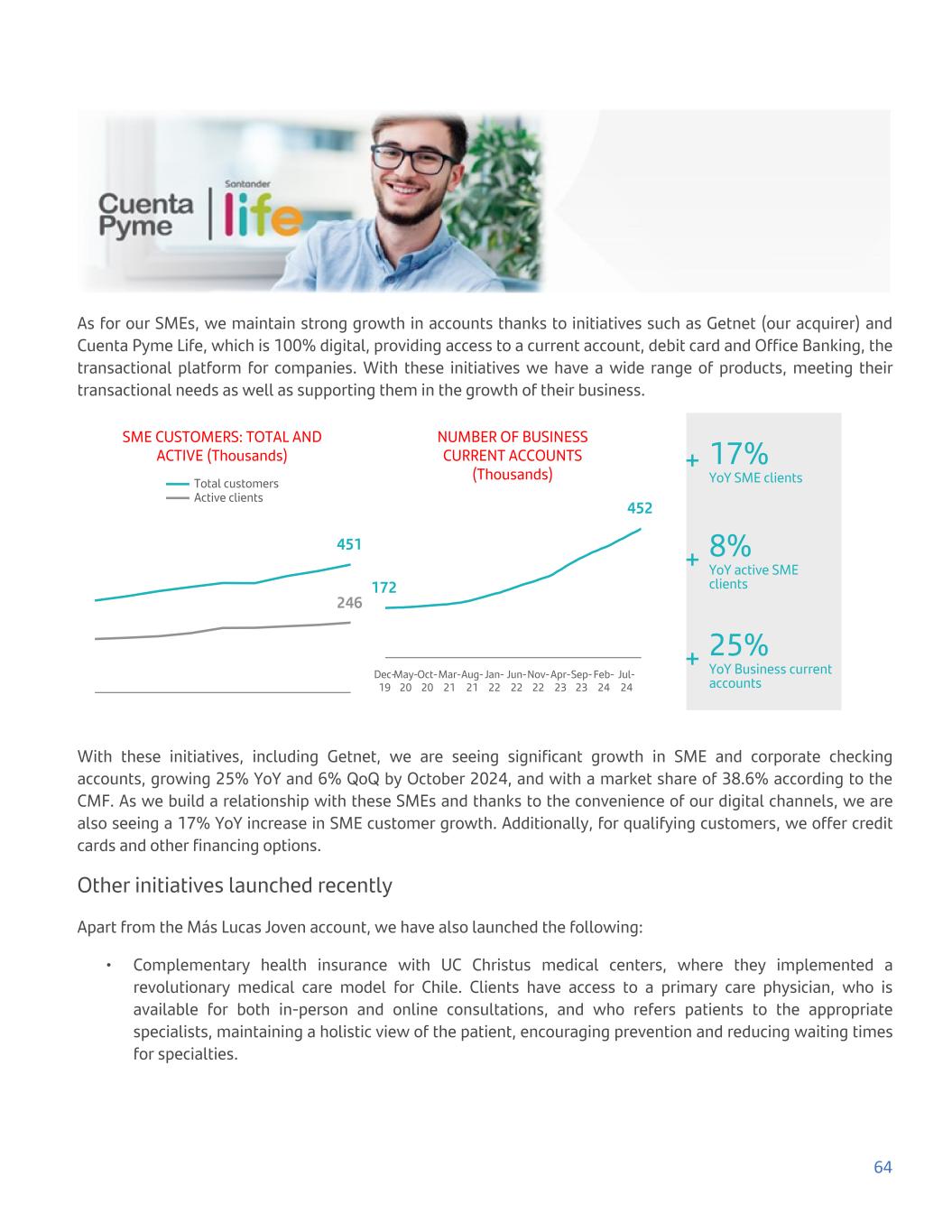
As for our SMEs, we maintain strong growth in accounts thanks to initiatives such as Getnet (our acquirer) and Cuenta Pyme Life, which is 100% digital, providing access to a current account, debit card and Office Banking, the transactional platform for companies. With these initiatives we have a wide range of products, meeting their transactional needs as well as supporting them in the growth of their business. SME CUSTOMERS: TOTAL AND ACTIVE (Thousands) 451 246 Total customers Active clients NUMBER OF BUSINESS CURRENT ACCOUNTS (Thousands) 172 452 Dec- 19 May- 20 Oct- 20 Mar- 21 Aug- 21 Jan- 22 Jun- 22 Nov- 22 Apr- 23 Sep- 23 Feb- 24 Jul- 24 + 17% YoY SME clients + 8% YoY active SME clients + 25% YoY Business current accounts With these initiatives, including Getnet, we are seeing significant growth in SME and corporate checking accounts, growing 25% YoY and 6% QoQ by October 2024, and with a market share of 38.6% according to the CMF. As we build a relationship with these SMEs and thanks to the convenience of our digital channels, we are also seeing a 17% YoY increase in SME customer growth. Additionally, for qualifying customers, we offer credit cards and other financing options. Other initiatives launched recently Apart from the Más Lucas Joven account, we have also launched the following: • Complementary health insurance with UC Christus medical centers, where they implemented a revolutionary medical care model for Chile. Clients have access to a primary care physician, who is available for both in-person and online consultations, and who refers patients to the appropriate specialists, maintaining a holistic view of the patient, encouraging prevention and reducing waiting times for specialties. 64
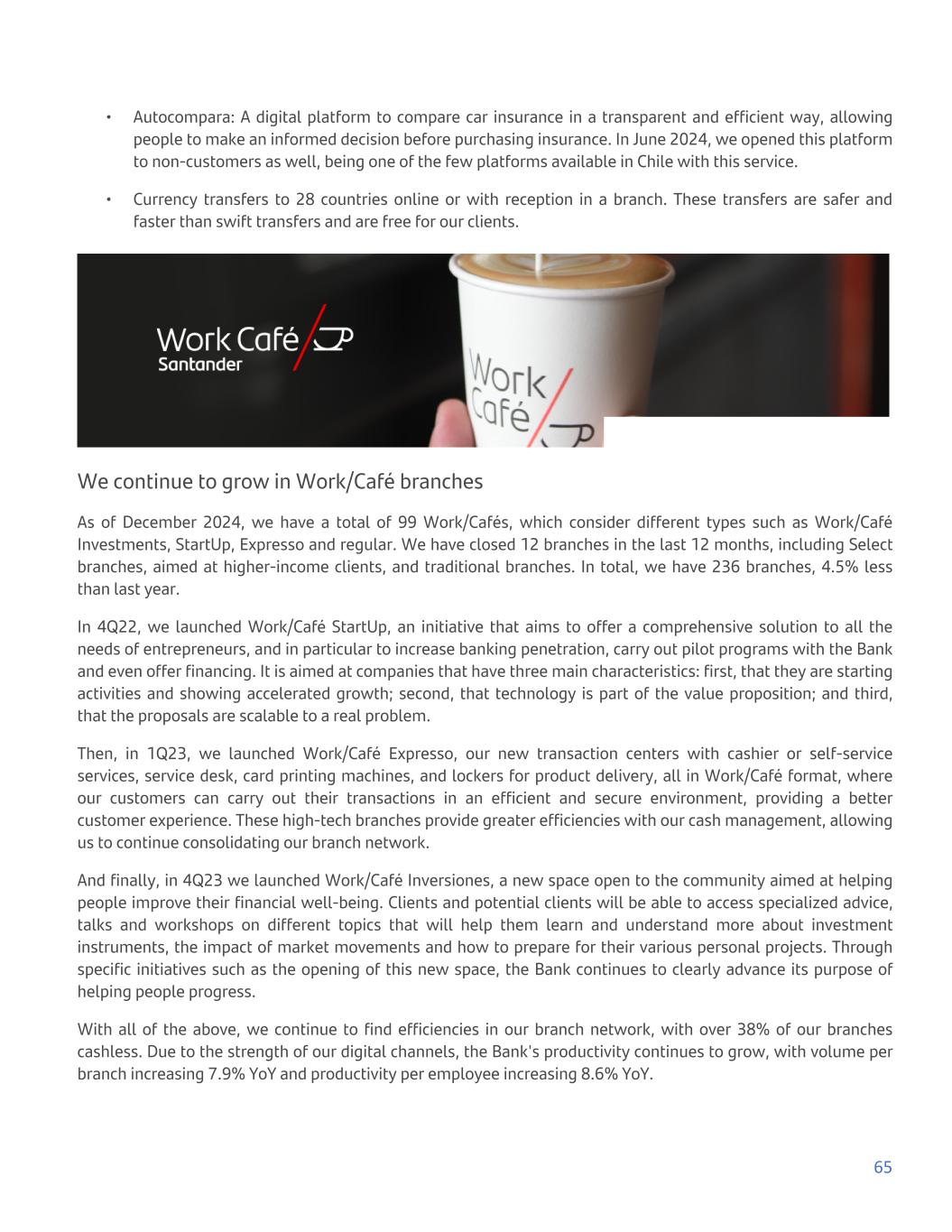
• Autocompara: A digital platform to compare car insurance in a transparent and efficient way, allowing people to make an informed decision before purchasing insurance. In June 2024, we opened this platform to non-customers as well, being one of the few platforms available in Chile with this service. • Currency transfers to 28 countries online or with reception in a branch. These transfers are safer and faster than swift transfers and are free for our clients. We continue to grow in Work/Café branches As of December 2024, we have a total of 99 Work/Cafés, which consider different types such as Work/Café Investments, StartUp, Expresso and regular. We have closed 12 branches in the last 12 months, including Select branches, aimed at higher-income clients, and traditional branches. In total, we have 236 branches, 4.5% less than last year. In 4Q22, we launched Work/Café StartUp, an initiative that aims to offer a comprehensive solution to all the needs of entrepreneurs, and in particular to increase banking penetration, carry out pilot programs with the Bank and even offer financing. It is aimed at companies that have three main characteristics: first, that they are starting activities and showing accelerated growth; second, that technology is part of the value proposition; and third, that the proposals are scalable to a real problem. Then, in 1Q23, we launched Work/Café Expresso, our new transaction centers with cashier or self-service services, service desk, card printing machines, and lockers for product delivery, all in Work/Café format, where our customers can carry out their transactions in an efficient and secure environment, providing a better customer experience. These high-tech branches provide greater efficiencies with our cash management, allowing us to continue consolidating our branch network. And finally, in 4Q23 we launched Work/Café Inversiones, a new space open to the community aimed at helping people improve their financial well-being. Clients and potential clients will be able to access specialized advice, talks and workshops on different topics that will help them learn and understand more about investment instruments, the impact of market movements and how to prepare for their various personal projects. Through specific initiatives such as the opening of this new space, the Bank continues to clearly advance its purpose of helping people progress. With all of the above, we continue to find efficiencies in our branch network, with over 38% of our branches cashless. Due to the strength of our digital channels, the Bank's productivity continues to grow, with volume per branch increasing 7.9% YoY and productivity per employee increasing 8.6% YoY. 65
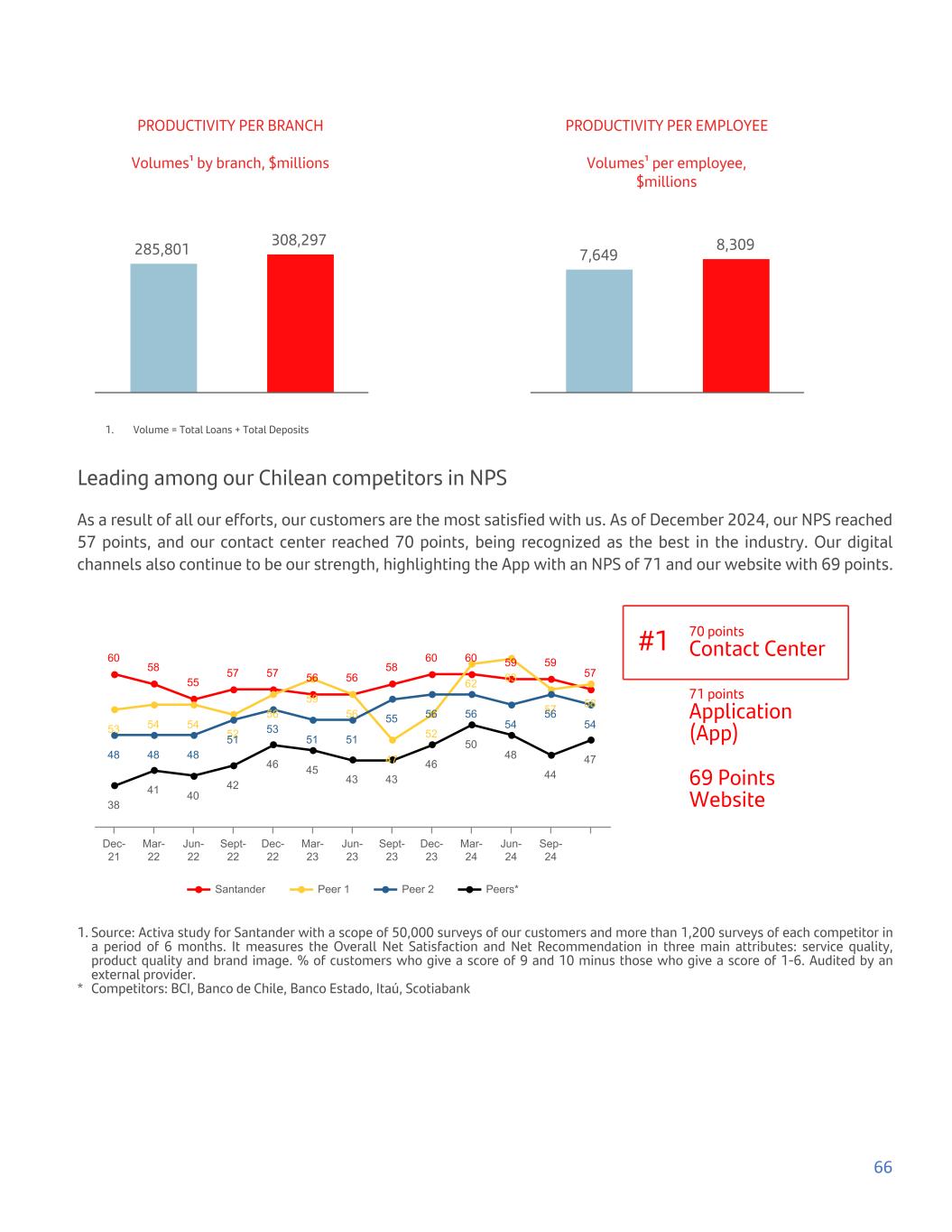
PRODUCTIVITY PER BRANCH Volumes¹ by branch, $millions 285,801 308,297 1. Volume = Total Loans + Total Deposits PRODUCTIVITY PER EMPLOYEE Volumes¹ per employee, $millions 7,649 8,309 Leading among our Chilean competitors in NPS As a result of all our efforts, our customers are the most satisfied with us. As of December 2024, our NPS reached 57 points, and our contact center reached 70 points, being recognized as the best in the industry. Our digital channels also continue to be our strength, highlighting the App with an NPS of 71 and our website with 69 points. 60 58 55 57 57 56 56 58 60 60 59 59 57 53 54 54 52 56 59 56 47 52 62 63 57 58 48 48 48 51 53 51 51 55 56 56 54 56 54 38 41 40 42 46 45 43 43 46 50 48 44 47 Santander Peer 1 Peer 2 Peers* Dec- 21 Mar- 22 Jun- 22 Sept- 22 Dec- 22 Mar- 23 Jun- 23 Sept- 23 Dec- 23 Mar- 24 Jun- 24 Sep- 24 #1 70 points Contact Center 71 points Application (App) 69 Points Website 1. Source: Activa study for Santander with a scope of 50,000 surveys of our customers and more than 1,200 surveys of each competitor in a period of 6 months. It measures the Overall Net Satisfaction and Net Recommendation in three main attributes: service quality, product quality and brand image. % of customers who give a score of 9 and 10 minus those who give a score of 1-6. Audited by an external provider. * Competitors: BCI, Banco de Chile, Banco Estado, Itaú, Scotiabank 66
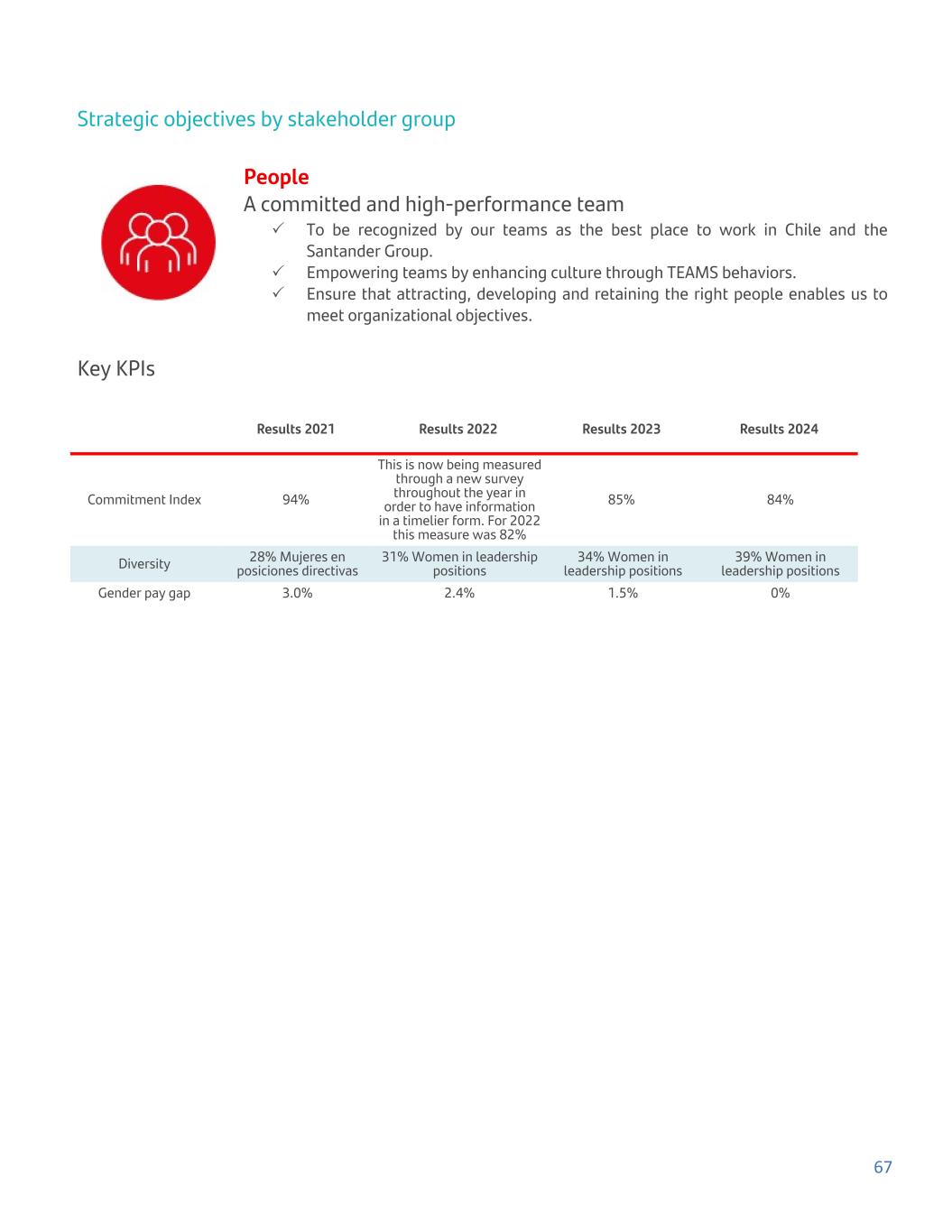
Strategic objectives by stakeholder group People A committed and high-performance team P To be recognized by our teams as the best place to work in Chile and the Santander Group. P Empowering teams by enhancing culture through TEAMS behaviors. P Ensure that attracting, developing and retaining the right people enables us to meet organizational objectives. Key KPIs Results 2021 Results 2022 Results 2023 Results 2024 Commitment Index 94% This is now being measured through a new survey throughout the year in order to have information in a timelier form. For 2022 this measure was 82% 85% 84% Diversity 28% Mujeres en posiciones directivas 31% Women in leadership positions 34% Women in leadership positions 39% Women in leadership positions Gender pay gap 3.0% 2.4% 1.5% 0% 67
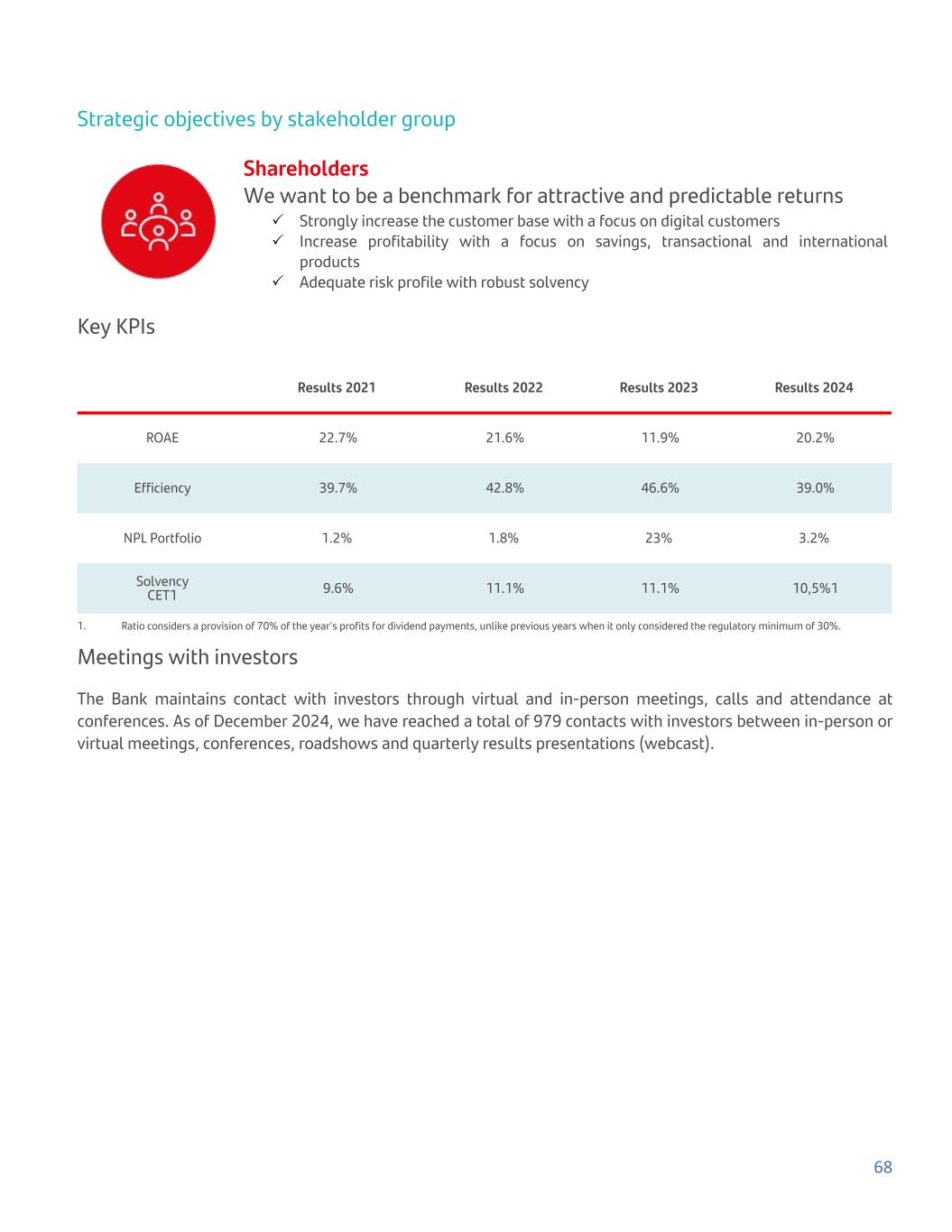
Strategic objectives by stakeholder group Shareholders We want to be a benchmark for attractive and predictable returns P Strongly increase the customer base with a focus on digital customers P Increase profitability with a focus on savings, transactional and international products P Adequate risk profile with robust solvency Key KPIs Results 2021 Results 2022 Results 2023 Results 2024 ROAE 22.7% 21.6% 11.9% 20.2% Efficiency 39.7% 42.8% 46.6% 39.0% NPL Portfolio 1.2% 1.8% 23% 3.2% Solvency CET1 9.6% 11.1% 11.1% 10,5%1 1. Ratio considers a provision of 70% of the year's profits for dividend payments, unlike previous years when it only considered the regulatory minimum of 30%. Meetings with investors The Bank maintains contact with investors through virtual and in-person meetings, calls and attendance at conferences. As of December 2024, we have reached a total of 979 contacts with investors between in-person or virtual meetings, conferences, roadshows and quarterly results presentations (webcast). 68
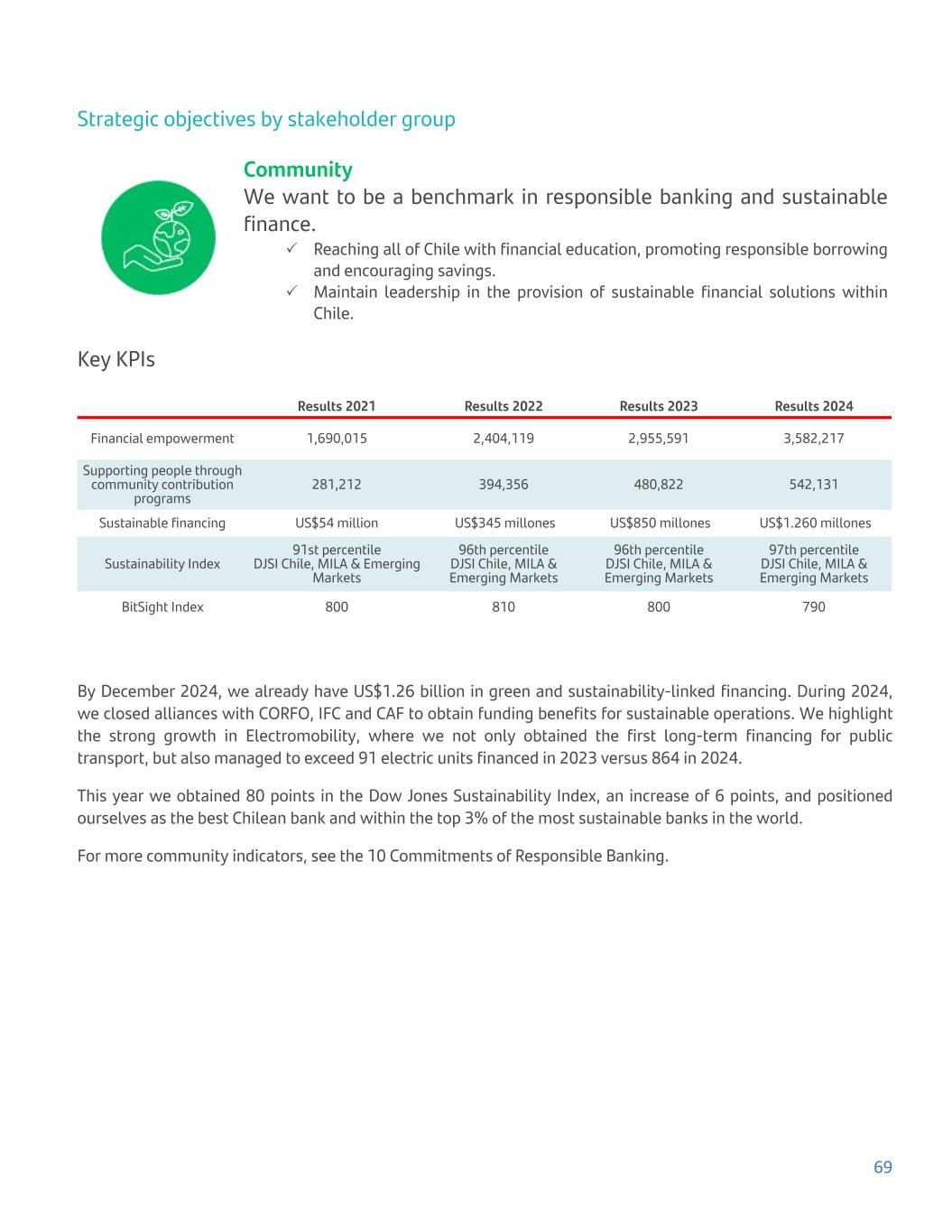
Strategic objectives by stakeholder group Community We want to be a benchmark in responsible banking and sustainable finance. P Reaching all of Chile with financial education, promoting responsible borrowing and encouraging savings. P Maintain leadership in the provision of sustainable financial solutions within Chile. Key KPIs Results 2021 Results 2022 Results 2023 Results 2024 Financial empowerment 1,690,015 2,404,119 2,955,591 3,582,217 Supporting people through community contribution programs 281,212 394,356 480,822 542,131 Sustainable financing US$54 million US$345 millones US$850 millones US$1.260 millones Sustainability Index 91st percentile DJSI Chile, MILA & Emerging Markets 96th percentile DJSI Chile, MILA & Emerging Markets 96th percentile DJSI Chile, MILA & Emerging Markets 97th percentile DJSI Chile, MILA & Emerging Markets BitSight Index 800 810 800 790 By December 2024, we already have US$1.26 billion in green and sustainability-linked financing. During 2024, we closed alliances with CORFO, IFC and CAF to obtain funding benefits for sustainable operations. We highlight the strong growth in Electromobility, where we not only obtained the first long-term financing for public transport, but also managed to exceed 91 electric units financed in 2023 versus 864 in 2024. This year we obtained 80 points in the Dow Jones Sustainability Index, an increase of 6 points, and positioned ourselves as the best Chilean bank and within the top 3% of the most sustainable banks in the world. For more community indicators, see the 10 Commitments of Responsible Banking. 69
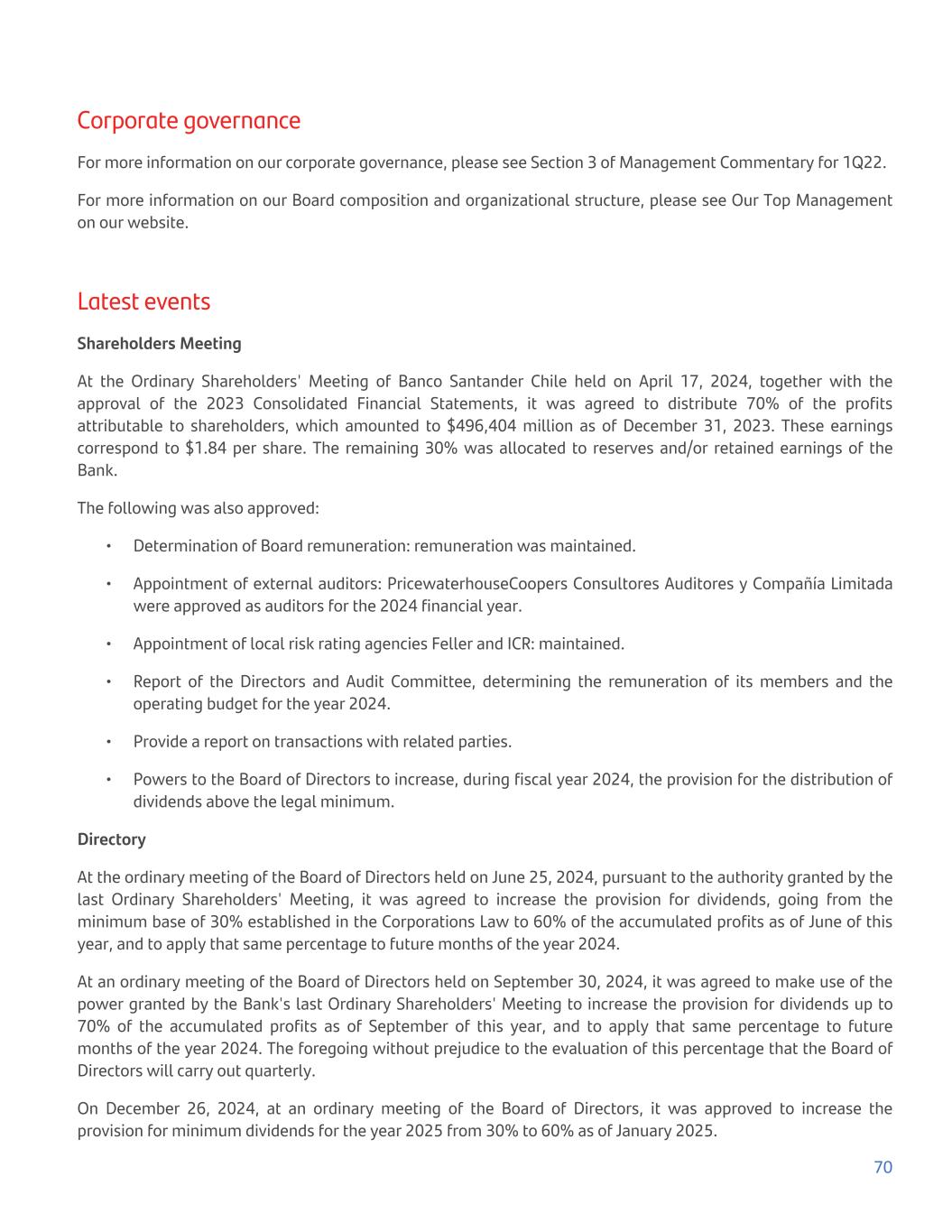
Corporate governance For more information on our corporate governance, please see Section 3 of Management Commentary for 1Q22. For more information on our Board composition and organizational structure, please see Our Top Management on our website. Latest events Shareholders Meeting At the Ordinary Shareholders' Meeting of Banco Santander Chile held on April 17, 2024, together with the approval of the 2023 Consolidated Financial Statements, it was agreed to distribute 70% of the profits attributable to shareholders, which amounted to $496,404 million as of December 31, 2023. These earnings correspond to $1.84 per share. The remaining 30% was allocated to reserves and/or retained earnings of the Bank. The following was also approved: • Determination of Board remuneration: remuneration was maintained. • Appointment of external auditors: PricewaterhouseCoopers Consultores Auditores y Compañía Limitada were approved as auditors for the 2024 financial year. • Appointment of local risk rating agencies Feller and ICR: maintained. • Report of the Directors and Audit Committee, determining the remuneration of its members and the operating budget for the year 2024. • Provide a report on transactions with related parties. • Powers to the Board of Directors to increase, during fiscal year 2024, the provision for the distribution of dividends above the legal minimum. Directory At the ordinary meeting of the Board of Directors held on June 25, 2024, pursuant to the authority granted by the last Ordinary Shareholders' Meeting, it was agreed to increase the provision for dividends, going from the minimum base of 30% established in the Corporations Law to 60% of the accumulated profits as of June of this year, and to apply that same percentage to future months of the year 2024. At an ordinary meeting of the Board of Directors held on September 30, 2024, it was agreed to make use of the power granted by the Bank's last Ordinary Shareholders' Meeting to increase the provision for dividends up to 70% of the accumulated profits as of September of this year, and to apply that same percentage to future months of the year 2024. The foregoing without prejudice to the evaluation of this percentage that the Board of Directors will carry out quarterly. On December 26, 2024, at an ordinary meeting of the Board of Directors, it was approved to increase the provision for minimum dividends for the year 2025 from 30% to 60% as of January 2025. 70
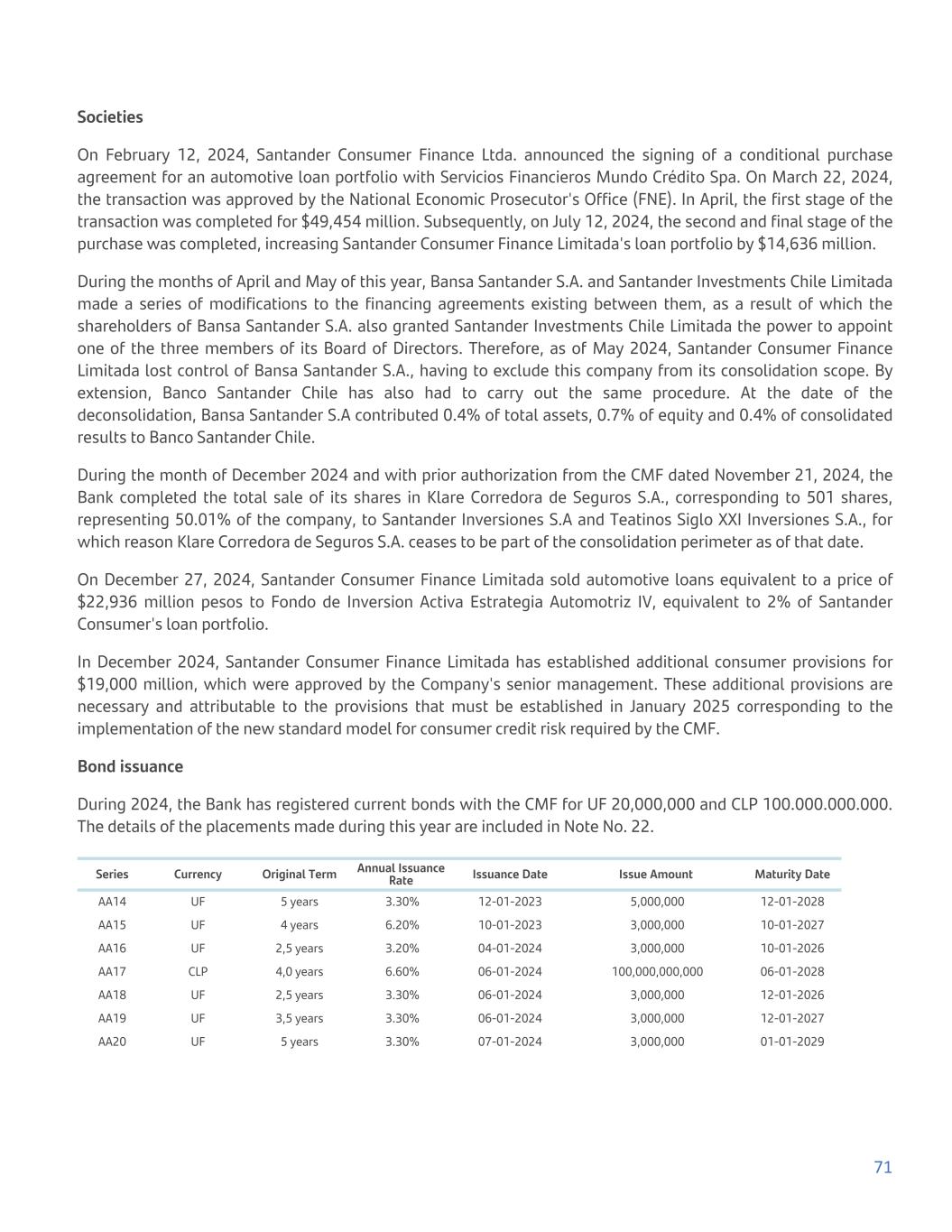
Societies On February 12, 2024, Santander Consumer Finance Ltda. announced the signing of a conditional purchase agreement for an automotive loan portfolio with Servicios Financieros Mundo Crédito Spa. On March 22, 2024, the transaction was approved by the National Economic Prosecutor's Office (FNE). In April, the first stage of the transaction was completed for $49,454 million. Subsequently, on July 12, 2024, the second and final stage of the purchase was completed, increasing Santander Consumer Finance Limitada's loan portfolio by $14,636 million. During the months of April and May of this year, Bansa Santander S.A. and Santander Investments Chile Limitada made a series of modifications to the financing agreements existing between them, as a result of which the shareholders of Bansa Santander S.A. also granted Santander Investments Chile Limitada the power to appoint one of the three members of its Board of Directors. Therefore, as of May 2024, Santander Consumer Finance Limitada lost control of Bansa Santander S.A., having to exclude this company from its consolidation scope. By extension, Banco Santander Chile has also had to carry out the same procedure. At the date of the deconsolidation, Bansa Santander S.A contributed 0.4% of total assets, 0.7% of equity and 0.4% of consolidated results to Banco Santander Chile. During the month of December 2024 and with prior authorization from the CMF dated November 21, 2024, the Bank completed the total sale of its shares in Klare Corredora de Seguros S.A., corresponding to 501 shares, representing 50.01% of the company, to Santander Inversiones S.A and Teatinos Siglo XXI Inversiones S.A., for which reason Klare Corredora de Seguros S.A. ceases to be part of the consolidation perimeter as of that date. On December 27, 2024, Santander Consumer Finance Limitada sold automotive loans equivalent to a price of $22,936 million pesos to Fondo de Inversion Activa Estrategia Automotriz IV, equivalent to 2% of Santander Consumer's loan portfolio. In December 2024, Santander Consumer Finance Limitada has established additional consumer provisions for $19,000 million, which were approved by the Company's senior management. These additional provisions are necessary and attributable to the provisions that must be established in January 2025 corresponding to the implementation of the new standard model for consumer credit risk required by the CMF. Bond issuance During 2024, the Bank has registered current bonds with the CMF for UF 20,000,000 and CLP 100.000.000.000. The details of the placements made during this year are included in Note No. 22. Series Currency Original Term Annual Issuance Rate Issuance Date Issue Amount Maturity Date AA14 UF 5 years 3.30% 12-01-2023 5,000,000 12-01-2028 AA15 UF 4 years 6.20% 10-01-2023 3,000,000 10-01-2027 AA16 UF 2,5 years 3.20% 04-01-2024 3,000,000 10-01-2026 AA17 CLP 4,0 years 6.60% 06-01-2024 100,000,000,000 06-01-2028 AA18 UF 2,5 years 3.30% 06-01-2024 3,000,000 12-01-2026 AA19 UF 3,5 years 3.30% 06-01-2024 3,000,000 12-01-2027 AA20 UF 5 years 3.30% 07-01-2024 3,000,000 01-01-2029 71
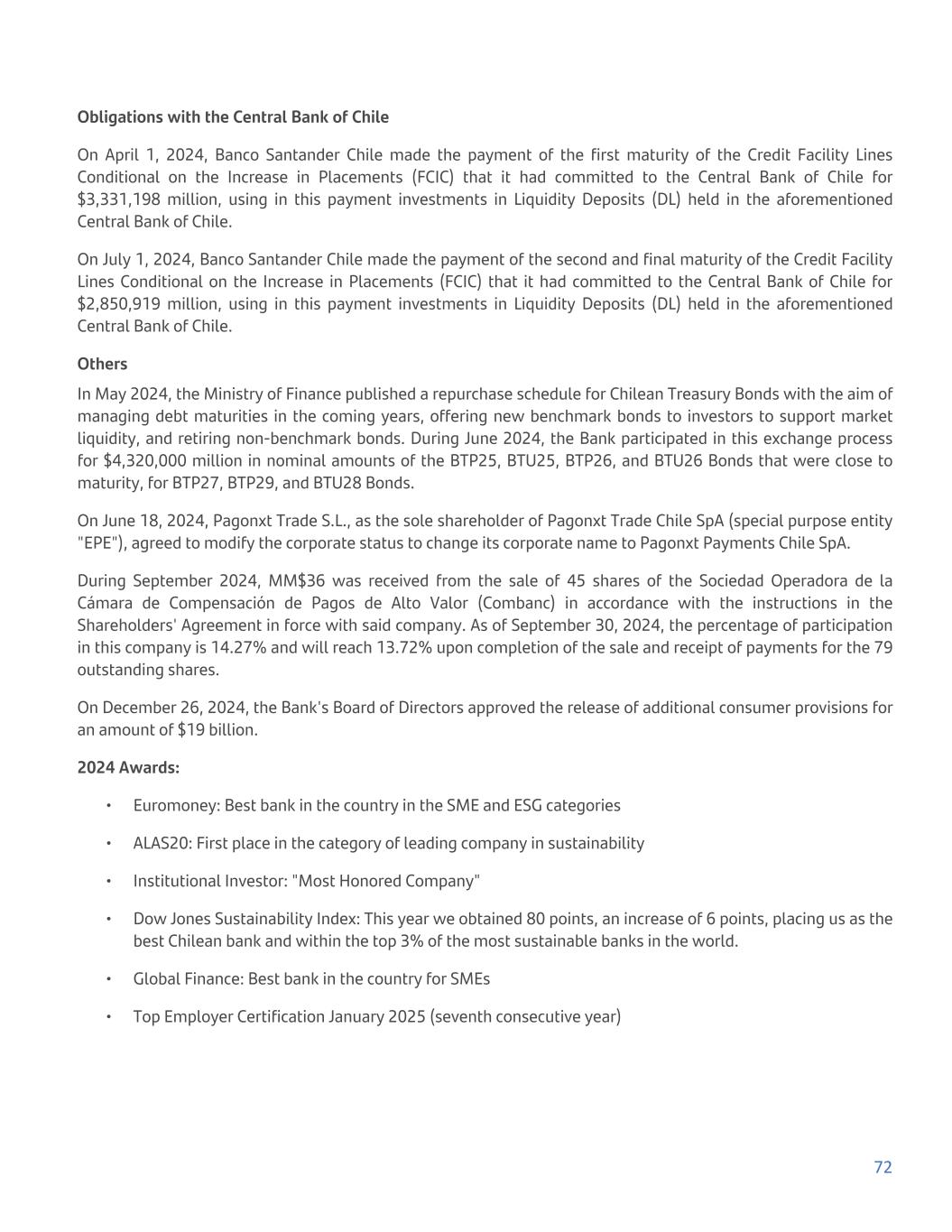
Obligations with the Central Bank of Chile On April 1, 2024, Banco Santander Chile made the payment of the first maturity of the Credit Facility Lines Conditional on the Increase in Placements (FCIC) that it had committed to the Central Bank of Chile for $3,331,198 million, using in this payment investments in Liquidity Deposits (DL) held in the aforementioned Central Bank of Chile. On July 1, 2024, Banco Santander Chile made the payment of the second and final maturity of the Credit Facility Lines Conditional on the Increase in Placements (FCIC) that it had committed to the Central Bank of Chile for $2,850,919 million, using in this payment investments in Liquidity Deposits (DL) held in the aforementioned Central Bank of Chile. Others In May 2024, the Ministry of Finance published a repurchase schedule for Chilean Treasury Bonds with the aim of managing debt maturities in the coming years, offering new benchmark bonds to investors to support market liquidity, and retiring non-benchmark bonds. During June 2024, the Bank participated in this exchange process for $4,320,000 million in nominal amounts of the BTP25, BTU25, BTP26, and BTU26 Bonds that were close to maturity, for BTP27, BTP29, and BTU28 Bonds. On June 18, 2024, Pagonxt Trade S.L., as the sole shareholder of Pagonxt Trade Chile SpA (special purpose entity "EPE"), agreed to modify the corporate status to change its corporate name to Pagonxt Payments Chile SpA. During September 2024, MM$36 was received from the sale of 45 shares of the Sociedad Operadora de la Cámara de Compensación de Pagos de Alto Valor (Combanc) in accordance with the instructions in the Shareholders' Agreement in force with said company. As of September 30, 2024, the percentage of participation in this company is 14.27% and will reach 13.72% upon completion of the sale and receipt of payments for the 79 outstanding shares. On December 26, 2024, the Bank's Board of Directors approved the release of additional consumer provisions for an amount of $19 billion. 2024 Awards: • Euromoney: Best bank in the country in the SME and ESG categories • ALAS20: First place in the category of leading company in sustainability • Institutional Investor: "Most Honored Company" • Dow Jones Sustainability Index: This year we obtained 80 points, an increase of 6 points, placing us as the best Chilean bank and within the top 3% of the most sustainable banks in the world. • Global Finance: Best bank in the country for SMEs • Top Employer Certification January 2025 (seventh consecutive year) 72
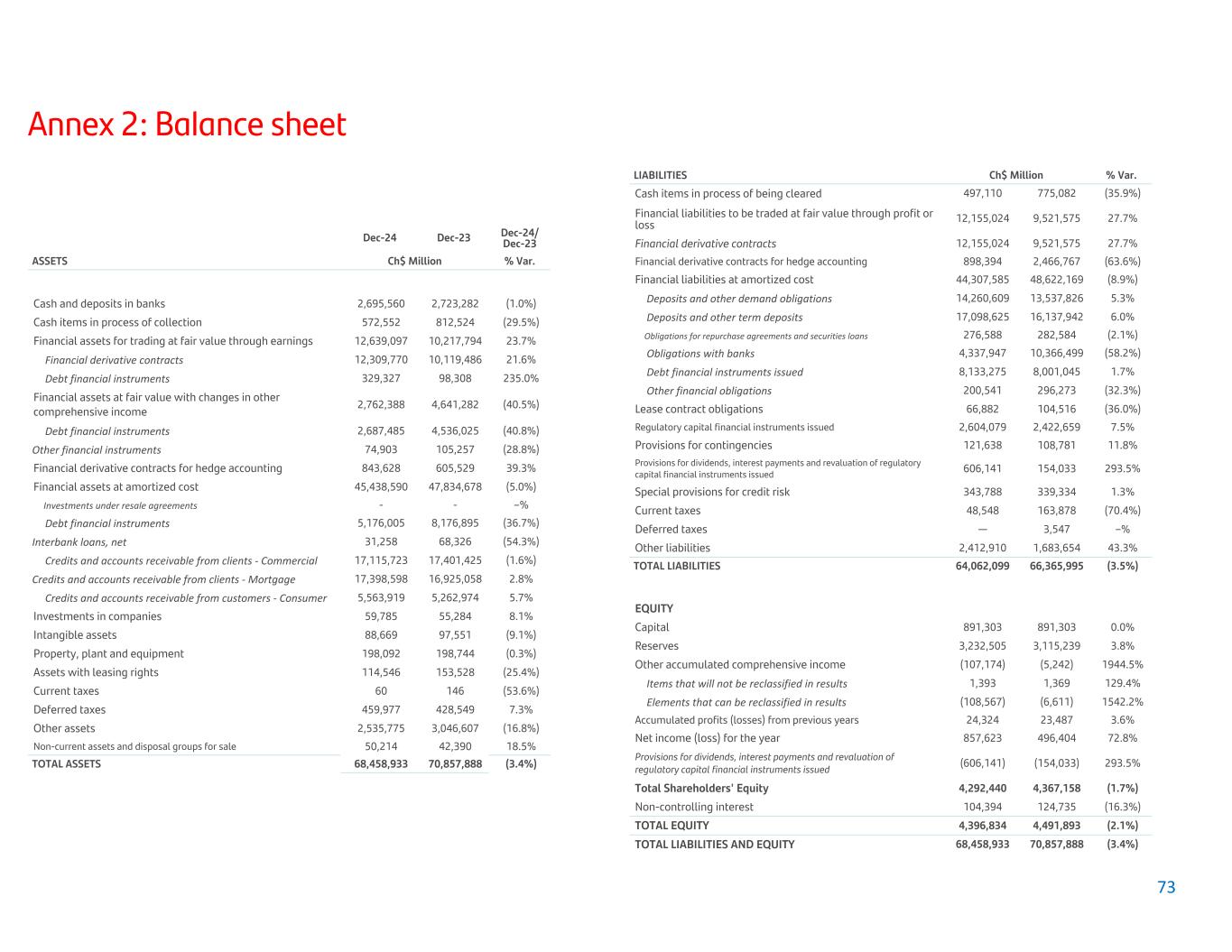
Annex 2: Balance sheet Dec-24 Dec-23 Dec-24/ Dec-23 ASSETS Ch$ Million % Var. Cash and deposits in banks 2,695,560 2,723,282 (1.0%) Cash items in process of collection 572,552 812,524 (29.5%) Financial assets for trading at fair value through earnings 12,639,097 10,217,794 23.7% Financial derivative contracts 12,309,770 10,119,486 21.6% Debt financial instruments 329,327 98,308 235.0% Financial assets at fair value with changes in other comprehensive income 2,762,388 4,641,282 (40.5%) Debt financial instruments 2,687,485 4,536,025 (40.8%) Other financial instruments 74,903 105,257 (28.8%) Financial derivative contracts for hedge accounting 843,628 605,529 39.3% Financial assets at amortized cost 45,438,590 47,834,678 (5.0%) Investments under resale agreements - - –% Debt financial instruments 5,176,005 8,176,895 (36.7%) Interbank loans, net 31,258 68,326 (54.3%) Credits and accounts receivable from clients - Commercial 17,115,723 17,401,425 (1.6%) Credits and accounts receivable from clients - Mortgage 17,398,598 16,925,058 2.8% Credits and accounts receivable from customers - Consumer 5,563,919 5,262,974 5.7% Investments in companies 59,785 55,284 8.1% Intangible assets 88,669 97,551 (9.1%) Property, plant and equipment 198,092 198,744 (0.3%) Assets with leasing rights 114,546 153,528 (25.4%) Current taxes 60 146 (53.6%) Deferred taxes 459,977 428,549 7.3% Other assets 2,535,775 3,046,607 (16.8%) Non-current assets and disposal groups for sale 50,214 42,390 18.5% TOTAL ASSETS 68,458,933 70,857,888 (3.4%) LIABILITIES Ch$ Million % Var. Cash items in process of being cleared 497,110 775,082 (35.9%) Financial liabilities to be traded at fair value through profit or loss 12,155,024 9,521,575 27.7% Financial derivative contracts 12,155,024 9,521,575 27.7% Financial derivative contracts for hedge accounting 898,394 2,466,767 (63.6%) Financial liabilities at amortized cost 44,307,585 48,622,169 (8.9%) Deposits and other demand obligations 14,260,609 13,537,826 5.3% Deposits and other term deposits 17,098,625 16,137,942 6.0% Obligations for repurchase agreements and securities loans 276,588 282,584 (2.1%) Obligations with banks 4,337,947 10,366,499 (58.2%) Debt financial instruments issued 8,133,275 8,001,045 1.7% Other financial obligations 200,541 296,273 (32.3%) Lease contract obligations 66,882 104,516 (36.0%) Regulatory capital financial instruments issued 2,604,079 2,422,659 7.5% Provisions for contingencies 121,638 108,781 11.8% Provisions for dividends, interest payments and revaluation of regulatory capital financial instruments issued 606,141 154,033 293.5% Special provisions for credit risk 343,788 339,334 1.3% Current taxes 48,548 163,878 (70.4%) Deferred taxes — 3,547 –% Other liabilities 2,412,910 1,683,654 43.3% TOTAL LIABILITIES 64,062,099 66,365,995 (3.5%) EQUITY Capital 891,303 891,303 0.0% Reserves 3,232,505 3,115,239 3.8% Other accumulated comprehensive income (107,174) (5,242) 1944.5% Items that will not be reclassified in results 1,393 1,369 129.4% Elements that can be reclassified in results (108,567) (6,611) 1542.2% Accumulated profits (losses) from previous years 24,324 23,487 3.6% Net income (loss) for the year 857,623 496,404 72.8% Provisions for dividends, interest payments and revaluation of regulatory capital financial instruments issued (606,141) (154,033) 293.5% Total Shareholders' Equity 4,292,440 4,367,158 (1.7%) Non-controlling interest 104,394 124,735 (16.3%) TOTAL EQUITY 4,396,834 4,491,893 (2.1%) TOTAL LIABILITIES AND EQUITY 68,458,933 70,857,888 (3.4%) 73
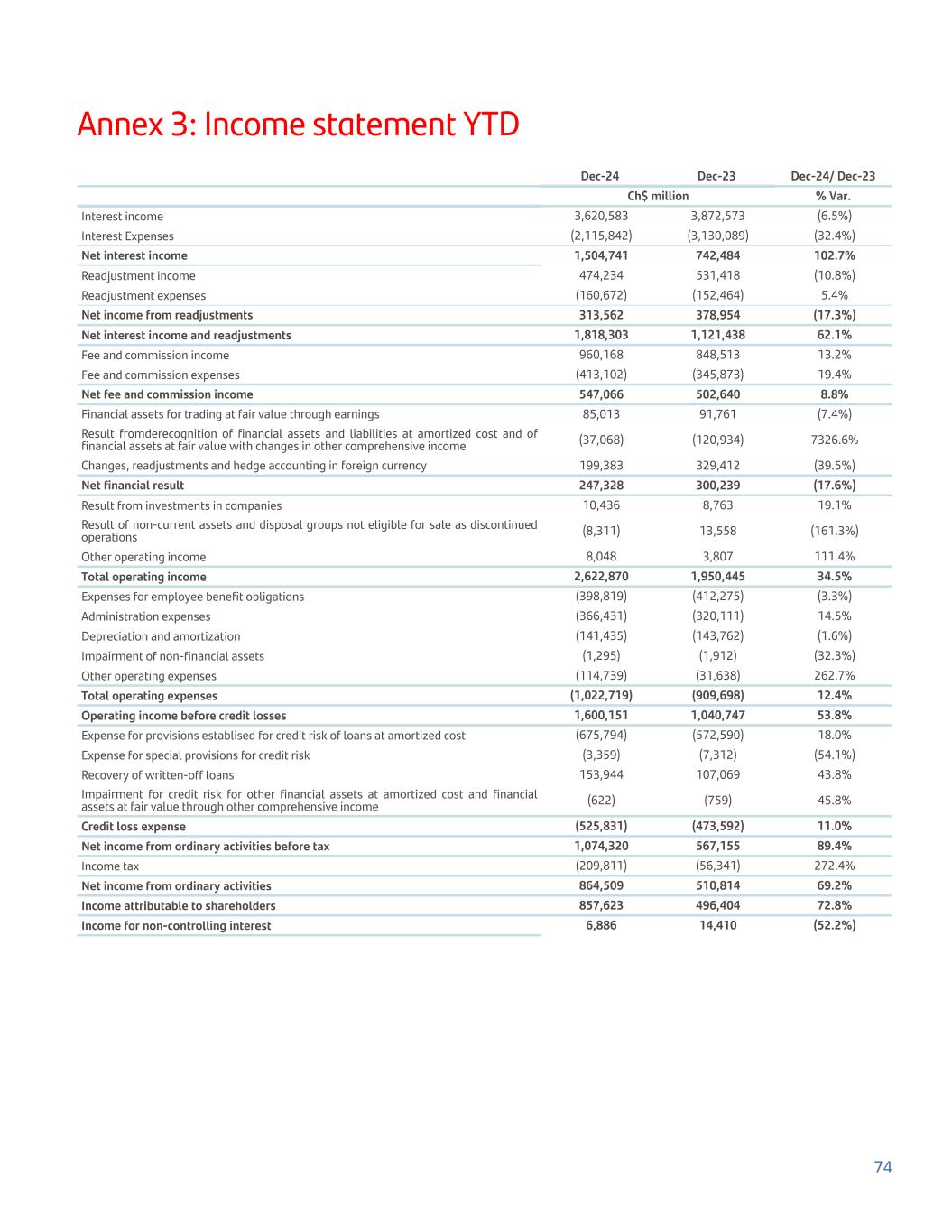
Annex 3: Income statement YTD Dec-24 Dec-23 Dec-24/ Dec-23 Ch$ million % Var. Interest income 3,620,583 3,872,573 (6.5%) Interest Expenses (2,115,842) (3,130,089) (32.4%) Net interest income 1,504,741 742,484 102.7% Readjustment income 474,234 531,418 (10.8%) Readjustment expenses (160,672) (152,464) 5.4% Net income from readjustments 313,562 378,954 (17.3%) Net interest income and readjustments 1,818,303 1,121,438 62.1% Fee and commission income 960,168 848,513 13.2% Fee and commission expenses (413,102) (345,873) 19.4% Net fee and commission income 547,066 502,640 8.8% Financial assets for trading at fair value through earnings 85,013 91,761 (7.4%) Result fromderecognition of financial assets and liabilities at amortized cost and of financial assets at fair value with changes in other comprehensive income (37,068) (120,934) 7326.6% Changes, readjustments and hedge accounting in foreign currency 199,383 329,412 (39.5%) Net financial result 247,328 300,239 (17.6%) Result from investments in companies 10,436 8,763 19.1% Result of non-current assets and disposal groups not eligible for sale as discontinued operations (8,311) 13,558 (161.3%) Other operating income 8,048 3,807 111.4% Total operating income 2,622,870 1,950,445 34.5% Expenses for employee benefit obligations (398,819) (412,275) (3.3%) Administration expenses (366,431) (320,111) 14.5% Depreciation and amortization (141,435) (143,762) (1.6%) Impairment of non-financial assets (1,295) (1,912) (32.3%) Other operating expenses (114,739) (31,638) 262.7% Total operating expenses (1,022,719) (909,698) 12.4% Operating income before credit losses 1,600,151 1,040,747 53.8% Expense for provisions establised for credit risk of loans at amortized cost (675,794) (572,590) 18.0% Expense for special provisions for credit risk (3,359) (7,312) (54.1%) Recovery of written-off loans 153,944 107,069 43.8% Impairment for credit risk for other financial assets at amortized cost and financial assets at fair value through other comprehensive income (622) (759) 45.8% Credit loss expense (525,831) (473,592) 11.0% Net income from ordinary activities before tax 1,074,320 567,155 89.4% Income tax (209,811) (56,341) 272.4% Net income from ordinary activities 864,509 510,814 69.2% Income attributable to shareholders 857,623 496,404 72.8% Income for non-controlling interest 6,886 14,410 (52.2%) 74

Annex 4: Quarterly income statement 4Q24 3Q24 4Q23 4Q24/4Q23 4Q24/3Q24 Ch$ million % Var. Interest income 872,542 884,368 1,012,962 (13.9%) (1.3%) Interest Expenses (449,053) (477,842) (761,148) (41.0%) (6.0%) Net interest income 423,489 406,526 251,814 68.2% 4.2% Readjustment income 154,007 109,420 179,628 (14.3%) 40.7% Readjustment expenses (56,774) (38,814) (52,155) 8.9% 991.5% Net income from readjustments 97,233 70,606 127,473 (23.7%) 37.7% Net interest income and readjustments 520,722 477,132 379,286 37.3% 9.1% Fee and commission income 251,910 244,135 218,446 15.3% 3.2% Fee and commission expenses (113,164) (97,839) (103,212) 9.6% 15.7% Net fee and commission income 138,747 146,296 115,234 20.4% (5.2%) Financial assets for trading at fair value through earnings 86,954 8,065 (8,943) (108.9%) (66.1%) Result fromderecognition of financial assets and liabilities at amortized cost and of financial assets at fair value with changes in other comprehensive income 3,645 4,607 (89,049) (104.1%) (2646.5%) Changes, readjustments and hedge accounting in foreign currency (23,751) 59,427 154,687 (115.4%) (140.0%) Net financial result 66,848 72,099 56,695 17.9% (7.3%) Result from investments in companies 3,958 2,268 2,357 67.9% 74.5% Result of non-current assets and disposal groups not eligible for sale as discontinued operations (4,848) (2,920) 2,176 14.7% 66.0% Other operating income 1,412 (181) 742 90.3% (21.3%) Total operating income 726,839 694,694 556,489 30.6% 4.6% Expenses for employee benefit obligations (100,431) (105,148) (95,465) 5.2% (4.5%) Administration expenses (90,412) (91,006) (92,611) (2.4%) (0.7%) Depreciation and amortization (35,723) (34,529) (36,472) (2.1%) 3.5% Impairment of non-financial assets (1,295) - (1,912) —% —% Other operating expenses (37,294) (21,295) (13,604) 174.1% 75.1% Total operating expenses (265,154) (251,978) (240,064) 10.5% 5.2% Operating income before credit losses 461,685 442,716 316,426 45.9% 4.3% Expense for provisions establised for credit risk of loans at amortized cost (177,287) (170,893) (150,254) 18.0% 3.7% Expense for special provisions for credit risk (2,960) (68) (2,521) 17.4% 4252.9% Recovery of written-off loans 49,011 34,027 31,643 54.9% 44.0% Impairment for credit risk for other financial assets at amortized cost and financial assets at fair value through other comprehensive income (1,076) 690 (178) 7.1% (255.9%) Credit loss expense (132,311) (136,244) (121,310) 9.1% (2.9%) Net income from ordinary activities before tax 329,373 306,472 195,115 68.8% 7.5% Income tax (55,675) (59,357) (18,538) (355.7%) (6.2%) Net income from ordinary activities 273,698 247,115 176,578 55.0% 10.8% Income attributable to shareholders 276,514 243,133 176,918 56.3% 13.7% Income for non-controlling interest (2,815) 3,982 (340) 727.9% (170.7%) 75
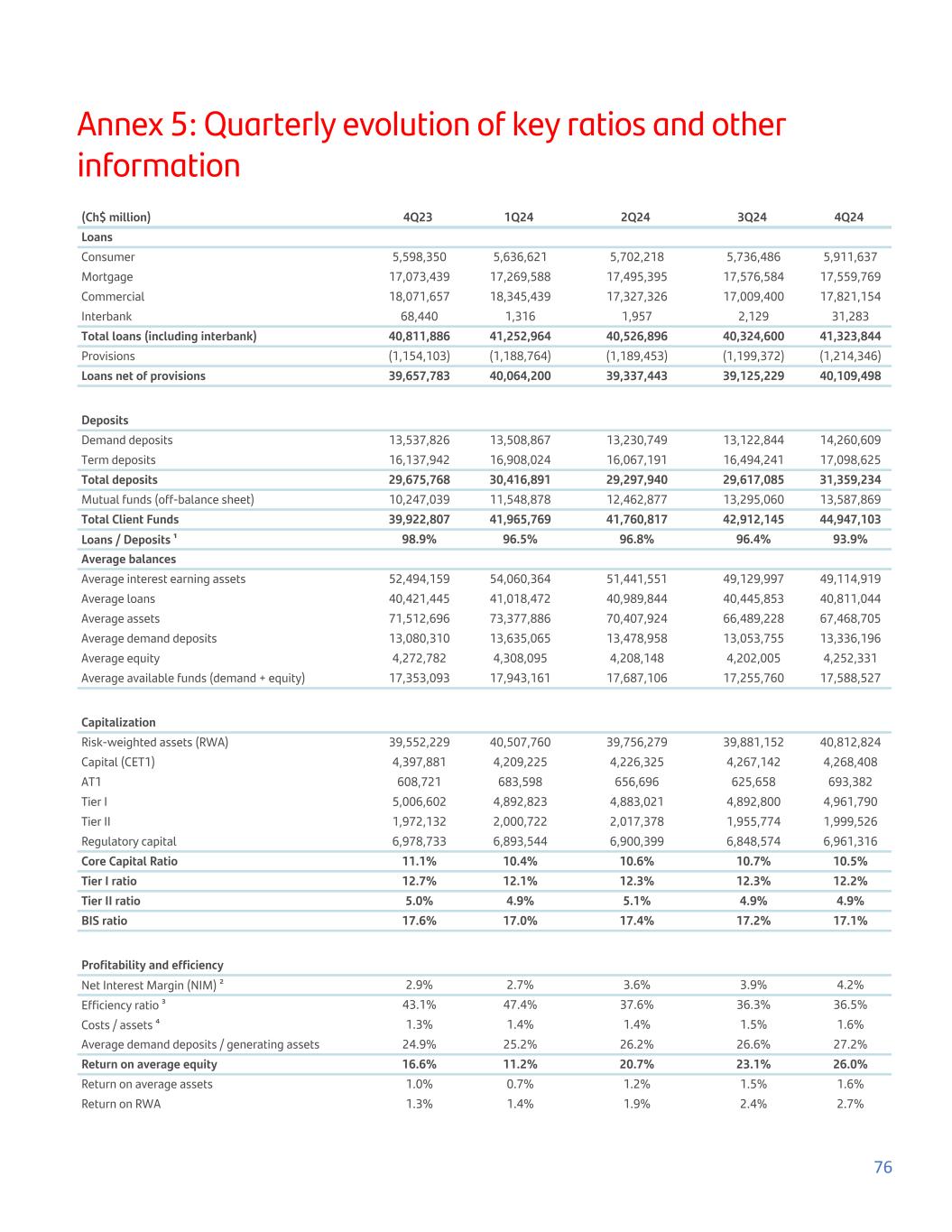
Annex 5: Quarterly evolution of key ratios and other information (Ch$ million) 4Q23 1Q24 2Q24 3Q24 4Q24 Loans Consumer 5,598,350 5,636,621 5,702,218 5,736,486 5,911,637 Mortgage 17,073,439 17,269,588 17,495,395 17,576,584 17,559,769 Commercial 18,071,657 18,345,439 17,327,326 17,009,400 17,821,154 Interbank 68,440 1,316 1,957 2,129 31,283 Total loans (including interbank) 40,811,886 41,252,964 40,526,896 40,324,600 41,323,844 Provisions (1,154,103) (1,188,764) (1,189,453) (1,199,372) (1,214,346) Loans net of provisions 39,657,783 40,064,200 39,337,443 39,125,229 40,109,498 Deposits Demand deposits 13,537,826 13,508,867 13,230,749 13,122,844 14,260,609 Term deposits 16,137,942 16,908,024 16,067,191 16,494,241 17,098,625 Total deposits 29,675,768 30,416,891 29,297,940 29,617,085 31,359,234 Mutual funds (off-balance sheet) 10,247,039 11,548,878 12,462,877 13,295,060 13,587,869 Total Client Funds 39,922,807 41,965,769 41,760,817 42,912,145 44,947,103 Loans / Deposits ¹ 98.9% 96.5% 96.8% 96.4% 93.9% Average balances Average interest earning assets 52,494,159 54,060,364 51,441,551 49,129,997 49,114,919 Average loans 40,421,445 41,018,472 40,989,844 40,445,853 40,811,044 Average assets 71,512,696 73,377,886 70,407,924 66,489,228 67,468,705 Average demand deposits 13,080,310 13,635,065 13,478,958 13,053,755 13,336,196 Average equity 4,272,782 4,308,095 4,208,148 4,202,005 4,252,331 Average available funds (demand + equity) 17,353,093 17,943,161 17,687,106 17,255,760 17,588,527 Capitalization Risk-weighted assets (RWA) 39,552,229 40,507,760 39,756,279 39,881,152 40,812,824 Capital (CET1) 4,397,881 4,209,225 4,226,325 4,267,142 4,268,408 AT1 608,721 683,598 656,696 625,658 693,382 Tier I 5,006,602 4,892,823 4,883,021 4,892,800 4,961,790 Tier II 1,972,132 2,000,722 2,017,378 1,955,774 1,999,526 Regulatory capital 6,978,733 6,893,544 6,900,399 6,848,574 6,961,316 Core Capital Ratio 11.1% 10.4% 10.6% 10.7% 10.5% Tier I ratio 12.7% 12.1% 12.3% 12.3% 12.2% Tier II ratio 5.0% 4.9% 5.1% 4.9% 4.9% BIS ratio 17.6% 17.0% 17.4% 17.2% 17.1% Profitability and efficiency Net Interest Margin (NIM) ² 2.9% 2.7% 3.6% 3.9% 4.2% Efficiency ratio ³ 43.1% 47.4% 37.6% 36.3% 36.5% Costs / assets ⁴ 1.3% 1.4% 1.4% 1.5% 1.6% Average demand deposits / generating assets 24.9% 25.2% 26.2% 26.6% 27.2% Return on average equity 16.6% 11.2% 20.7% 23.1% 26.0% Return on average assets 1.0% 0.7% 1.2% 1.5% 1.6% Return on RWA 1.3% 1.4% 1.9% 2.4% 2.7% 76
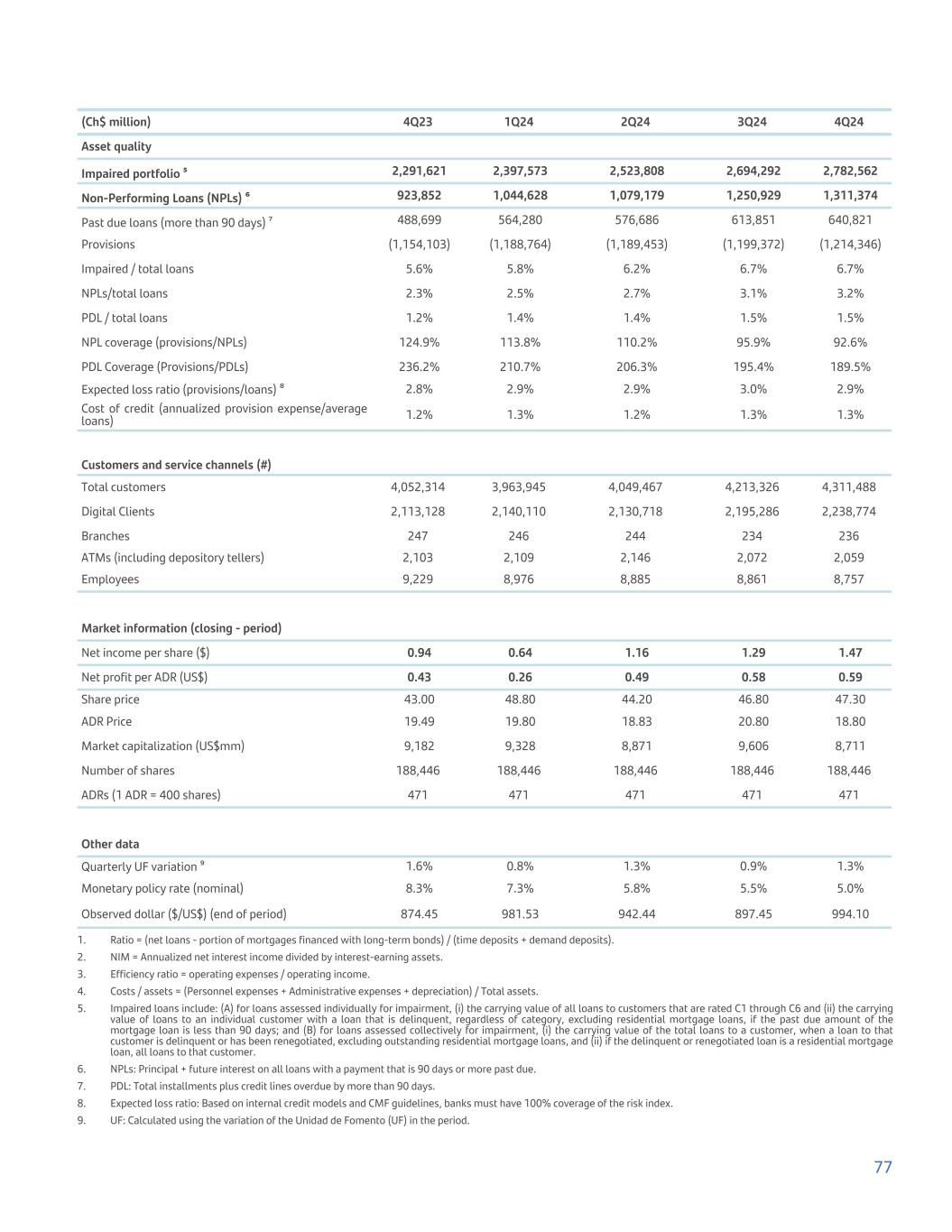
(Ch$ million) 4Q23 1Q24 2Q24 3Q24 4Q24 Asset quality Impaired portfolio ⁵ 2,291,621 2,397,573 2,523,808 2,694,292 2,782,562 Non-Performing Loans (NPLs) ⁶ 923,852 1,044,628 1,079,179 1,250,929 1,311,374 Past due loans (more than 90 days) ⁷ 488,699 564,280 576,686 613,851 640,821 Provisions (1,154,103) (1,188,764) (1,189,453) (1,199,372) (1,214,346) Impaired / total loans 5.6% 5.8% 6.2% 6.7% 6.7% NPLs/total loans 2.3% 2.5% 2.7% 3.1% 3.2% PDL / total loans 1.2% 1.4% 1.4% 1.5% 1.5% NPL coverage (provisions/NPLs) 124.9% 113.8% 110.2% 95.9% 92.6% PDL Coverage (Provisions/PDLs) 236.2% 210.7% 206.3% 195.4% 189.5% Expected loss ratio (provisions/loans) ⁸ 2.8% 2.9% 2.9% 3.0% 2.9% Cost of credit (annualized provision expense/average loans) 1.2% 1.3% 1.2% 1.3% 1.3% Customers and service channels (#) Total customers 4,052,314 3,963,945 4,049,467 4,213,326 4,311,488 Digital Clients 2,113,128 2,140,110 2,130,718 2,195,286 2,238,774 Branches 247 246 244 234 236 ATMs (including depository tellers) 2,103 2,109 2,146 2,072 2,059 Employees 9,229 8,976 8,885 8,861 8,757 Market information (closing - period) Net income per share ($) 0.94 0.64 1.16 1.29 1.47 Net profit per ADR (US$) 0.43 0.26 0.49 0.58 0.59 Share price 43.00 48.80 44.20 46.80 47.30 ADR Price 19.49 19.80 18.83 20.80 18.80 Market capitalization (US$mm) 9,182 9,328 8,871 9,606 8,711 Number of shares 188,446 188,446 188,446 188,446 188,446 ADRs (1 ADR = 400 shares) 471 471 471 471 471 Other data Quarterly UF variation ⁹ 1.6% 0.8% 1.3% 0.9% 1.3% Monetary policy rate (nominal) 8.3% 7.3% 5.8% 5.5% 5.0% Observed dollar ($/US$) (end of period) 874.45 981.53 942.44 897.45 994.10 1. Ratio = (net loans - portion of mortgages financed with long-term bonds) / (time deposits + demand deposits). 2. NIM = Annualized net interest income divided by interest-earning assets. 3. Efficiency ratio = operating expenses / operating income. 4. Costs / assets = (Personnel expenses + Administrative expenses + depreciation) / Total assets. 5. Impaired loans include: (A) for loans assessed individually for impairment, (i) the carrying value of all loans to customers that are rated C1 through C6 and (ii) the carrying value of loans to an individual customer with a loan that is delinquent, regardless of category, excluding residential mortgage loans, if the past due amount of the mortgage loan is less than 90 days; and (B) for loans assessed collectively for impairment, (i) the carrying value of the total loans to a customer, when a loan to that customer is delinquent or has been renegotiated, excluding outstanding residential mortgage loans, and (ii) if the delinquent or renegotiated loan is a residential mortgage loan, all loans to that customer. 6. NPLs: Principal + future interest on all loans with a payment that is 90 days or more past due. 7. PDL: Total installments plus credit lines overdue by more than 90 days. 8. Expected loss ratio: Based on internal credit models and CMF guidelines, banks must have 100% coverage of the risk index. 9. UF: Calculated using the variation of the Unidad de Fomento (UF) in the period. 77
